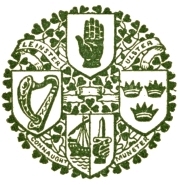*** START OF THE PROJECT GUTENBERG EBOOK 46439 ***
Every attempt has been made to replicate the original as printed.
In certain versions of this etext, in certain browsers,
clicking on this symbol  above the image, will bring up a larger version of the image.
above the image, will bring up a larger version of the image.
Contents
List of Illustrations
Index
(etext transcriber's note) |



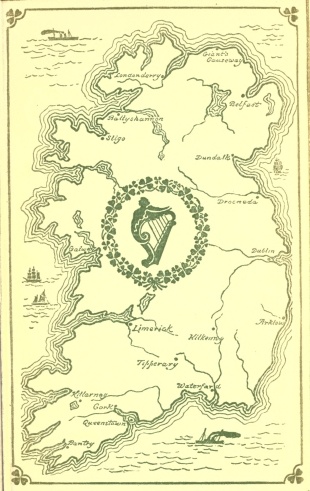
Romantic Ireland
Volume II.
Travel Lovers’ Library

Each in two volumes, profusely illustrated
| Florence | $3.00 |
| By Grant Allen |
| Romance and Teutonic Switzerland | 3.00 |
| By W. D. McCrackan |
| The Same.—Unillustrated | 1.50 |
| Old World Memories | 3.00 |
| By Edward Lowe Temple |
| Paris | 3.00 |
| By Grant Allen |
| Feudal and Modern Japan | 3.00 |
| By Arthur May Knapp |
| The Same.—Unillustrated | 1.50 |
| The Unchanging East | 3.00 |
| By Robert Barr |
| Venice | 3.00 |
| By Grant Allen |
| Gardens of the Caribbees | 3.00 |
| By Ida M. H. Starr |
| Belgium: Its Cities | 3.00 |
| By Grant Allen |
| Rome | net 2.40 |
| By Walter Taylor Field |
| Romantic Ireland | net 2.40 |
| By M. F. & B. McM. Mansfield |

L. C. PAGE & COMPANY
(INCORPORATED)
New England Building
Boston, Mass.

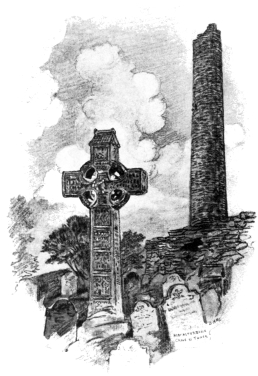
CROSS AND TOWER OF MONASTERBOICE.
(See page 259).
R O M A N T I C
I R E L A N D
By
M. F. and B. McM. Mansfield
IN TWO VOLUMES
Vol. II.
Illustrated by
BLANCHE McMANUS MANSFIELD
Boston
L. C. Page & Company
MDCCCCV
Copyright, 1904
By L. C. Page & Company
(INCORPORATED)
——
All rights reserved
Published October, 1904
COLONIAL PRESS
Electrotyped and Printed by C. H. Simonds & Co.
Boston, Mass., U. S. A.
Contents
Volume II.
| CHAPTER |
|
PAGE |
| I. | Queenstown, Cork, and Blarney | 1 |
| II. | Glengarriff and Bantry Bay | 39 |
| III. | Killarney and About There | 62 |
| IV. | Around the Coast of Limerick | 84 |
| V. | The Shannon and Its Lakes | 104 |
| VI. | Galway and Its Bay | 129 |
| VII. | Achill to Sligo | 161 |
| VIII. | The Donegal Highlands | 194 |
| IX. | Londonderry and the Giant’s Causeway | 207 |
| X. | Antrim and Down | 231 |
| XI. | The Boyne Valley | 248 |
| XII. | Belfast and Armagh | 290 |


List of Illustrations
Volume II.
| PAGE |
| Cross and Tower of Monasterboice (See page 259) | Frontispiece |
| Queenstown Harbour | 3 |
| Shandon Church Tower | 9 |
| Cork | 13 |
| An Old-style Irish Car | 19 |
| A Modern Irish Car | 23 |
| Blarney Castle | 31 |
| Gougane Barra | 35 |
| Bantry Bay | 41 |
| Glengarriff Bay | 51 |
| Hungry Hill | 55 |
| Killarney and About There | 63 |
| St. Finian’s Oratory, Innisfallen | 65 |
| On the Road from Cork to Kerry | 69 |
| Cloisters of Muckross Abbey | 73 |
| The Eagle’s Nest | 77 |
| Ross Castle | 81 |
| The Gap of Dunloe | 85 |
| The Black Valley | 89 |
| Valentia | 93 |
| The Skelligs Rocks | 97 |
| Limerick Castle | 101 |
| The Shannon and Its Lakes | 105 |
| Kincora | 107 |
| An Irish Piper | 111 |
| The Stone of the Divisions, Westmeath | 117 |
| Athlone Castle | 121 |
| Claddagh | 135 |
| Judge Lynch’s House, Galway | 141 |
| The Church of the Canons, Aran | 155 |
| Achill Island | 163 |
| Cathedral Caves, Achill | 171 |
| In Connemara | 175 |
| Kylemore Castle | 179 |
| Killary Harbour | 183 |
| A Detail of Sligo Abbey | 191 |
| Donegal Castle | 197 |
| Lake of Shadows, Donegal | 203 |
| Derry | 209 |
| The Honeycomb, Giant’s Causeway | 217 |
| Carrick-a-Rede | 227 |
| Grave of St. Patrick, Downpatrick | 241 |
| The Stone of Destiny, Tara | 255 |
| Trim | 261 |
| The Round Tower, Kells | 267 |
| The Cross of Kells | 271 |
| Crosses of Clonmacnois, Donegal, Slane,
and Moone Abbey | 275 |
| Holy Well, Kells | 279 |
{1}
Romantic Ireland
CHAPTER I.
QUEENSTOWN, CORK, AND BLARNEY
QUEENSTOWN has been called a mere appendage to its harbour, and, truly,
it is a case of the tail wagging the dog, though the residents of Cork
will tell you it is Cork Harbour, anyway, and Queenstown is nothing but
a town that was made by the American War of Independence, and by the
emigration rush that, during the past sixty years, has deprived Ireland
of more than half her population.
Be this as it may, the harbour dwarfs everything else about the town.
Above the enormous expanse of sheltered water, the little town piles
itself up on the overhanging cliffs,{2} pink houses, yellow houses, white
houses, like a veritable piece of Italy. It is always warm here, or
almost always. In the winter time, the temperature is seldom severe,
and, in the summer, it is one of the finest yachting centres in the
United Kingdom.
The “Beach” of Queenstown is truly Irish, since it is not a beach at
all, but a fenced street full of shops, occupying the place where a
narrow strand once ran.
Time was when Galway was a rival to Queenstown for the honour of being
the link which was, by the emigrant chain, to bind the Old World to the
New; but now the honour is Queenstown’s alone.
If tears,—the bitterest ever shed on earth, the hopeless tears of
lonely aged parents parting from their cherished offspring; of man’s
love leaving woman’s love thousands of miles behind across the seas; of
friend clasping the hand of friend perhaps for the last time; of
brothers and sisters parting from brothers and sisters, and all from the
land that the Irishman loves as he loves his own life,—if such tears as
these could quench the myriad of fairy lights that sparkle on the great
harbour at dusk,{3}

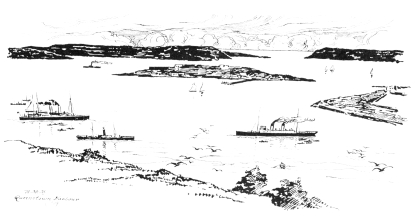
QUEENSTOWN HARBOUR.
{4}
{5}
Queenstown would doubtless be the darkest city in all the world.
Queenstown is drenched in tears; the air still quivers inaudibly with
the wailings that have filled it through day after day of half a century
or more of bitter partings. Thousands have left Ireland every year from
these quays, “the torn artery through which the country’s best blood
drains away year by year.” To see an emigrant-ship cast loose from the
quay and steam out of the harbour is a sight, once witnessed, that will
never be forgotten; that will haunt one’s very dreams in years to come.
Until 1849 Cove was the name of the city, but during a visit of Queen
Victoria here at that time, her first visit to Irish soil, the name was
changed, in her honour, to that which it now bears.
Cork Harbour, to most travellers, is little more than a memory; but, in
reality, it is one of those beautiful landlocked waterways which, for
sheer beauty and grandeur, is, in company with Bantry Bay and Dingle
Bay, which are less known, only comparable to the fiords of Norway. They
have not the majesty or expansiveness of many of the latter; but{6} they
have most of their attributes more subtly expressed. Indeed, Cork
Harbour and the river Lee, whose waters are in part enfolded by “the
third city of Ireland,” Cork (Corcaig, “a marshy place”), are
unapproachable in all the world for a certain subtle charm which is
perhaps inexpressible in words.
As the Lee divides and encircles the city, it well illustrates Spenser’s
lines:
“The spreading Lee that like an Island Fayre,
Encloseth Cork with his divided flood.”
Even the present-day aspect of Cork Harbour and the estuary of the river
Lee from the heights of Queenstown is one of the fairest blendings of
sea and shore anywhere to be seen.
Spike Island, with its convict establishment; Haulbowline, with its
naval establishment; Rocky Island, with its powder magazine; Crosshaven
Ring; and Rostellan Castle at once attract notice; and the eye roams
with pleasure over a charming scene, enlivened with shipping of all
kinds and from all ports, from the humble lugger to the steam-collier,
and, finally, the ocean leviathans, which, in our{7} strenuous times, have
become known as “record-breakers.”
Into Cork Harbour Sir Francis Drake retreated when hotly pursued by the
Spanish fleet. He was so effectually hidden in Carrigaline River, above
the village of Crosshaven, that the Spaniards spent several days in
fruitless search for him, and the spot is still known as Drake’s Pool.
About four miles away is the fort-defended entrance to this spacious
harbour. Old Ocean seems in some freakish humour to have struck his
broad palm against the barrier-strand, pushed his watery fingers into
the soil, and clutched at the rocks with his foam-white nails.
From its charming situation and equability of climate, Queenstown is one
of the best places in Ireland to encounter to their fulness the charms
of Ireland’s lovely daughters. This fact has been somewhat unduly
enlarged upon in the past, it is true, but theirs is a rare and gracious
beauty, and it is a general trait, so that there is a good excuse for
introducing the subject once again. Some are here with such a rosy
gladness; such an eglantine beauty-bloom; such dark hair and flashing
eyes, soul-stirring{8} and beaming with goodness; such a graceful mien and
frankness of manner, blended with a quiet reserve; and, altogether, such
a kindly air about them as to fully merit any eulogy which has been
bestowed upon Irish women. One is not surprised at their being addressed
by such mellifluous epithets as “Cushla machree, asthore, mavourneen!”
These are endearments which certainly sound appropriate to all, whatever
be the subtle shade of distinction.
Entrance to Cork via the river Lee gives prominence, first of all, to
Shandon’s square church tower, of whose bells sang Father Prout:
“The bells of Shandon, that sound so grand on
The pleasant waters of the River Lee.”
Shandon Church is, for itself, decidedly worth seeing, though by no
stretch of the imagination could it be called a beautiful structure. Up
a long hill and up two flights of stone steps, one climbs to the quiet
little old gray church, built in 1720, with its spiring tower and
sounding peal of eighteenth-century{9}

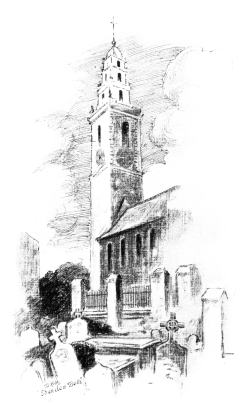
SHANDON CHURCH TOWER.
{10}
{11}
bells. Seventeen hundred and fifty is the date cast on each of the
eight.
St. Anne Shandon, or Sean-dun, signifying “the old fort,” is situated on
Shandon Hill, and is really a suburb of Cork. Its fame, in the minds of
most, reverts to Father Prout’s world-famous lyric, “The Bells of
Shandon.” If “in the mood,” the listener will experience much the same
emotions as are set forth in those pleasing stanzas. If not, as with
most other things which have been similarly eulogized, the traveller
will condemn it as mere hollow sentiment and “bosh.” But the latter
will, likely enough, not prove to be the case.
The church was erected on the site of the old Church of Our Lady, or St.
Mary Shandon, a very ancient edifice, destroyed at the burning of the
suburbs at the siege of Cork by Marlborough in 1690. In the decretal
epistles of Pope Innocent III., it is mentioned as the Church of St.
Mary in the Mountain. In 1536, the rector of St. Mary’s, one Dominick
Tyrrey, was elevated to the see of Cork, of which he was the first
Protestant bishop. The Rev. Francis Mahony (“Father Prout”), though he
spent much of his life abroad, is{12} buried in the churchyard in the
family vault at the foot of the tower.
The tower, or steeple, which contains the celebrated bells, is of unique
construction. It consists of a tower and lantern (170 feet high) of
three stories each. Two sides of the steeple, west and south, are built
of limestone, and two, north and east, of red stone.
The chime of bells itself does not take a high rank among
campanologists, since it is not very excellent either in voice or power.
Still, given certain conditions, one may well realize Mahony’s (Father
Prout’s) sentiments:
“With deep affection
And recollection
I often think on
Those Shandon bells,
Whose sound so wild would
In the days of childhood,
Fling round my cradle
Their magic spells.
“I have heard bells chiming
Full many a clime in,
Tolling sublime in
Cathedral shrine;
While at a glib rate
{13}

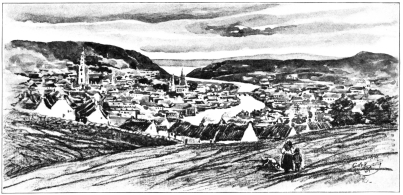
CORK.
{14}
{15}
Brass tongues would vibrate,
But all their music
Spoke nought like thine.”
In the little cemetery of the monastery of the Christian Brothers, near
by, rest the remains of Gerald Griffin, the novelist and poet, author of
“The Colleen Bawn.”
The history of Cork is too vast to chronicle here, but its interest lies
rather with the more or less fragmentary recollections, which all of us
have, of the traditions and legends of its environment.
In the ninth century Cork was frequently plundered by the Danes, who, in
1020, founded, for purposes of trade, the nucleus of the present city.
At the time of the English invasion it was the capital of Desmond, King
of Munster, who did homage to Henry II., and resigned the city to him.
For receiving Perkin Warbeck, the pretender to the throne of England,
with royal honours in 1493, the Mayor of Cork was hanged, and the city
lost its charter, which was, however, restored in 1609.
During the civil war, Cork held out for King Charles, but its garrison
was ultimately surprised and taken.{16}
When, in 1685, the bigoted and cruel Louis XIV. revoked the Edict of
Nantes, Cork, though a Catholic community, opened her friendly arms to
welcome the fugitive sons of France, and threw around them the mantle of
her protection.
The name of St. Finbarr, the first Bishop of Cork, is so commonly
referred to in connection with Southern Ireland that it is perhaps
allowable to extract and reprint here, from Butler’s “Lives of the
Saints,” the leading events of his life:
“Called by some St. Barrus, or Barrœus, he was a native of Connaught,
and instituted a monastery at Lough Eirc, which lake, said the
antiquarian Harris, was the hollowed basin in which the greater part of
the city of Cork now sits. From this monastery and its immediate
surroundings grew up the present city of Cork. St. Finbarr’s disciple,
St. Colman, founded the see of Cloyne, of which he became first bishop.
St. Nessan succeeded St. Finbarr at the monastery and built the town of
Cork. (This saint, too, is honoured, locally, on the 17th of March and
1st of December.)
“The name under which St. Finbarr was{17} baptized was Locahan, the surname
Finbarr, or Barr the White, was given to him afterward. He was Bishop of
Cork seventeen years, and died at Cloyne, fifteen miles distant. His
body was buried in his own cathedral at Cork, which bears his name, and
his reliques, some years after, were put in a silver shrine and
preserved in the same edifice.”
The Abbey of St. Finbarr was a veritable outpost of Christianity.
Dungarvan owes its name, and Waterford its Christianity, to Brother
Garvan of this abbey; while Brother Brian became the patron of St.
Brienne in France.
Cork University was a glorious institution in its time, and many who had
no prejudices in favour of Ireland have endorsed its virtues from the
times of Johnson to those of Newman, Hallam, and Macaulay.
After the fall of the Western Roman Empire the schools and the abbeys of
Ireland became famous. “Hither fled the timid for safety, and the
leisured for learning.” Students came from all lands and teachers went
out to all lands.
England’s Alfred came here to study, and{18} Charlemagne drew his teachers
from this “school of the West,” as it was afterward called by Johnson.
One ancient scrivener writes that at this period nearly all the learned
were under the influence of Ireland. The great universities of Oxford,
Paris, and Pavia, if not actually of Irish inception, were greatly
indebted to the learning which spread forth from the Green Isle. There
is scarcely a Continental centre of learning, from Palermo to Bruges, or
from Grenada to Cologne, where some Irish saint, patron, or monkish
scholar is not known and revered.
Cork should be endeared to Americans by reason of the association with
the city of two whose names will never be forgotten—William Penn, the
Quaker, and Father Mathew, the great temperance advocate.
In proof of the successful labours of the latter, a great writer of his
time stated that not a single instance of drunkenness came under his
observation during a sojourn of some weeks in Southern Ireland. It is a
happy change from the rollicking recklessness of the ould Ireland of
the fictionists and comic-song
{19}
{20}

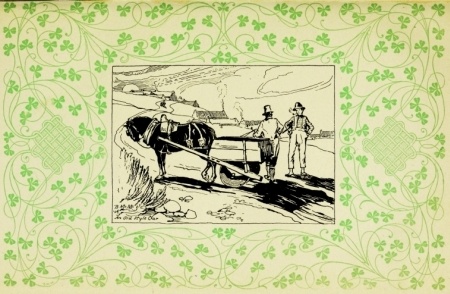
An Old-Style Irish Car
{21}
writers, which, let us hope, has gone for ever, if it ever existed.
Father Mathew is buried here, in St. Joseph’s Cemetery, and a bronze
statue to his memory stands in Patrick Street.
Cork is a picturesque and interesting old city. Its churches are mostly
modern; but St. Finbarr’s Cathedral stands on the site of a very old and
famous church, and is itself a fine building.
Cork is one of the principal places where the genuine Irish cloak is at
home, and most picturesque it is, though few of the younger women of
to-day affect it. For the most part, the girls wear the universal shawl,
draped over head and shoulders. The cloaks worn by the matrons and
elderly women are great full-length wraps of a black or dark-blue cloth,
with a wide hood. Rumour has it that they cost from five to ten pounds
apiece, and last, literally, from generation to generation, being
sometimes passed down as an heirloom from mother to daughter for half a
century. There is a factory for the manufacture of these capes at
Blarney, not far from the celebrated castle, and the product finds a
large sale among lady visitors who like to spin along the roads at{22}
thirty miles an hour, and feel it unbecoming to wear the hideous
motor-cap and mask of fashion.
Cork abounds in “cars” of all degrees of decrepitude and luxuriousness.
The Irish jaunting-car is much more a real accessory of Irish life than
the shillalah or the shamrock. In Wicklow one finds the cars more
numerous than elsewhere; in the west they are the most decrepit, and in
Dublin the most luxurious; but in Cork, of all centres of population,
they appear to be the most in use.
There has been considerable fun poked at them. They are certainly not
beautiful, comfortable, or magnificent, and their drivers, like the
“jarvies,” “cabbies,” and “cochers” of other lands, are a species apart
from all other humanity.
In some parts of the country it is compulsory that the name of its
owner, usually the driver, be legibly written on the tailboard of every
car. This led to the story which Punch, if it did not invent, at least
promulgated, that an inspector, who asked Pat what he meant by having
his name obliterated, was met with the reply: “Ye lie, sor; it’s
O’Brien.”
{23}
{24}

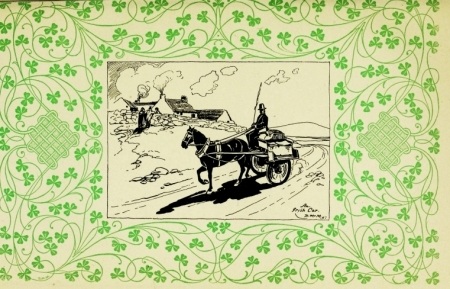
A Modern Irish Car
{25}
There are two distinct varieties of car in Ireland, quite apart from the
tourist caravans, char-à-bancs, and omnibuses in which visitors are
whirled between the beauty-spots of Erin’s leafy glades. The
characteristics of each are plainly noted in the “inside cars” of
Cork—practically extinct elsewhere—and the “outside cars.”
Seated in the indescribable native vehicle of Cork, which whirls one
through the town with unexpected lightness and speed, you converse with
the affable driver through a small hatchway, open in fine weather and
closed in wet, and flanked on each side by a glass port-hole. If you ask
for an explanation of the difference between the two varieties of cars,
the driver will most likely reply:
“The difference between the two cyars, is it? That’s simple, yer honour.
Sure, the outside cyar has the wheels inside, and the inside has them
outside, as ye see!”
Since Blarney, the castle, and the lake are practically a suburb of
Cork, they should be considered therewith. Blarney Castle—which is
situated, as the native says, “a long mile from the railway station”—is
of interest{26} more because it is an exceedingly good specimen of mediæval
castle building than because of the notoriety of what Father Prout was
pleased to call an “impudence-conferring” stone.
As a sentiment or superstition, the alleged incidents or circumstances
connected with the “Blarney Stone” are harmless enough; but far more
importance has been given to its rather negative charms than is really
justified.
Blarney Castle itself, with its surrounding “groves of Blarney which
look so charming,” and its real and tangible fabric, is of vastly
appealing interest; but, usually, it has faded into insignificance in
the eyes of those who contemplate the setting which has been given to
the all-powerful block of stone. The glib tongue of the native has done
much to perpetuate the tradition that whoever kisses it—and accompanies
the act with persuasive eloquence, so perceptible in all the folk around
about Cork Harbour—is for ever endowed with blessings innumerable, if
not actually with superhuman power.
The “real stone,” which bore the inscription, “Cormac MacCarthy Fortis
Mi Fieri{27} Fecit, A.D. 1446,” now untraceable, or at least illegible, was
at the north angle. It was clasped by two iron bars to a projecting
buttress at the top of the castle, several feet below the level of the
wall, so that, to perform the kissing feat in ancient times, it was
necessary to hold on by the bars, and project the body over the wall.
The candidate for Blarney honours to-day will find another “real stone,”
bearing the date 1703, and clasped by two iron bars, placed within the
tower, where it is quite accessible.
The “Reliques of Father Prout” contain this allusion to the “Stone:”
“There is a stone there,
That whoever kisses,
Oh! he never misses
To grow eloquent.
’Tis he may clamber
To a lady’s chamber,
Or become a member
Of Parliament.
“A clever spouter
He’ll sure turn out, or
An out and outer,
To be let alone!{28}
Don’t hope to hinder him
Or to bewilder him,
Sure he’s a pilgrim
From the Blarney Stone.”
The pleasure-grounds surrounding the castle, which were formerly adorned
with statues, grottoes, alcoves, bridges, and every description of
rustic ornament, are still very beautiful, although it is true that:
“The muses shed a tear,
When the cruel auctioneer,
With his hammer in his hand, to sweet Blarney came.”
And so their beauty has gradually diminished, and the fine old trees
have been felled, and one looks in vain for the statues of—
“The heathen gods,
And nymphs so fair,
Bold Neptune, Plutarch,
And Nicodemus,
All standing naked
In the open air.”
As Father Prout further says, the—
“ ... gravel walks there
For speculation
And conversation”—
{29}
are still in good order, and to wander in—
“The Groves of Blarney
. . . . . . . . . .
Down by the purling
Of sweet silent streams,”
and among the—
“ ... flowers that scent
The sweet fragrant air”—
is a most pleasant occupation for a summer’s afternoon.
Blarney Castle was built in the fifteenth century by Cormac MacCarthy,
and consists, to-day, of only the massive donjon tower, perhaps 120 feet
in height, and another lower portion, less substantial, though hardy
enough to warrant the conjecture that, before the introduction of
firearms, it must have been impregnable. It is almost as marvellous as
the power attributed to the Blarney Stone that a few lines of rather
cheap doggerel, containing in themselves no merit save their absurdity,
should succeed in gaining a world-wide notoriety for a place which,
otherwise, might not have been greatly celebrated beyond its own
neighbourhood.{30}
It is altogether incomprehensible to the writer that the real charm and
romance of this castle, standing up in its fifteenth-century sternness
amidst one of the greenest and most smiling districts in all green Erin,
have been so obscured, of late, by the popular and vulgar traditions
which are perpetuated in the horse-play of holding one another head
downwards over the battlements to “kiss the stone,” though this is no
longer really necessary, since another more conveniently placed stone
has been provided for the purpose. It is a procedure which creates much
excitement among a certain class of “trippers,” and, as it keeps a
certain amount of coin in circulation in the neighbourhood, it may be
accounted as a perfectly legitimate enterprise in that no actual harm is
done. What a pity it is, though, that Ireland has no commission for the
care of historical monuments, as has France!
Macroom, i. e., the Plain of Croom between Cork and Killarney, was
once the home and gathering-place of the famous song-bards of the
ancients, the druids.
Certainly the druids left a considerable impress upon Ireland, as they
did upon Wales{31}

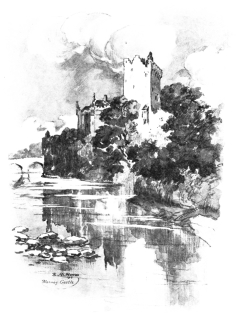
BLARNEY CASTLE.
{32}
{33}
and Bretagne; though it may be questioned to-day, in the light of the
latest information concerning the druidical race, if their strains of
melody actually did pale the cheek of beauty, or even “rise the
slumbering passion of the warrior to slaughter.”
Macroom, to-day, is chiefly famous for its castle. It was built by the
Carews in the time of King John, shortly after the Conquest, and was
subsequently in the possession of the MacCarthys. It was burned in the
rebellion of 1641. The huge square keep, now covered with ivy, is all
that remains of the original structure. Admiral Sir William Penn, father
of the founder of Pennsylvania, was born here. Macroom, the centre of
the sporting gentry of Muskerry, for whom this barony was always famous,
can also boast of a band of poets racy of the soil. In 1774, the poems
of John Connolly, a Macroom man, were published in Cork. He thus sings
the praises of his native town:
“Whoever means to shake off gloom
Let him repair to sweet Macroom,
For here his cares he will entomb
And think no more of sorrow.{34}
“Let Mallow yield to gay Macroom,
For here we know not care nor gloom,
Here nature wears perpetual bloom,
And quite dispels our sorrow.”
Near Macroom are the celebrated Inchigeela Lakes and the still more
celebrated island and lake of Gougane Barra, the retreat of St. Finbarr,
who had truly an eye for the beautiful and grand when he chose such a
site as this for his meditations.
On the verdant islet are the ruins of the little church, and the arched
praying-stations of the pilgrims to the shrine. A holy well is also
here, and its primitive materials and rude masonry indicate, at a
glance, the centuries that have passed since here dwelt the “Island
Saint” and anchorite, the founder of Cork. Of the many venerable
anchorites who afterward occupied the dwelling, and imitated the virtues
of St. Finbarr, the last was Father Denis O’Mahony, whose tomb, erected
by himself in 1700, is still to be seen.
Westward, near the border of the lake, is the “Green Valley of Desmond,”
enclosed by towering mountains, from the side of one of which,
“Nad-na-nillar” (the Eagle’s Nest),{35}

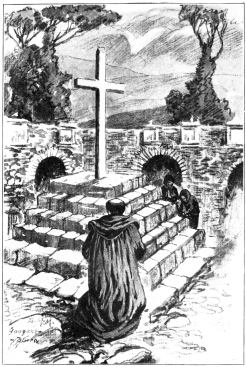
GOUGANE BARRA.
{36}
{37}
flows the tiny source of the river Lee, which runs through Cork to the
sea. Here one fully appreciates the appellation, “Lone Gougane Barra.”
Callanan, the native bard, has sung of it as follows:
“There is a green island in Lone Gougane Barra,
Where Allua of songs rushes forth as an arrow;
In deep-valleyed Desmond a thousand wild fountains
Come down to that lake from their home in the mountains.
There grows the wild ash, and a time-stricken willow
Looks chidingly down on the mirth of the billow,
As, like some gay child, that sad monitor scorning,
It lightly laughs back to the laugh of the morning.
And its zone of dark hills—oh! to see them all bright’ning
When the tempest flings out its red banner of lightning,
And the waters rush down, ’mid the thunder’s deep rattle,
Like clans from their hills at the voice of the battle.
And brightly the fire-crested billows are gleaming,
And wildly from Mullagh the eagles are screaming;
Oh, where is the dwelling in valley or highland
So meet for a bard as this lone little island!
. . . . . . .
. . . . . .
Least bard of the hills, were it mine to inherit
The fire of thy harp, and the wing of thy spirit,
With the wrongs which like thee to our country has bound me,{38}
Did your mantle of song fling its radiance around me.
Still, still in those wilds may young liberty rally,
And send her strong shout over mountains and valley,
The star of the west may yet rise in its glory
And the land that was darkest be brightest in story.
I, too, shall be gone, but my name shall be spoken
When Erin awakens, and her fetters are broken;
Some minstrel will come in the summer eve’s gleaming
When Freedom’s young light on his spirit is beaming,
And bend o’er my grave with a tear of emotion,
Where calm Avon Buee seeks the kisses of ocean,
Or plant a wild wreath from the banks of that river
O’er the heart and the harp that are sleeping for ever.”
{39}
CHAPTER II.
GLENGARRIFF AND BANTRY BAY
TWO of the most famous men in English literature have passed unstinted
praise on the beauty and charm of the southern Irish coast.
If one looks at a map of the southwest of Ireland, it will be seen that
its whole coast-line is broken into serrations, making harbours,
islands, bays, and coves. If he should go to the coast itself, he will
have revealed to him a wondrous kaleidoscope,—alternate scenes of
sweet, pathetic gentleness, and stern and rugged grandeur, all full of
engrossing charm.
Leaving the coast and going inland, as there is every facility for
doing, one finds the finest lakes in the United Kingdom; and, if there
are no Mont Blancs or Matterhorns, there are, at least, beautiful hills
and mountains with no less charm and none of their difficulty of{40}
access. The great Atlantic waves beat against the wild rocks of the
south Irish coast; but the Gulf Stream gives warmth of an almost
subtropical mildness to the fresh sea air, and the lowlands are enriched
by the soft rains which wash the hills and fall into the great arms of
the sea, called Bantry Bay, Kenmare River, and Dingle Bay.
Farther north is the ample estuary of the river Shannon and Galway Bay,
each with much the same characteristics. To take a steamer from Cork for
a tour of the southwest coast will form a unique experience in the
itinerary of most folk. Rounding Cape Clear, the small coasting-steamer
makes the first stop at the little village of Schull, which stands at
the farther extremity of an almost landlocked bay. Here the land on
three sides gently shelves to low ranges of verdant hills, while the
harbour is speckled with its fishing craft.
Leaving Schull, a half-hour or more is passed before we are clear of the
many rocky islands of its harbour and come to a view of Brow Head, with
its signal-station. Mizen Head and Sheep’s Head are seen in their turn;{41}

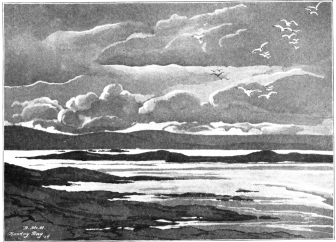
BANTRY BAY.
{42}
{43}
and the dawn finds the ship snugly anchored at Berehaven. Here at
Castletown-Berehaven we are at the home station of the Channel fleet
during the autumn manœuvres. Before us is the grand panorama of
Glengarriff and the mountains which shelter Killarney’s lakes; while
seaward is only the vast surge of the Atlantic.
The splendid bay of Bantry, which takes its name from the town which
lies sheltered at its head, is unsurpassed as a harbour and roadstead
throughout the world. Here the sturdy Atlantic swell, blue as sapphires,
rolls in great lashes of foam; and Berehaven, just inside the Bear or
Bere Island, is the base of the yearly autumn manœuvres of the
English Channel fleet. From any view-point this rugged, walled bay is
more than impressive,—more impressive, even, than Glengarriff itself,
which lies still farther inland, its circumference dotted with
weed-embroidered boulders. Bantry Bay is twenty-one miles in length;
from three to five in width; and has a depth, in parts, as great as 220
feet. Berehaven and Castletown, which are nearest the open sea, lie just
inside a jagged fang, which, once{44} rounded, opens up an obscure aperture
in the coast-line, and discloses a harbour in which, truly, all the
fleets of the world might lie at anchor.
Twice the French fleet invaded Bantry Bay. The first time, in 1689, in
aid of James II.; and the second, in 1796, by the ill-favoured
expedition organized by General Hoche, when the Surveillante was
engulfed, and the foe-laden fleet ultimately took their departure
without disgorging their army. This latter fleet, which had been arrayed
for the invasion of Ireland by Carnot and Clarke, with Theobald Wolfe
Tone as the organizer of the Irish Republicans, consisted of twenty-six
sail, with a force of nearly seven thousand men. The O’Sullivans were
the ancient chieftains or princes of this territory; and, to-day, quite
half the population of Castletown, says an imaginative and rollicking
Irish writer, are of the same name, the other half being Murphys.
As a result of this unfortunate venture, Wolfe Tone quit the country at
the pleasure of the authorities, and went to America. Ultimately he
returned to France, where he again{45} carried on his conspiracy, occupying
himself in luring Irishmen from among the prisoners at Brest to enlist
in the French service. This procedure was accomplished by “sending the
poor fellows large quantities of wine and cognac, a fiddle, and some
filles Francaises;” and, when Pat’s heart was soft with love and warm
with passion, Tone induced him to sign on in the service which had
adopted him.
It is difficult to characterize a man of Wolfe Tone’s kind. Rash and
criminal though he was, it is hard to condemn him altogether. He hated
England cordially; but he was not alone among Irishmen in that. Indeed,
he said: “I like the French, with all their faults and with the
guillotine at their head, a thousand times better than I like the
English.”
Whiddy Island, which lies just off the town of Bantry, was a former
stronghold of the O’Sullivans of Bere; and an imposing castled ruin
tells of the times when violence, even in such a spot as this, had to be
met by repression. Bantry lies in a hollow at the head of the bay. The
whole bay affords a succession of prospects magnificent and grand. Its
views vary from the softness of a landscape nocturne to{46} the rugged
splendour of a realistic impression. Weak as are these similes, they can
only mark the sense of contrast which the scene awakens. Bantry is in
its way an active little place, and, like Castletown, rejoices in a
series of sign-boards to which the prefix “O” is all but universal. Its
tiny port is busy; and its people are apparently imbued with an industry
not always to be noted in these parts.
Near Castletown-Bere is Dunboy Castle, two miles away along a road which
in summer is hedgerowed with honeysuckle and clematis, ferns and
lichen-covered rocks. The present castle of Dunboy is modern, and is
therefore less appealing than the older fabric, which so successfully
defended itself against Sir George Carew. The story of the chiefs of
Dunboy is familiar in outline to most; but the story of its famous
siege, when MacGeoghegan fought Dunboy against Carew and his interesting
army of four thousand men, has often been overlooked in favour of more
theatrically magnificent performances.
Why this should be so, it is hard to realize. History has recorded with
fidelity and minutely many of its incidents, and, in “The{47} Two Chiefs of
Dunboy,” it has inspired an historical romance of the first rank.
When Donal took his last farewell of his once proud home, it had become
a smoking, blood-clotted ruin.
“The halls where mirth and minstrelsy
Than Beara’s wind rose louder,
Were flung in masses lonelily,
And black with English powder.”
The tragic story of the siege is thus condensed: The garrison consisted
of only 143 chosen fighting men, who had but a few small cannons; while
the comparatively large army which assailed them was well supplied with
artillery and all the means of attack. At length, on the 17th of June,
when the castle had been nearly shot to pieces, the garrison offered to
surrender if allowed to depart with their arms; but their messenger was
immediately hanged, and the order for the assault given.
Although the proportion of the assailants in point of numbers was
overwhelming, the storming party were resisted with the most desperate
bravery. From turret to turret, and{48} in every part of the crumbling
ruins, the struggle was successively maintained throughout the livelong
day. Thirty of the gallant defenders attempted to escape by swimming;
but the soldiers, who had been posted in boats, killed them in the
water; and, at length, the surviving portion of the garrison retreated
into a cellar, to which the only access was by a narrow, winding flight
of stone steps. Their leader, MacGeoghegan, being mortally wounded, the
command was given to Thomas Taylor, the son of an Englishman, and the
intimate friend of Captain Tyrell, to whose niece he was married.
Nine barrels of gunpowder were stowed away in the cellar; and Taylor
declared that he would blow up all that remained of the castle, burying
himself and his companions, with their enemies, in the ruins, unless
they received a promise of life. This was refused by the savage Carew,
who, placing a guard upon the entrance to the cellar, as it was then
after sunset, returned to the work of slaughter next morning.
Cannon-balls were discharged among the Irish in their last dark retreat;
and Taylor was forced by his companions to surrender{49} unconditionally.
When, however, some of the English descended into the cellar, they found
the wounded MacGeoghegan, with a lighted torch in his hand, staggering
to throw it into the gunpowder. Captain Power thereupon seized him by
the arms, and the others despatched him with their swords. Fifty-eight
of those who had surrendered were hanged that day in the English camp,
and others a few days after; so that not one of the 143 heroic defenders
of Dunboy survived. On the 22d of June the remains of the castle were
blown up by Carew with the gunpowder of the besieged.
It was Thackeray, who, if possessed of a certain smugness, was often
moved by patriotic and sometimes by charitable motives, said:
“What sends picturesque tourists (What, if you please, Mr. Thackeray,
are picturesque tourists?) to the Rhine or Saxon Switzerland, when,
within five miles of the pretty inn at Glengarriff, there is a country
of the magnificence of which no pen can give an idea? I would like to be
a great prince, and bring a train of painters over to make, if they
could, and according to their several capabilities, a{50} set of pictures
of the place. Were such a bay lying upon English shores, it would be the
world’s wonder.”
Glengarriff is all that Thackeray pictured it in prose. It is more than
that,—more, indeed, than is within the power of words to describe,
though its beauty is somewhat of the stage-scenery and
landscape-painting order.
Travellers from all the corners of the earth have raved over its charm;
but they all fail utterly to describe the insinuating peacefulness of
its mirrored sky and emerald-clad hills. No one but the artist can at
all successfully portray its moods: at times brilliant with sunshine and
verdure, and again, sombre and mist-laden with the rains of autumn; but
never, or seldom ever, even in the most abnormal winter, bare or bleak.
Indeed, this region, together with many others in Ireland, has been, by
many eminent scientists, proclaimed one of nature’s most famous
sanitoria.
Prince Puckler Muskau, in his tour of Ireland, wrote thus of
Glengarriff: “The climate is most favourable for vegetation, moist and
so warm that not only azaleas and rhododendra, and all sorts of
evergreens stand{51}

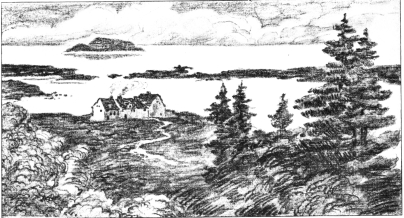
GLENGARRIFF BAY.
{52}
{53}
abroad through the winter, but, in favourable aspect, even camellias,
dates, pomegranates, magnolias, etc., attain their fullest beauty.” Lord
Macaulay and Sir David Wilkie called it the fairest spot in the British
Isles.
The former’s stanzas, as given below, are perhaps not of his usual
heroic order, and may, once and again, appear unduly sentimental, but
they are emphatically true and appreciative:
“Hail, charming scene! Glengarriff’s bay,
Yon mountains, streams, and dells,
The Atlantic waters’ foaming spray,
Creation’s wonder tells.
“Hail, Bantry’s noble harbour deep,
Where Britain’s fleet may ride,
And giant ships, in safety’s keep,
May in or outward glide.
“Thy glorious waters, green and gemmed,
With beauteous islands crowned,
While the enchanting scene is hemmed
With purple hills around.
“At morning’s dawn or evening’s shade
Thy glory’s still the same:
And ever will be so arrayed,
With English tourists’ fame.”
{54}
An enthusiastic American, who subscribed himself as from New Jersey, has
left the following lines upon the register of the hotel at Glengarriff:
ADIEU TO GLENGARRIFF
“Glengarriff! on thy shaded shore
I’ve wandered when the sun was high,
Have seen the moonlit showers pour
Through thy umbrageous canopy:
. . . . . . . . . .
Glengarriff! might I but delay,
. . . . . . . . . .
I would not say good-bye to thee:
Alas! far distant is the day
When I thy charms again may see.
Yet, in the land remote of mine,
Remembrance will thy grace renew,
So, as thou canst not call me thine,
Glengarriff! loveliest, best, adieu!”
This valleyed and landlocked harbour of Glengarriff terminates Bantry
Bay, which, says Mr. Kipling, “lies just to the eastward of the Fastnet,
that well-worn mile-post of the Atlantic liner.”
In Kipling’s “Fleet in Being,” which first appeared in the Morning
Post (London) in{55}

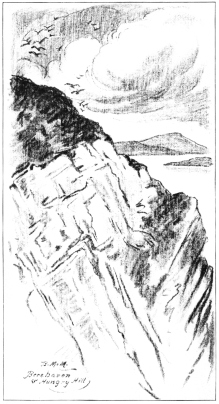
HUNGRY HILL.
{56}
{57}
1898, and of which even this author’s most ardent devotees appear too
frequently to have no knowledge, are to be found some wonderful bits of
descriptions of Irish coast scenery. Therein are recounted virile
experiences and observations on board the flag-ship of the Channel fleet
during the autumn manœuvres; and, from Lough Swilly in the north to
Bantry Bay in the south, the author depicts, with a master mariner’s
fidelity, the characteristics of the coast-line,—its harbours, bays,
headlands, and ports,—in so incomparable a fashion that it is to him
that we must accord the rapidly increasing appreciation of, and interest
in, the charms of Ireland as a tourist resort.
Coupled with the charms of Glengarriff’s bay is its sister
attraction—no less winsome—of the monarch mountain of these parts,
Sliabhna-goil (i. e., “the Mountain of the Wild People”), more
commonly called “Sugar Loaf.” Why it is so named is, of course, obvious
to all who see it; but it is a rank departure from its original
appellation.
This mountain’s taller brother Dhade (now Hungry Hill) rears itself in
grim severity a{58} little to the westward. Both are conspicuously
coast-line elevations of the first rank.
Time will allow but a glance at the many beauties of this region; but
the leaves of memory will press the fragments of romance, in an
all-enduring fashion, to all who come immediately beneath their spell.
One legend, repeated here from a source well known, must suffice. It
refers to the mountain pass of Keim-an-eigh, “the path of the deer,”
through which, according to M’Carthy’s “Bridal of the Year,” and in
reality, too:
“Streams go bounding in their gladness
With a Bacchanalian madness.”
M’Carthy has put the legend into elegant verse, known of all lovers of
Irish song as “Alice and Una.”
Briefly the tale runs thus: A young huntsman, Maurice by name, had all
day pursued a fawn, which at evening fled for refuge—
“To a little grassy lawn—
It is safe, for gentle Alice to her saving breast hath drawn
Her almost sister fawn.”
{59}
A romantic affection then sprang up between the two humans, the hunter
and the maid; and this magnet drew the youth often hither, in spite of
the fact that Una, a fairy queen, was passionately enamoured of the
gallant deer-chaser. One evening, as he was wending his way to see his
lady fair, the moon grew dark, a great storm arose, and the lovelorn
Maurice lost himself in the wood. All this was of course due to the
jealous fairy in true legendary fashion. At length he falls in with a
noble jet-black steed, which he mounts. This grim shape proves to be a
certain dreaded Phooka (the same symbol is renowned throughout Ireland,
and has been traced even to the legends of the Northmen), a genii of
Una’s, who immediately rushes off with the youth through glen and
valley, stream and forest, up and down the mountain sides:
“Now he rises o’er Bearhaven, where he hangeth like a raven—
Ah! Maurice, though no craven, how terrible for thee!
To see the misty shading of the mighty mountains fading,
And thy winged fire-steed wading through the clouds as through a sea!{60}
Now he feels the earth beneath him—he is loosened—he is free,
And asleep in Keim-an-eigh.”
In his trance-dream he hears the rumble of crashing thunder. The rock
opens and displays within a scene of revelry and joy, to which a page
bids him welcome, and ushers him through a brilliant assemblage to the
very throne of the Queen-fairy Una. She smiles graciously upon him;
urges him to leave the world and all its woes to become one of her happy
subjects; and promises him that, if he will but take the oath of
allegiance, she herself will deign to be his bride. Spellbound by such
an appeal, his lips are all but ready to utter the irrevocable vow.
“While the word is there abiding, lo! the crowd is now dividing,
And, with sweet and gentle gliding, in before him came a fawn;
It was the same that fled him, and that seemed so much to dread him,
When it down in triumph led him to Glengarriff’s grassy lawn,
When from rock to rock descending, to sweet Alice he was drawn,
As through Keim-an-eigh he hunted from the dawn.”{61}
“The magic chain is broken—no fairy vow is spoken—
From his trance he hath awoken, and once again is free;
And gone is Una’s palace, and vain the wild steed’s malice,
And again to gentle Alice down he wends through Keim-an-eigh.
The moon is calmly shining over mountain, stream, and tree,
And the yellow sea-plants glisten through the sea.
. . . . . . .
. . . . . .
“The sun his gold is flinging, the happy birds are singing,
And bells are gaily ringing along Glengarriff’s sea;
And crowds in many a galley to the happy marriage rally
Of the maiden of the valley and the youth of Keim-an-eigh;
Old eyes with joy are weeping, as all ask, on bended knee,
A blessing, gentle Alice, upon thee.”
{62}
CHAPTER III.
KILLARNEY AND ABOUT THERE
KILLARNEY is a considerable town, rather prim and staid and too
offensively well kept to be wholly appealing. It is by no means handsome
of itself, nor are its public buildings.
The chief industry is catering, in one form or another, to the largely
increasing number of tourists who are constantly flocking thither.
The value of Killarney, as a name of sentimental and romantic interest,
lies in its association with its lakes and the abounding wealth of
natural beauties around about it.
Torc Mountain and waterfall, Muckross, Cloghereen, the Gap of Dunloe and
its castle, the upper, middle, and lower lakes, Purple Mountain, Black
Valley, Eagle’s Nest, and Innisfallen are all names with which to call
up ever living memories of the fairies of legend{63}

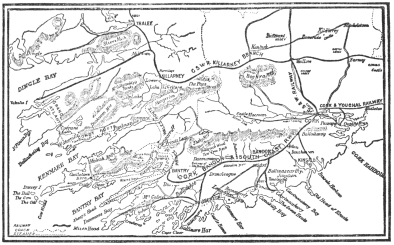
KILLARNEY AND ABOUT THERE
{64}
and folk-lore, and of the more real personages of history and romance.
To recount them all, or even to categorically enumerate them, would be
impossible here.
There is but one way to encompass them in a manner at all satisfactory,
and that is to make Killarney a centre, and radiate one’s journeys
therefrom for as extended a period as circumstances will allow. The
guide-books set forth the attractions and the ways and means in the
usual conventional manner, but it is useless to expect any real help
from them.
The true gem of Killarney’s many charms is without question Lough Leane
and Innisfallen (Monk’s Robe Island), which lies embosomed in the lower
lake.
Yeats, the Irish poet, spent the full force of his lyric genius in the
verses which he wrote with this entrancing isle for their motive.
Robert Louis Stevenson is reported to have said that, of all modern
poets, none has struck the responsive chord of imagination as did this
sweet singer with the following lines:
“And I shall have some peace there,
For peace comes dropping slow,
Dropping from the veils of the morning
{65}

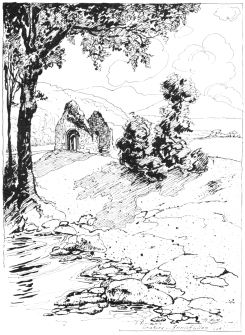
ST. FINIAN’S ORATORY, INNISFALLEN.
{66}
{67}
To where the cricket sings;
There midnight’s all a glimmer
And noon a purple glow,
And evening full of the linnet’s wings.
“I will arise and go now,
For always, night or day,
I hear lake water lapping,
With low sounds by the shore;
While I stand on the roadway,
Or on the pavements gray,
I hear it in the deep heart’s core.”
Moore’s description is perhaps as appropriate, but it is no more
beautiful:
“Sweet Innisfallen, fare thee well,
May calm and sunshine long be thine!
How fair thou art let others tell,—
To feel how fair shall long be mine.”
From Glengarriff to Killarney via Kenmare is a long-drawn sweetness of
prospect, which it is perhaps impossible to duplicate for its
sentimental charm,—an ability to appreciate which belongs to us all,
even if only to a limited extent.
The road from County Cork to County Kerry—and one journeys only by road
from Bantry Bay to Dingle Bay, via Kenmare and{68} Killarney, the age of
steam not yet having arrived at these parts—winds fascinatingly up and
down hill and dale, diving suddenly through a tunnelled rock, when a
transformation takes place, and one leaves the ruggedness and freshness
of Bantry Bay for the more or less humid fairy-land of the region about
Killarney. The view ahead is peculiarly grand in its contrast with that
left behind. Down the beetling precipices along which the road is
clinging to its sterile sides, one traces the valley beneath until it
blends with the silvery surface of Kenmare River. From Kenmare, the way
to Killarney is by the “Windy Gap.” Beneath lies an extensive valley,
and beyond is the Black Valley. Farther on are the skylines of the
mountains which encompass the wild and dark Gap of Dunloe; and, farther
still, will be observed the more jagged outlines of “MacGillicuddy’s
Reeks.” Soon one beholds the first view of the beauties of far-famed
Killarney, the immense valley in which repose the three lakes,—the
upper, lower, and middle, with their numerous islets. En route from
Kenmare to Killarney, one first comes to Muckross Abbey and Demesne, of
which{69}

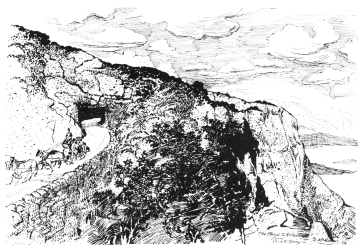
ON THE ROAD FROM CORK TO KERRY.
{70}
{71}
Sir Walter Scott has said: “Art could make another Versailles; it could
not make another Muckross.” This is characteristic of Sir Walter and his
fine sentiment; but, as Muckross is suggestive of nothing ever heard or
thought of at Versailles, the comparison is truly odious.
Muckross is charming. It is thoroughly Irish; and reeks of the native
soil and its people, wherein is its value to the traveller.
The scenery around about Muckross is very beautiful, but its ruined
abbey is the great architectural relic of all Ireland. The ruins consist
of the abbey and church, which was founded for the Order of Franciscans
by McCarthy Mor, Prince of Desmond, in 1340, on the site of an old
church which, in 1192, had been destroyed by fire. The remains of
several of this prince’s descendants are said to rest here. In the choir
is the vault of the ancient Irish sept., the McCarthys, the memory of
whom is preserved by a rude sculptured monument. Here also rest the
remains of the Irish chieftains or princes of the houses of O’Sullivan
Mor and the O’Donoghue. The great beauty of these ruins lies in its
gloomy cloisters, which are rendered still more gloomy{72} by the close
proximity of a magnificent yew-tree of immense size and bulk.
Killarney’s lakes are irregular sheets of water lying in a basin at the
foot of a very high range of mountains, set with islands and begirt with
rocky and wooded heights. They are three in number; what is known as the
upper, the middle or Muckross Lake, and the lower lake,—the
northernmost,—more properly called Lough Leane. The middle lake is also
called the Torc. A winding stream, known as the Long Range, unites the
different bodies of water. The chief of the natural beauties of the Long
Range is the Eagle’s Nest, which rises sheer from the water’s edge 1,700
feet. The upper lake is the most beautiful of all, though the smallest
of the triad. It is studded with tiny islands and girt with mountain
peaks, bare and stern above, but clothed with rich foliage at their
base. The middle lake is also a beautiful, though more extensive, sheet,
and contains but four islands, as compared with thirty in the lower lake
and six in the upper.
The Colleen Bawn Caves—reminiscent of Gerald Griffin’s story, “The
Colleen Bawn,”
{73}
{74}

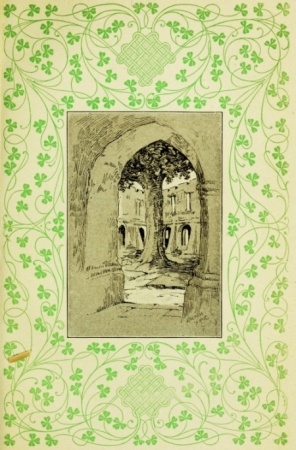
Cloisters of Muckross Abbey
{75}
and Boucicault’s famous play of the same name—are also in the immediate
neighbourhood of the middle lake. Torc Cascade and Torc Mountain lies
just to the southward, and is justly famed as one of the brilliant
beauties of the region, as it falls in numerous sections over the broken
rock to fall finally in a precipitous torrent of foam to its ravine-bed
below.
Ross Castle, like Muckross Abbey, is one of Killarney’s chief
picturesque ruins. It is on an island in the lower lake, and was built
ages agone by the O’Donoghues. It was the last castle in Munster to
surrender in the wars of the seventeenth century, giving in only when
General Ludlow and his “ships-of-war,” as his narrative called them,
surrounded it. MacGillicuddy’s Reeks lie farthest to the westward in the
Killarney region. The name of this stern and jagged range sounds
somewhat humourous, and in no way suggests the majesty and splendour of
these hills; for they resemble the great mountains of other parts only
by reason of their contrast with the low-lying land around their bases.
One portion, indeed, rises a matter of 3,400 feet, and forms the most
elevated peak in Ireland, grand and{76} majestic, but, for all that, not a
great mountain, as is so often claimed by the proud native. The
celebrated Gap of Dunloe is far more deserving for its natural scenic
splendour, and, in its way, rivals anything in Ireland.
The popular method of imbibing the charm of Dunloe is a combination of
picnic, al fresco luncheons, and donkey-riding. This answers well
enough for the “tripper,” but is as unsatisfying to the real lover of
nature as an imitation Swiss châlet set out in a London park, or a
Japanese tea-garden built out of bamboo poles from Africa.
The Gap of Dunloe is a grand defile, perhaps five miles in length, which
can only be explored and truly enjoyed by a pilgrimage along its
solitary and rugged road on foot. Its scenic aspect is gloomy and grand,
with mirrored lakes, lofty mountains, and a thick undergrowth of heather
and ivy. It is, however, in no manner theatrical. Through this wild glen
ripples the river Lee, linking its five tiny lakes as with a silver
thread.
At the upper end of the gap one emerges into “The Black Valley,”
somewhat apocryphally{77}

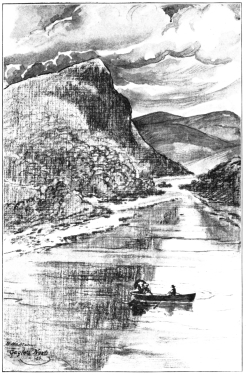
THE EAGLE’S NEST.
{78}
{79}
stated to be “a gloomy, depressing ravine.”
The sun, it appears, does not shine down its length for long in the day,
as it is flanked on either side by precipitous hills. The average
imagination will not, however, conjure up any very dark suspicions with
regard to its past, judging from the aspect of the valley between the
hours of nine in the morning and two in the afternoon. Both before and
after these hours there is no sunlight; and, because of the dense,
long-reaching shadows which are projected across it, it was so named.
There is a good week’s rambling here to spots already famed in history
for their beauty; but one must search them out for himself as a personal
experience.
England’s poet laureate has written in praise of Killarney in a fashion
which should please his severest critics, those who have mourned the
lack of a single thought in his verse. This is certainly not true with
regard to his prose, which, in the following lines, so justly and
appropriately describes the charm of South-west Ireland:
“Vegetation, at once robust and graceful,{80} is but the fringe and
decoration of that enchanting district. The tender grace of wood and
water is set in a framework of hills,—now stern, now ineffably gentle;
now dimpling with smiles, now frowning and rugged with impending storm;
now muffled and mysterious with mist, only to gaze out on you again with
clear and candid sunshine. Here the trout leaps, there the eagle soars;
and there, beyond, the wild deer dash through the arbutus coverts,
through which they have come to the margin of the lake to drink, and,
scared by your footstep or your oar, are away back to the crosiered
bracken or heather-covered moorland. But the first, the final, the
deepest and most enduring impression of Killarney is that of beauty
unspeakably tender, which puts on at times a garb of grandeur and a look
of awe, only in order to heighten by passing contrast the sense of soft,
insinuating loveliness. How the missel-thrushes sing, as well they may!
How the streams and runnels gurgle and leap and laugh! For the sound of
journeying water is never out of your ears; the feeling of the moist,
the fresh, the vernal is never out of your heart.... There is nothing in
England{81}

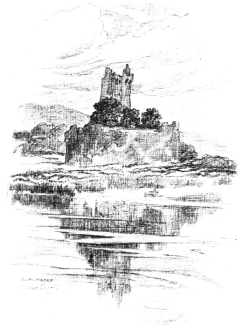
ROSS CASTLE
{82}
{83}
or Scotland as beautiful as Killarney; ... and, if mountain, wood, and
water, harmoniously blent, constitute the most perfect and adequate
loveliness that nature presents, it surely must be owned that it has,
all the world over, no superior.”{84}
CHAPTER IV.
AROUND THE COAST TO LIMERICK
IT is at Fastnet that the great incoming Atlantic liners, bound for
Queenstown, or through St. George’s Channel to Liverpool, first make
land and run up their four-deep strings of signals; where, as Mr.
Kipling says:
“Every day brings a ship,
Every ship brings a word;
Well for him who has no fear,
Looking seaward, well assured
That the word the vessel brings
Is the word that he should hear.”
Beyond Bantry Bay, Black Bull Head passes on the starboard, and, soon
after, Dursly Head and Dursly Island. The island is said to contain a
population of over five hundred, with no priest, no public house, and no
constabulary. A veritable Arcadia!{85}

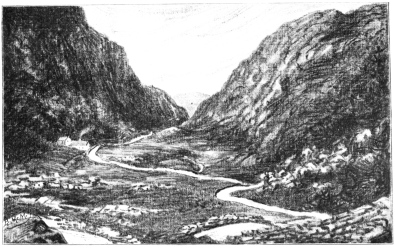
THE GAP OF DUNLOE.
{86}
{87}
Bolus Head, Skelligs Rocks, and Bray Head passed, one comes to Valentia
Island and the entrance to Dingle Bay. One of the most fondly recalled
of all Irish legends is that of the landing of the Milesians, as they
came up through the Biscayan Bay upon what they then knew as “Innis
Ealga”—the Noble Isle. Then it was ruled by three brothers, princes of
Tuatha de Danaan, after whose wives (who were also three sisters) the
island was alternately called, Eire, Banva, and Fiola. By these names
Ireland is still frequently known to the poets. Whatever difficulties or
obstacles beset the Milesians in landing, they at once attributed to the
“necromancy” of the Tuatha de Danaans. When the Milesians could not
discover land where they thought to sight it, they simply agreed that
the Tuatha de Danaans had, by their black arts, rendered it invisible.
At length they descried the island, its tall blue hills touched by the
last beams of the setting sun; and from the galleys there arose a shout
of joy. Innisfail, the Isle of Destiny, was found!
The legend has furnished Moore the excuse{88} for launching into melody
again. He relates it as follows:
“They came from a land beyond the sea,
And now o’er the western main
Set sail, in their good ships, gallantly,
From the sunny land of Spain.
‘Oh, where is the isle we’ve seen in dreams,
Our destin’d home or grave?’
Thus sung they, as by the morning’s beams,
They swept the Atlantic wave.
“And lo, where afar o’er ocean shines
A sparkle of radiant green,
As though in that deep lay emerald mines,
Whose light through the wave was seen,
‘ ’Tis Innisfail—’tis Innisfail!’
Rings o’er the echoing sea,
While bending to heav’n the warriors hail
That home of the brave and free.”
Valentia—the most westerly railway-station in Europe, says Bradshaw—is
the true spot where West meets East; where the New World first receives
its introduction to the Old.
More than half a century ago, the shores of this spacious sheet of
landlocked water were selected by the great Duke of Wellington and
others as the terminus of a railway which was to be the first link in
the chain which was{89}

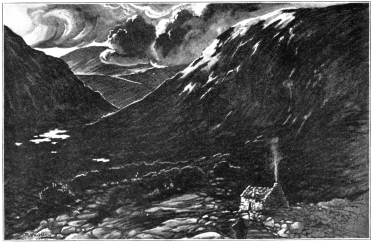
THE BLACK VALLEY.
{90}
{91}
to bind the Old World and the New, and to join the ocean liners that
were run from America to Valentia, as they now do to Queenstown. The
project fell through, but the island was afterward selected as the
old-world end of the Atlantic cable of 1865, and also that laid by the
leviathan steamship, the Great Eastern, in 1866. The principal village
on the island is called Knightstown. If favoured with a fresh westerly
breeze, one beholds from the hillside a scene of grandeur unsurpassed.
The ocean engages in conflict with the rugged headlands rising hundreds
of feet out of the sea, and hurls its foaming breakers with ceaseless
rhythm against the base of the rocks, only to be rolled back in spray
and foam. All outside is a scene of wild magnificence, while, such is
the perfect shelter, the harbour itself, under all stress of weather, is
as placid as a summer lake. Lord John Manners, in his notes of a tour
through Ireland, describes the Atlantic here as follows:
“The great waves came in with a roar like a peal of artillery, and leapt
up against and over the rocks just below us, sending forth a rainbow in
one direction, and an immense{92} jet of foam in another. I do not believe
I exaggerate in saying that some of the jets of foam sprung a hundred
feet into the air, and then the tints! Sometimes a clear green wave
would roll its huge volume on the rocks before it broke; at others, dash
greenly up to it and dissolve in wreaths of purest white spray, causing,
as it broke, a delicate iris to glow on the opposite rocks; while toward
the west a veil of foam overhung the coast, lighted up by the golden
rays of the setting sun. No words can describe the fascination of the
scene.”
To observe the contrast between nature and the works of man, one has
only to visit the isolated premises of the Anglo-American Telegraph
Company. The manner in which electricity outstrips the sun in his daily
round is here strikingly exemplified. Happening to be in the
instrument-room at about eleven o’clock in the forenoon, one sees the
operators at work, receiving from, say, Berlin, the reports of the day’s
markets, and transmitting the information to New York, to be served up
fresh on Uncle Sam’s breakfast-table, which, even at that early hour is
already old news in the Eastern{93}

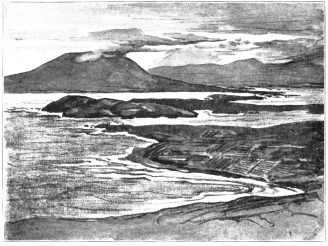
VALENTIA.
{94}
{95}
world. Lying just inside Valentia Island is Cahirciveen, the birthplace
of Daniel O’Connell, and from this point to Dingle, across the bay, is
to be seen—though from the seaward side only—the finest rock scenery
on the southwest coast. Here Nature seems to have done her best to
produce the picturesque with ocean and rock, twisted and split, pierced
and tunnelled; every rock seems to have been torn in some gigantic
struggle against total destruction, and left to still wage war against
storm and tempest. The harbour of Dingle, landlocked and peaceful, is in
quiet contrast to all this turmoil, though Dingle’s weekly cattle fair
will give the stranger the impression that he is witnessing something
very akin to the fabled Donnybrook Fair, so far as riotous good humour
is concerned.
From Slea Head a magnificent view of Dingle Bay is obtained,—its
indented shores flanked by the Dingle mountains stretching away for
thirty miles of wonderful panorama of islands and rocks out to and
around the Blasquetts. The Blasquetts are a group of eight rocky
islands, two of them three miles from the coast. In the sound between
these{96} two and the mainland one of the ships of the Spanish Armada sank
with all on board.
Perhaps the wildest scene on the southern coast is presented by the
Skelligs Rocks, off Dingle Bay, rising as pinnacles of slate, wind-swept
and bare. The cliffs seem painted in bands of cream colour, produced by
countless crowds of gannets—most powerful of gulls—sitting on their
nests on the ledges of cliff. At the sound of an approaching steamer,
the air is filled with a swarm of puffins, or sea-parrots, which fly
heavily around the crags; while, from the caves on the lower cliffs,
like crowds of the smaller gulls fill the air with their shrill,
screaming cry.
Limerick is a city which, by very reason of her great past and her
matter-of-fact and decidedly ordinary present, presents great and
disappointing contrasts. One may read the statistics in the guide-books
and learn that 350,000 pigs are killed every year in the town, and of a
great many other mundane things which happen here and have no interest
whatsoever for him.
There is no doubt about the pigs, sausages, and various pork products,
for fat swine,{97}

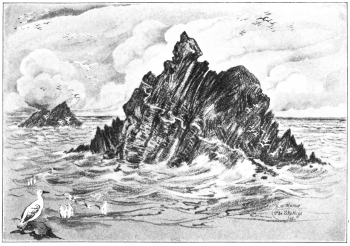
THE SKELLIGS ROCKS.
{98}
{99}
“razorbacks,” big pigs, and little pigs swarm everywhere.
There is no escaping the Limerick pig. In single file, in battalions, as
solitary scout, alive or dead, baconed and sausaged, he dominates the
town. Limerick was in existence as long ago as the days of Ptolemy; was
scrambled for by the Danes and the Irish kings in Alfred’s time; took
the fancy of that good judge of “eligible sites,” King John, and was
decorated with one of his innumerable castles, a fine old relic which
still remains. The town was in the very thick of the row raised by
Cromwell; and, in the wars of “the silent” William of Orange, it
manufactured history as fast as its factories turn out sausages now. The
name of Sarsfield, the Jacobite general, is for ever identified with
Limerick. The city was taken and retaken more often than we should care
to state; it was—and is—fortified up to the very limit; and, whenever
anything exciting of a political nature went on, in times past, Limerick
was ever to the fore front, ready to emphasize her opinions with the
high-shouldered fat little cannon that have somehow got left out on the
ramparts, quite{100} forgotten except by “tourist touts,” though, truth to
tell, not many tourists ever come to Limerick.
To-day Limerick—in spite of its activities with respect to sausages—is
no more a maker of history, but sits dozing complacently on the estuary
of “the finest river in the kingdoms,” and cares not apparently for the
comings and goings of the outside world.
As some poetic soul—possessed by an Irishman of course—has said: “No
one cares for Limerick now. Of all the fierce possessors who fought for
her when she was young, the local government officially alone remains,
like the gray elderly husband of some housewifely woman who was a beauty
and a ‘toast,’ and made men’s swords leap from their scabbards for love
of her—once.”
At the mouth of the Shannon, near where its tidal waters meet the sea,
Limerick has its “fashionable watering-place” of the conventional
pattern. The chief “amusement” of this delectable place appears to be
the gathering of “Irish moss,” as it is commonly known. Here they call
it “Carrageen moss,” but it is the same thing, and ultimately turns{101}

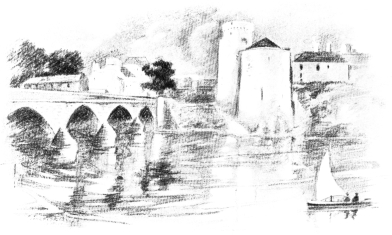
LIMERICK CASTLE.
{102}
{103}
up as a dainty and nourishing jelly. The peasantry gather it for profit,
the visitors for pastime. It is found in many shallow rock pools at low
tide, and grows in short, bushy tufts, coralline in shape. The “moss”
must be bleached in the sun, and then boiled down into jelly. “Dulse,”
another variety of edible seaweed, which requires no preparation, is
also found here; and the central ribs of young oarweed are peeled and
eaten like celery, which they very much resemble in looks, but—most
emphatically—not in taste.
Dear also, to Americans, will be the memory of County Limerick as the
birthplace of Fitz-James O’Brien. The son of an attorney, he was born in
1828, receiving his education at Dublin University. In his youth he saw
service as a British soldier, but early drifted toward journalism and
America.
Among his earliest compositions were two remarkable poems, “Loch Ine”
and “Irish Castles,” which present in a picturesque vocabulary many of
the salient charms and beauties of his native isle.{104}
CHAPTER V.
THE SHANNON AND ITS LAKES
NO river in Great Britain, neither the Thames, nor the Clyde, nor even
the Severn, equals the river Shannon and its lakes, either in length or
in importance as an inland waterway. The native on its banks tells you
that it rivals the Mississippi; but in what respect, Americans, at
least, will wonder. Except that it broadens to perhaps a dozen miles in
the widest of its lakes, there is, of course, no comparison whatever.
The traffic on the river is of no great magnitude compared with that on
the Thames and the Clyde; but, were there a demand for such, its
capacity would be far greater than either.
Moreover, for beauty, either of the dainty and popularly picturesque
sort, or of the supremely grand, it has preëminence, and one can journey
its whole length, from Killaloe,{105}

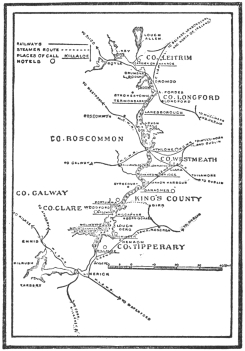
THE SHANNON AND ITS LAKES
{106}
practically a suburb of Limerick, to Carrick-on-Shannon, something over
a hundred miles, in steamboats of really comfortable, if not exactly
luxurious, appointments.
It is the tourist traffic mostly that is catered for; and the traveller,
in the season, is likely to find the company mixed, though by no means
is it of the “tripper” class.
The itinerary comprehends much that is beautiful and much that is
historic.
From Limerick, one usually makes his way by train, although he may go by
car or coach,—such a trip is well worth while,—and embarks upon the
tiny steamer at Killaloe.
Here, at the lower end of Lough Derg, near Killaloe, stood in the ninth
century Brian Boru’s palace of Kincora. The mound on which it was built
is all that remains of a place that displayed, twelve hundred years ago,
the greatest glory of the proud Irish kings.
Many were the events of historical moment which took place here, though,
as a palace of great splendour and magnitude, it may have been exceeded
by Tara and Emania.
The memory of Brian Boru’s life here{107}

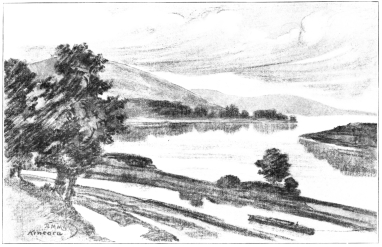
KINCORA.
{108}
{109}
places him in the annals of the world’s great rulers as “every inch a
king.”
Neither on the Irish throne, nor on that of any other kingdom, did there
ever sit a sovereign more splendidly qualified to rule; and Ireland had
not for some centuries known such a glorious and prosperous, peaceful,
and happy time as the five years preceding Brian’s death. He caused his
authority to be not only unquestioned, but obeyed and respected in every
corner of the land. So justly were the laws administered in his name,
and so loyally obeyed throughout the kingdom, that the bards relate a
rather fanciful story of a young and exquisitely beautiful lady, who
made, without the slightest apprehension of violence or insult, and in
perfect safety, a tour of the island on foot, alone and unprotected,
though bearing about her the most costly jewels and ornaments of gold.
This legend will be further recalled by the memory of the well-known
verses beginning “Rich and rare were the gems she wore.”
It was at Kincora that the following incident took place:
{110}Mælmurra, Prince of Leinster, playing or advising on a game of chess,
made or recommended a false move, upon which the patriotic Morrogh, son
of Brian, observed that it was no wonder Mælmurra’s friends, the Danes
(to whom he owed his elevation), were beaten at Glenmana, if he gave
them advice like that. Mælmurra, highly incensed by the allusion,—all
the more severe for its bitter truth,—arose, ordered his horse, and
rode away in haste. Brian, when he heard it, despatched a messenger
after the indignant guest, begging him to return; but Mælmurra was not
to be pacified, and refused, and concerted and connived with certain
Danish agents, always open to such negotiations, those measures which
led to the great invasion of the year 1014, in which the whole
Scandinavian race, from Anglesea and Man, north to Norway, bore an
active part.
While Brian was residing at Kincora, news was brought of his
noble-hearted brother’s death, whereupon he was seized with the most
violent grief. Brian’s favourite harp—always a legendary and
traditional symbol of Irish emotions—was taken down, and he sang that
famous death-song of Mahon,{111}
{112}
{113}

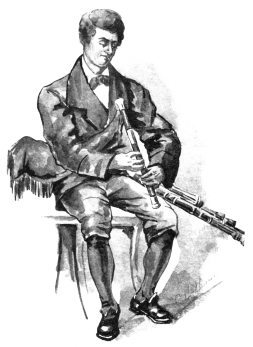
AN IRISH PIPER.
recounting all the glorious actions of his life. “His anger flashed out
through his tears as he wildly chanted the noble lines,” say the
chronicles.
“My heart shall burst within my breast,
Unless I avenge this great king.
They shall forfeit life for this foul deed,
Or I must perish by a violent death.”
Of the passionate attachment of the Irish for music, little need be
said, as this is one of the national characteristics which has been at
all times most strongly marked, and is still most widely appreciated,
the harp being universally held as a national emblem of Ireland. Even in
the prechristian period that we are here reviewing, music was an
institution and a power in Erin.
Few spots in Ireland are richer in historical and archæological interest
than Killaloe. There is a fine specimen of sixth-century architecture in
the well-preserved cell of St. Lua, with its steep roof of stone and
cunningly devised arches. It is a venerable building, and nestles under
the shadow of the present Protestant cathedral, built by O’Brien, King
of Thomond, in the twelfth century.{114} On a small island in the river
Shannon are the ruins of an ancient friary, and at a little distance the
remains of a small chapel. These are said to mark the position of a ford
used by pilgrims who came to visit Killaloe before the bridge, which is
itself ancient, was built.
Lough Derg is reputedly one of the prettiest pieces of water in Ireland.
Its shores are well wooded, and the background all around is made up of
swelling upland, dotted here and there with the white houses of the
peasantry, while in the far distance are the heather-clad hills of the
Counties Clare, Galway, and Tipperary.
In Lough Derg, on Station Island, is the reputed entrance to St.
Patrick’s Purgatory. A wide-spread superstition accounts for its
popularity, but whether as a purely “tourist point” or as a place of
pilgrimage for penitents, it were better not to attempt to judge.
Tradition has it that St. Patrick had prevailed on God to place the
entrance to purgatory in Ireland, that the unbelievers might the more
readily be convinced of the immortality of the soul and of the
sufferings that awaited the wicked after death. A few monks,{115} according
to Boate, an old Irish writer, dwelt near the cavern that formed the
entrance. “Whoever came to the island with the intention of descending
into the cavern and examining its wonders had to prepare himself by long
vigils, fasts, and prayers, to strengthen him, as we are told, for his
dangerous expedition; but, in reality, by reducing his bodily strength
to make his imagination more ready to receive the impressions which it
was thought desirable to leave upon his mind. He was then let down into
the cavern, whence, after an interval of several hours, he was drawn up
again half-dead, and, when he recovered his senses, mingling the wild
dreams of his own imagination with what the monks told him, he seldom
failed to tell the most marvellous tales of the place for the remainder
of his life. It was not till the reign of James II. that the monks were
driven away from the place, and the mystery of the dark cavern
dissolved.”
From Killaloe to Portumna, the Shannon flows through Lough Derg, a
wide-spread waterway, an elaborate expansion of the river itself. This
lake, which is twenty-five miles long and from two to six miles in
breadth,{116} has an average depth of about fifty feet. Close to Portumna is
the Castle of Ballynasheera, said to have been once the residence of
Ireton, Oliver Cromwell’s son-in-law.
From Ben Hill, a few miles below Portumna, near Woodford, is a splendid
view of Lough Derg and the surrounding country. The lake here stretches
along between the Slieve Aughty Mountains on the Connaught side and the
Arra Mountains on the Munster side, whose lofty summits tower up high
into the clouds. The shores, sloping gradually down to the water, are
covered with luxurious foliage, through openings in which may be seen
the ruins of many an ancient castle and once stately mansion.
Portumna itself is a flourishing town, but of no great antiquarian
interest. The population of town and district is about two thousand.
Near by is Victoria Lock, Melleek, adjacent to which are two strongly
built towers, which formerly mounted eight guns, and which, in more
romantic times, were erected to guard the pass of the Shannon between
Connaught and Leinster.
{117}
{118}

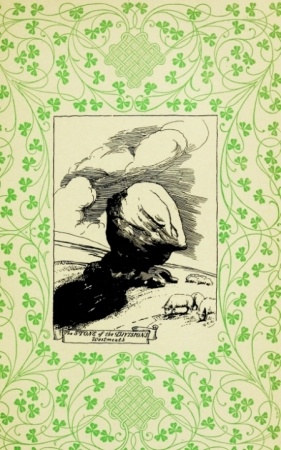
The Stone of the Divisions, Westmeath
{119}
Shannon Harbour, at which the Grand Canal joins the Shannon, is situated
on the river about six or seven miles from Shannon Bridge, and is
immortalized by Charles Lever in “Jack Hinton.”
As a tourist resort the town appears to have degenerated sadly, a
pretentious hotel establishment having been converted over into barracks
for the constabulary.
From Shannon Harbour the steamer passes Shannon Bridge, and in due
course reaches Athlone at the lower end of Lough Ree. “Population, seven
thousand. Industry, manufacture of the celebrated woollen tweeds, which
provides employment for several hundred operators, both male and female;
there are various other smaller manufacturing industries pursued by the
town population. In the rural districts, cattle rearing, both in
Westmeath and Roscommon, and the pursuit of general agriculture is
principally followed, and the inhabitants of these rural districts are
generally comfortable and fairly well-to-do.” Such is the usual
guide-book information concerning Athlone, which lies at the juncture of
Roscommon and Westmeath.{120}
As a matter of fact, however, almost every stone in the prosperous
little city has a historic interest and value, from the ruins of its
former splendid ecclesiastical establishments to its old houses and
still more ancient fortifications, and the castle erected in 1215 by
King John,—a counterpart in every respect of a similar establishment at
Limerick. Queen Elizabeth made Athlone the capital of Connaught. After
the battle of the Boyne, it underwent two sieges from the forces of King
William. Some traces of the old fortifications may be seen, and the
castle is still in perfect repair.
Just north of Athlone, where the Shannon joins Lough Ree, is Auburn,
more popularly known as “Sweet Auburn,” whose old ruined parsonage is
famous as the early home of Oliver Goldsmith.
Fleeting time has changed this modest mansion—whose ruin was deplored
by Goldsmith himself—but little. It stands about a hundred yards from
the public road at the end of a straight avenue bordered with
ash-trees,—a plain rectangular, two-storied house, built in the ugly
and uncompromising style that{121}

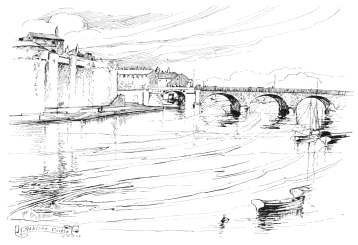
ATHLONE CASTLE.
{122}
{123}
was popular in Ireland in the early part of the seventeenth century. The
roof is off, but the walls remain, and seem still to be haunted by the
shade of the Rev. Charles Goldsmith, the original Doctor Primrose in
“The Vicar of Wakefield,” while his wife, hospitable as of yore, still
seems to invite the passing stranger to taste her gooseberry wine. The
famous inn,—since rebuilt out of all resemblance to its former
self,—immortalized by Goldsmith, and known as the Three Pigeons, where
were drawn the “inspired nut-brown draughts,” and “where village
statesmen talked with looks profound,” is but a little distance from the
house. The country all around Lishoy—for that is the name of the
townland in which Toberclare, this Mecca of the Goldsmith student, is
situated—is well wooded and cultivated. The drive from Athlone to
“Sweet Auburn” is one of the most delightful in Ireland. As the reputed
locale of “The Deserted Village,” Auburn, or Lishoy, as it was
formerly known, has an unusual share of interest for the literary
pilgrim.
Goldsmith was not born at Lishoy, as is{124} sometimes stated, but in
Pallas, a village in the County Longford, his father being at the time a
poor curate and farmer. The infancy of Oliver was, however, spent in
Lishoy, and there is little doubt but that the scenes of his childhood
became afterward the imaginative sources whence he drew the picture of
“Sweet Auburn,” though it is doubtless true that the descriptions are
general enough in character to apply to many localities in England as
well as Ireland:
“Sweet Auburn! loveliest village of the plain,
Where health and plenty cheer’d the labouring swain;
Where smiling spring its earliest visits paid,
And parting summer’s lingering blooms delay’d.
Dear lovely bowers of innocence and ease,
Seats of my youth, when every sport could please;
How often have I loitered o’er thy green,
Where humble happiness endear’d each scene!
How often have I paused on every charm!
The shelter’d cot, the cultivated farm:
The never-failing brook, the busy mill;
The decent church that topp’d the neighbouring hill;
The hawthorn bush, with seats beneath the shade,
For talking age, and whispering lovers made.”
Attempts have been made from time to time to justify the procedure,
which is customary{125} here, of stripping the hawthorn of its blossoms to
sell to tourists; and to explain that it is a perfectly legitimate and
artistic thing to have hung the old broken plates and cups of the
erstwhile Three Pigeons on the walls of the new inn. Sir Walter Scott
attempted to justify all this as “a pleasing tribute to the poet,” but
there is a hollow mockery about it all that will make the true pilgrim
hasten to commune with
“The never-failing brook, the busy mill;”
and
“The decent church that topp’d the neighbouring hill,”
all three of which exist to-day, and bear a far greater likeness to the
description of the poet than does the reputed inn.
Through Lough Ree one journeys along historical ground. Rindown Castle
was built, it is said, by Turgesius, a Dane, who made of it an
impregnable stronghold, as may be readily believed when one views its
rocky promontory.
The island of Inchcleraun, commonly called “Quaker Island,” is
associated with early{126} Celtic Christianity, and has on it the remains of
six churches. On this island, Queen Meave is said to have been killed,
while bathing, by an Ulster chieftain, who threw a stone from a sling
while standing on the shore.
Knockcroghery Bay leads to Roscommon, the chief town of the county of
the same name. It had its origin at the time when St. Coman founded a
monastery there, and to-day may still be seen elaborate remains of a
former Dominican establishment of the thirteenth century, and of a
fortified castle of the same era.
At the head of the eastern arm is All Saints’ Island, on which are the
well-preserved remains of a church and monastery,—an ancient foundation
which, in the seventeenth century, was occupied by the nunnery of the
Poor Clares, but was burnt by the soldiery in 1642. It is recorded that
the peasants of Kilkenny West retaliated by killing the destroyers.
Inchbonin, the “Island of the White Cow,” contains the remains of a
church and monastery, the foundation of the religious house being
attributed to St. Rioch, a nephew of{127} St. Patrick. Here, also, are the
remains of several Celtic crosses.
Entering the Shannon proper again at Lanesborough, one finally reaches
Carrick-on-Shannon, in itself uninteresting enough, but a centre from
which a vast amount of profitable knowledge may be obtained. It is the
gateway of the pretty valley of the river Boyle, where stands the
pleasant little town of the same name, with its famous abbey, which is
in rather a better state of preservation than many “chronicles in
stone.” The choir, nave, and transepts are all in existence, and show,
in their construction, all the elements of the West Norman and Gothic
work of their time. The nave, with its hundred and thirty-five
semicircular arches, which separate it from its aisles, is perhaps the
best and most characteristic Norman feature, if we except the square
heavy tower. In 1235, the English sacked these sacred precincts, and
even—it is said—stripped the monks of their gowns. In 1595 it was
turned into a fortress and besieged by the army of the Earl of Tyrone.
From the “Hibernia Illustrata” we learn that, “In the cemetery of
Kilbronan, not far{128} from Boyle, was buried the famous Carolan, one of
the last of the veritable Irish bards; and here for several years the
skull that had ‘once been the seat of so much verse and music,’ was
placed in the niche of the old church, decorated, not with laurel, but
with a black ribbon. He died in the neighbourhood in the year 1741, at a
very advanced age, notwithstanding that he had been in a state of
intoxication during probably seven-eighths of his life.”
From this we may infer that, if liquor was not more potent in those
days, it was at least less expensive.{129}
CHAPTER VI.
GALWAY AND ITS BAY
IT may not be recognized, it certainly is not a widely known fact, that
Galway at one time—however extraordinary it may now appear—arrived at
a pitch of mercantile greatness superior, with the single exception of
London, to any port in what is now known as the British Isles.
From an original letter from Henry Cromwell and the Irish Privy Council,
dated Galway, 7th April, 1657, we learn that:
“For situation, voisenage, and commerce it hath with Spain, the Strayts,
West Indies, and other parts, noe towne or port in the three nations
(London excepted) was more considerable.”
“Another city so ancient as Galway does not exist in Ireland,” says an
old-time traveller.{130}
“Its situation is flat and unpicturesque, but the universality of red
petticoats, and the same brilliant colour in most other articles of
female dress, gives a foreign aspect to the population, which prepares
you somewhat for the completely Italian or Spanish look of most of the
streets of the town.” “In Galway,” writes Köhl, “the metropolis of the
west, and a Hesperian colony, he (the traveller) will find a quaint and
peculiar city, with antiquities such as he will meet with nowhere else.
The old town is throughout of Spanish architecture, with wide gateways,
broad stairs, and all the fantastic ornaments calculated to carry the
imagination back to Granada and Valencia. Then the town, with its monks,
churches, and convents, has a completely Catholic air; and the
population of the adjoining country have preserved something of their
picturesque national costume.”
From the earliest times, especially about the fourteenth century, and
until a later period, extensive trade was carried on betwixt Spain and
Ireland. Galway was always one of the principal ports frequented by
foreigners. The richer merchants of the town made periodical{131} visits to
Spain, and returned with Spanish luxuries and Spanish ideas. The result
of this was that mansions in Spanish style arose and were filled with
Spanish furniture; while the ladies used in their dresses the bright
colours and light textures of Spain. It is reasonable, too, to suppose
that in many instances Spanish servants, seamen, and even workmen,
formed alliances with the natives of the soil, and thus the population
became, not only in dress but in blood, allied to their foreign
visitors. Many of the houses built for the merchant princes of Galway
still remain, though in a dilapidated state, and have come to be
occupied by the poorest inhabitants. Truly, “Galway was a famous town
when its Spanish merchants were princes; but their fine dwellings were
at one time usurped and defaced by the rabble, and little remains of the
interiors to show their ancient glory.” It is probable that, besides the
Spaniards, the Italians also traded with Galway, and that banks were
instituted by Jews from Lombardy. Little more than fifty years ago, “the
tribes of Galway” claimed to themselves the exclusive right of
exercising certain civil privileges.{132}
Just how far one may go in promulgating a theory, in a book such as
this, remains an open question. With regard to the Spaniards in Ireland,
it is not so much conjecture as to the time of their advent, or their
numbers, as it is with the causes which led up to it. Galway was one day
to be the pride and hope of Erin’s Isle. This we all know and recognize,
and, with this end in view, huge warehouses and quays were built to
accommodate a vast ocean-borne traffic which was to come and make it the
rival of Liverpool. One may walk along these quays to-day and see the
ruin of all this enterprise, for Galway, despite its seventeen thousand
inhabitants, is a town which bears, in its every aspect, the appearance
of a place that has already sunk into irretrievable decay.
As a gateway to Connemara, Galway still exercises great influence on the
prosperity of the west of Ireland, and, moreover, has an historic
interest which cannot fail to be attractive to the tourist for all time
to come. Recalling how James Lynch FitzStephen, in 1493, condemned and
actually executed with his own hands his only son Walter, who had{133}
murdered a young Spaniard, brings us to the fact that Galway was at one
time more a city of Spain than of Ireland.
In ancient times Galway was the most famous port in Ireland, and had a
very extensive trade, especially with the ports of Hispaniola. Many
Spanish merchants, sailors, and fishermen settled here, until, at one
time, probably one-fourth of the population of the town was pure
Spanish. They built their houses after the Spanish pattern, and mingled
with the native Irish population; but not, however, without leaving upon
it the ineradicable mark and powerful impress of their own character,
and imparting the superstition, the temperament, and the physical
qualities of their race.
Moreover, it is said that a large portion of the famed Armada was
wrecked off the Galway coast; and that, in addition to those already
there, these survivors settled and multiplied. In consequence, much of
the ancient architecture—discernible even to-day—is obviously of
Spanish origin; and there is no doubt that the Spaniards have left their
impress on the features and character of the{134} inhabitants of the town
and the near-by districts. One notes this as he strolls through the
market, where the women are selling fish, for the most part consisting
of sea-bream, red mullet, conger-eels, and lobsters. In their
complexions, their dark hair and eyes, their high cheek-bones, and their
carriage,—in the mantilla-like way in which they wear their shawls,
and in the brilliant colours of their costumes,—they bear a striking
resemblance to the fisherwomen of Cadiz and Malaga. The men are even
more strikingly Spanish.
The speech is curious, too. It is Gaelic, but it is full of Spanish
idioms and terminations. These people live for the most part in a
village called the Claddagh, whose population formerly kept itself quite
distinct from its Irish neighbours. The people married only among
themselves; had their own religion; in a measure, their own municipal
government; and pursued their own way without any reference to what went
on around them. Of late, however, this exclusiveness has, to a large
extent, been broken down. Still the Claddagh is a spot which has no
parallel elsewhere{135}

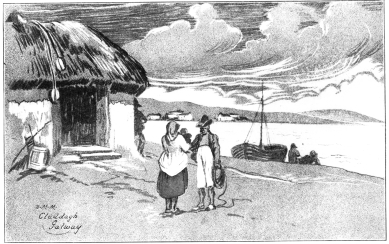
CHADDAGH.
{136}
{137}
in Ireland, and is a distinct survival of the original Spanish
settlement.
The Galway fisheries are still, and always have been, an important
economic factor in the life of these parts. Their conduct is a feature
no less interesting in many ways than the more æsthetic aspects of the
region. Nowhere else in the island can such a sight be seen as in the
salmon season may be observed from Galway Bridge, when the water in the
river is low. One looks over the bridge into the water, and sees what is
apparently the dark bed of the river; but drop in a pebble, and
instantly there is a splash and a flash of silver, and a general
movement along the whole bed of the stream. Then one comes to know that
what apparently were closely packed stones are salmon, squeezed together
like herrings in a barrel, unable to get up-stream for want of water.
This salmon fishery, together with the fisheries on the coast,
constitute the staple industries of the district; and, as a business
proposition, might appeal largely to some company promoter were he able
to corner the supply and control the traffic. The hardihood of the{138}
population, their aptitude for seamanship, their industrious habits, and
their thrifty instincts make them so capable of rising to any
opportunities that may be offered to them, that there is no reason why
Galway should not become as great a fishing-port as any on the east
coast of England.
Galway is full of memorials of its ancient days of commercial greatness,
when wealthy merchant families inhabited the fine stone mansions now
fallen into ruins; and tales of former glories are on everybody’s lips.
There is no dearth of anecdote about Galway. Some of it is fact; much of
it doubtless is not; but there seems no reason why one could not expand
a short chapter of its history into a great book were he so inclined.
Galway was practically “discovered” by the English in the thirteenth
century, “when they took possession of the desirable little town,” and
portioned it out among thirteen English families—those of Athy, Blake,
Bodkin, Browne, Deane, D’Arcy, Lynch, Joyce, Kirwan, Martin, Morris,
Skerret, and French. These became known as the Tribes of Galway, and
before long became “more{139} Irish than the Irish themselves.” This we
learn from the written records; but, since they exist so completely and
lucidly, there seems no reason to quarrel with the statement.
The Lynches were, and are, the most numerous and important of the Tribes
of Galway. The name is said to be aboriginal or at least Celtic, and
again tradition has it that all the Lynches are descended from the
daughter and heiress of a certain lord marshal of the county of Galway
in the year 1280. In 1442 a certain Edmond Lynch FitzThomas built at his
own expense a bridge called the West Bridge, and twenty years later
another, Gorman Lynch, held a patent for coining money; and yet another,
James Lynch FitzStephen, the famous Warden of Galway, whose notoriety
has been described in Dutton’s “Survey of Galway” (1824), lived at the
end of the same century.
As described by Dutton, the “notorious” incident arose from Lynch
FitzStephen having sent his only son to Spain on some commercial
affairs, who, returning with the son of his father’s Spanish friend and
a valuable cargo, conspired with the crew to murder and{140} throw him
overboard, and convert the property to their own use. One of the party,
as providentially happens in most such cases, revealed the horrid
transaction to the mayor. He tried and condemned his son to death, and
appointed a day for his execution. It was imagined by his relatives
that, through their intercession, and the consideration of his being an
only son, he would not proceed to put the sentence into execution. He
told them to come to him on a certain day, and they should have his
determination. Early on the day appointed, they found the son hanging
out of one of the windows of his father’s house. It was commemorated by
the cross-bones in Lombard Street.
Further records have it that the stone bearing the cross-bones was not
put up for many years after the transaction, when it was erected on the
wall of St. Nicholas’s churchyard, and bore the inscription:
1524
Remember Death.
All is vanity of vanities.
{141}
{142}

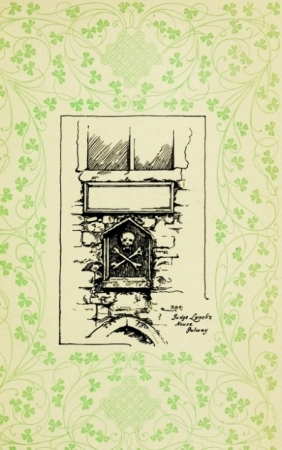
Judge Lynch’s House, Galway
{143}
From this incident—a recorded fact of history be it remembered—the
familiar “Americanism” (sic) of “lynch-law” probably received its
derivation. At any rate, the circumstance is one of significance and
plausibility, or it shows once again how the seed of coincidence takes
root and thrives many thousands of miles from the land of its first
growth.
Galway has ever been an important commercial centre, and rightly enough
points out the fact that to be as proud and honest as a Galway merchant
is to be reckoned as one of the upright of this world. It is a curious
fact that, notwithstanding the maritime resources of Galway, salt was
one of the commodities imported to it from Spain, and so highly was the
import prized that John French, who was mayor in 1538, bore the
distinguishing appellation of Shane ne Sallin.
The county of Galway must have been a quarrelsome and belligerent
community in times past, judging from the fact that local history gives
elaborate accounts of certain fighting gentlemen known as
“Blue-Blaze-Devil-Bob,” “Nineteen-Duel-Dick,” “Hair-Trigger-Pat,”{144} and
“Feather-Spring-Ned.” But these honourable cognomens are no longer cited
with a voice of triumph by the leading citizens; and it may be presumed
that Hair-Trigger and Blaze-Devil exploits are becoming rarer. There is
no reason to doubt but that this is so, judging from appearances and
experiences with which one comes in contact to-day.
Historians, anthropologists, and antiquarians have attempted before now
to draw comparisons between the inhabitants of Galway and those of
Spain. The circumstance has been authenticated and remarked frequently;
but it is interesting, if not valuable, to have a native first-hand
opinion on the subject.
An elderly gentleman whom the author once met, who had lived in Spain
and Galway respectively a number of years, remarked many characteristics
in common among the middle class; and, again, at the proceedings of a
philosophical society, it was stated that “in the lower and more vulgar
classes, the old Milesian habits still prevail.” Rather a contemptuous
way of putting it this, but indolence, or at least something more than
a{145} trace of it, is, one must admit, still apparent in both places.
Of the spoken speech of Galway much has been written, and with good
excuse, for Spanish idioms and words still come to the surface here, as
does the French tongue in certain parts of Scotland.
The writer recalls an incident in the experiences of an ardent
automobilist, which took place in the neighbourhood of Galway:
He was driving down an extremely steep hill, and was barely able to keep
the automobile in hand. There was a safe “run-down” ahead, but a number
of Irish-speaking children kept dancing and running around in front,
deaf to his uncomprehended cries of “Get away! Take care! you’ll be run
over!” and it seemed likely that some one would be killed when the
motor-car should get its head. Just as that disaster became imminent,
however, the driver remembered the one Irish word he
understood,—“Faugh-a-ballagh!” (a famous war-cry of olden times,
equivalent to “Clear the way”). He only remembered it as the name of a
race-horse, but yelled it out; and the children sprang out of his way{146}
like arrows, just in time to let the car rush safely past.
Galway, too, has the reputation of being one of the few counties left
(Cork is another) where the typical “Paddy” of romance is to be found.
That is, so far as his or her dress is concerned; and, truth to tell, it
has all but disappeared from here, for it is only of a bright summer
Sunday, or some local feast-day, that the Irishman, dressed as in the
chorus of a comic opera, is ever seen.
In Galway itself, on an important market-day, he is still to be seen,
and forms a picturesque note to the surroundings which the
sentimentalist would indeed otherwise miss. He is found in knee-breeches
and tail coat, high caubeen with a pipe stuck in it, and long
home-knit stockings, accompanied by the Galway women in short scarlet
petticoat and close-hooded cloak. All the latter wear this dress, by
the way. There is practically not a woman of the working class in the
town—certainly not one in the Claddagh fishing quarter—who does not
cling to this bit of colour, as thick as a blanket and very fleecy. It
is spun, woven, and made at home; and, as a result,{147} raggedness is
exceedingly infrequent among the Galway natives. Indeed, all Connemara
is remarkable for the clean, neat, and whole clothing of its people, who
are otherwise poverty-stricken. It is only in great towns, where the
poor clothe themselves in slop-shop stuffs and cast-off garments of the
upper classes, that they are ragged and unkempt. Homespuns and tweeds,
such as we are accustomed to see only in smart coat and skirt costumes,
or expensive shooting suits, are the daily wear of every one. They cost
little,—only the keep of a few hardy mountain sheep, from which the
wool is obtained, the loan of a spinning-wheel from a neighbour, and the
small fee of a local hand-loom weaver. Thus the people of Mayo and
Galway, though often at other times miserably clad, go about with a neat
“tailor-made” aspect that is astonishing.
The tourists, i. e., the ladies, buy the charming Claddagh cloaks and
bolts of homespun, which ultimately appear in more fashionable centres
as the last thing in the world of fashion.
Another form of souvenir, which appears to be irresistible, is the
peculiar marriage-ring{148} of Claddagh. This particular pattern has been
the marriage-ring of the Claddagh fishing tribes for many centuries.
Indeed, every peasant matron in the county wears one. The design is that
of a heart over two clasped hands, surmounted by a crown, the
signification being “Love and friendship reign.” Among the upper classes
in Ireland, these rings are often used as guards for engagement and
wedding rings.
A more interesting monument than any memorial stone in the abbey, or,
indeed, in Sligo, is Misgoun Meave, which dominates the whole
neighbourhood, the traditional burial-place of Queen Meave. On the top
of Knocknarea, a hill over one thousand feet high, stands an immense
cairn of stones, almost like a second peak to the hill. Here,
overlooking a wide range of beautiful seacoast and country, tradition
states that the famous Irish Queen of Connaught, after she had buried
three husbands, chose her tomb. Nearly two thousand years have passed
since the date popularly assigned to her reign, but there can be no
reasonable doubt that she was a thoroughly genuine personality, and left
her{149} individual mark upon the history of her time. Like Boadicea, she
led her own armies in person, and seems, according to the wild legends
told of her exploits, to have been an Amazon of terrible reputation and
dauntless courage. She had the red-gold hair that may still be seen in
Connaught,—a heritage popularly supposed to have descended from
her,—and wore it flowing like a mantle over her. Her beauty was
considerable, her temper ungovernable, and her virtue, apparently,
doubtful. She was often accompanied to battle by her stalwart sons of
middle age; and her own years are reported to have counted well over a
century before death at last loosened her iron grip on blood-stained
Connaught. One can well understand how such a woman, dying, chose to be
buried where, even in death, her sightless eyes might look down upon the
land of lake and island, forest, hill, and sea that had been hers so
long.
A lively French writer, who travelled in Ireland in the early part of
the nineteenth century, was evidently much smitten with the fair sex.
He says, in part:{150}
“The greatest gaiety reigns there,—in fact, the belles of Galway are
capable of instructing most French young ladies in the art of coquetry.
In the early morning, one sees five or six young ladies, perched upon a
jaunting-car, go two miles from the city to refresh their charms by a
sea bath, and in the afternoon, if there be no assembly, they go from
shop to shop, buying, laughing, and chatting with their friends. There
are many in this city who grow old without knowing it.”
All of which seems a simple and innocuous enough amusement. In spite of
which, however, no very apparent coquettishness on the part of Galway
young ladies is to be noted to-day,—at least, it has not been observed
by the writer of this book. Perhaps that merely points to a lack of
susceptibility on his part.
T. P. O’Connor once told the story of a travelling showman who brought
to Galway from America a panorama of America. “He knew what he was
about,” said Mr. O’Connor, “when he declared that Chesapeake Bay was the
finest bay in the world with two {151}exceptions,—the Bay of Naples and the
Bay of Galway; and he was very loudly cheered.
“Without exaggeration, it is a beautiful bay, almost landlocked, with
mountains—small enough in comparison with others, but to the
untravelled eye of the Irish villager solemn and imposing as the
Matterhorn—bounding it on the far side, and with a somewhat narrow
mouth opening out into the Atlantic. A mouth that, under the light of
morning or evening, is something to suggest either the vastness of this
world of human beings, or the anticipation of the greater vastness of
that other world beyond, which haunted the imaginations and thoughts of
the pious Catholics of that region.”
These few lines serve to give a most truthful word-picture of Galway
Bay; and also a glimpse of the brilliancy with which Mr. O’Connor
writes. Continuing, Mr. O’Connor writes of his school-days in Ireland
thus, in words which give a far more sympathetic and clear knowledge of
things as they are—or were—than most reminiscences of a like nature:
“There had come to my native town of{152} Athlone a new school, and it was
but natural that my father should like me to go there, and, accordingly,
I had no more of Galway—except at vacation-time—for five long years.
“These years belong to my native town and the school near it; and they
were among the most unhappy years of my life.
“I remember still the bitter flood of tears I wept the first day after I
returned to Athlone from the year or so I had spent in Galway.
“But Galway had to me, then, many of the chief charms of boyhood. There
was a second house behind that in which we lived, which was usually
unoccupied. From its roof you could see one of those beautiful scenes
that, once seen, haunt one ever afterward. Beyond the town you could
catch sight of the sea; and there, on certain evenings, you saw the
fleet of herring-boats as they went out for their night-watch and night
harvest of fish,—a sight that was more like something of fairy-land
than of reality, though I dare say the poor crews found much grimmer
reality than romance in their hard and laborious night-watches.”
Just off the mouth of Galway Bay are the{153} Aran Islands. Between them and
the mainland the sea is often so rough as to make it impossible for
small boats to undertake the crossing. The principal food of the
inhabitants is dried fish, naturally a home product.
The chief patron saint of Munster, aside from St. Finbarr’s association
with Cork, was St. Albeus. He had already been converted by certain
Christianized Britons, and had travelled to Rome before the arrival of
St. Patrick among the Irish. After his return, he became the disciple
and fellow labourer of that great apostle, and was ordained by him as
first Archbishop of Munster, with his see fixed at Emely, long since
removed to Cashel.
He possessed, according to the chroniclers, the wonderful art of making
men, not only Christians, but saints, and for this great ability King
Engus bestowed upon him the isles of Aran in Connaught, where he founded
a great monastery.
So famous did the island become for the sanctity of its people that it
was long called “Aran of Saints.”
The rule which St. Albeus drew up for them is still extant in the old
Irish manuscripts.{154} Though zeal for the divine honour and charity for
the souls of others fixed him in the world, he was always careful, by
habitual recollection and frequent retreats, to nourish in his own soul
the pure love of heavenly things, and to live always in a very familiar
and intimate acquaintance with himself and in the daily habitual
practice of the most perfect virtues. In his old age, it was his earnest
desire to commit to others the care of his dear flock, that he might be
allowed to prepare himself in the exercise of holy solitude for his
great change. For this purpose, he begged that he might be suffered to
retire to Thule, the remotest country toward the northern pole that was
known to the ancients, which seems to have been Shetland, or, according
to some, Iceland or some part of Greenland; but the king guarded the
ports to prevent his flight, and the saint died amidst the labours of
his charge in 525, according to the Ulster and Innisfallen annals.
These islands are three in number: Inishmore, Imishmaan, and Inisheer,
and contain among them such a wealth of pagan and Christian antiquities
as is excelled by no{155}

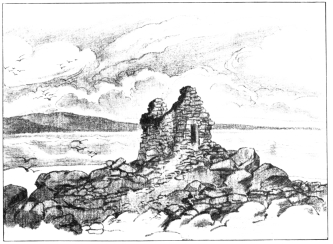
THE CHURCH OF THE CANONS, ARAN.
{156}
{157}
locality in Ireland of the same area: perhaps fifteen square miles in
all.
There is a work published in Dublin, known as “The Illustrated Programme
of the Society of Architects,” which contains a brief account of the
wealth of the architectural and historical lore of these parts. More one
could not wish to know unless he were profoundly interested, and less
would not even satisfy him if he became at all enamoured of these
islands, so full of dreary old places and quaint customs, to say nothing
of the wealth of tradition and legend which hangs about it all.
Westward, the nearest land is America, where so many stalwart sons of
Galway—and daughters, too—have migrated. Here the peasants still
reverently believe in the far-famed land of Hy or O,—Brazil, the
paradise of the ancient pagan Irish.
The praises of the “great fictitious island” were sung by the bards of
olden time, and tradition has perpetuated its fame as a “land of
perpetual sunshine, abounding in rivers, forests, mountains, and lakes.
Castles and palaces arise on every side, and, as far as the eye can
reach, it is covered with groves, bowers,{158} and silent glades; its fields
are ever green, with sleek cattle grazing upon them; its groves filled
with myriads of birds. It is only seen occasionally, owing to the long
enchantment, which will, they say, now soon be dissolved. The
inhabitants seem always young, taking no heed of time, and lead lives of
perfect happiness. In many respects this fabulous land resembles the
Tirna-n’oge, the pagan Irish Elysium.”
Among the chief—and assuredly unique—reliques of these few square
miles of terra firma are the ruins of the old fortified Castle of
Ardkyne, in which are built the remains of the great church of St. Enna,
chief of the Oriels, who, upon his conversion, abandoned his secular
rule, and eventually settled (not later than A. D. 489) in Aran, which
henceforth became Ara-na-noamh, “Aran of the Saints.” The church was
one of several destroyed by the soldiers of Cromwell; but its plan,
about twenty by ten feet, can be traced behind the village. Above the
village is the stump of a round tower, and, on the ridge, the oratory of
St. Benen, a unique specimen of early Irish church architecture, which{159}
has remarkably steep pitched gables. The window in the east wall has its
head and splay of a single stone. The narrow north doorway has inclined
jambs. If the name refers to the apostle of Connaught, St. Benen of
Armagh, it must be a dedication, as he died in 468. The building may
with confidence be assigned to the sixth century.
St. Edna’s burial-place, known as Tegloch Edna, is another curious
premediæval church.
On the Aran Islands there are no bogs, but one has, instead, to dodge
his footsteps in and out among pebbles and rolling stones of every size
and shape. This is particularly so if one is to make the journey to Dun
Ængus, one of the finest prehistoric forts of Western Europe; called,
indeed, by Dr. Hindes Petrie, “The most magnificent barbaric monument
now extant in Europe.”
It is, undoubtedly, the most noteworthy object in Aran. It consisted
originally of a triple line of works, but the two inner lines, of
horseshoe shape on the verge of a bold headland, are those best
preserved. Tradition assigns it to Ængus, a Firbolg chief who lived
about two thousand years ago. The chevaux-de-frise{160} defending the
second line is unmistakable, and the whole is as majestic in its
grandeur as its supposed antiquity might indicate.
Temple MacDuagh, near Kilmurvy, is a “cyclopean” church of the seventh
century, and Dun Oghil is a grand fort consisting of a circular cashel,
within a second, which is roughly square.
These are the chief features of the great island, with the Temple
Brecan, which has a chancel of rude ancient masonry, a choir which more
nearly approaches our own time by four or five hundred years and is
still modern, and a sacred enclosure devoted to the burial of saints, of
which the Irish calendar seems quite full.
On Inisheer are the remains of an ancient place of worship dedicated to
St. Cavan, brother to St. Kevin, the legend of whose life everywhere
confronts one in County Wicklow. There is another to St. Gobnet, abbess
of the sixth century.{161}
CHAPTER VII.
ACHILL TO SLIGO
IT has been suggested before now that the domain of Achill Island, off
the coast of Mayo, that wonderland of natural unspoiled grandeur, be
preserved as a sort of national park.
Its primitive beauties are impressively great without rising to
splendour or magnificence.
Said Sir Harry Johnston, in writing to the London Times:
“Is it impossible that individuals and the State together should
intervene before it is too late and save Achill Island as a national
park, as a paradise in which the last aspects of the indigenous British
fauna may be exhibited? This might be done without disturbing the
indigenous population, who could still carry on their fishing industry
and the{162} amount of agriculture necessary to their subsistence, without
interfering unduly with the wild birds and beasts of the island. There
would be, of course, an absolute interdict against ‘sportsmen’ and
gunners; it would no longer be permissible to shoot the seals that haunt
the caves and rocks around Achill, while the deer, wild goats, foxes,
eagles, ravens, swans, gulls, choughs, and other wild birds and beasts
would be similarly protected. People would then visit Achill Island at
all seasons of the year (the climate is remarkably mild in winter) for
the pleasure and interest afforded by the contemplation of its wild
fauna. We should, in short, have an object-lesson of what Ireland and
most other parts of the British Isles were like under prehistoric
conditions.”
From this it will be inferred that there is every encouragement for such
a procedure, did the powers but take their rightful initiative.
Whether such an event, if it come to pass, would make for a greater
admiration of this lone and sea-girt bit of terra firma, it remains
for others than the writer of this book to{163}

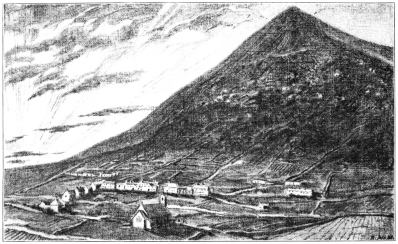
ACHILL ISLAND
{164}
{165}
prognosticate. Certainly, under any aspect except that of the erection
of multitudinous “resort hotels” and “furnished bungalows,” Achill
Island is a wonderful resort for those in need of soothing influences;
and, for its natural and unspoiled charms alone, should be kept quite as
it now is.
Achill is a veritable unknown wonderland. Not that it is actually
unexplored, that it is vast, or that it is inaccessible. It is none of
these; but few foreigners, or “aliens,” as the Irish prefer to think of
strangers, have ever visited this little-known corner of Ireland, or
even know where it is. Achill Island is the largest island on the Irish
coast, in shape not unlike an irregular triangle, and contains an area
of fifty-five square miles. To the north is the deeply indented Black
Sod Bay, with its myriad smaller bays, while to the south is Clew Bay,
populated with numerous tiny islets, and the high-held head of Croagh
Patrick. Off to the northwest are the “Enchanted Isles,” the legendary
homes of saints and recluses, among them Inishglora, Inishkeenah, and
Inishkea.
On one of these it is fondly believed by the{166} natives that Ossian
resided. Tradition has preserved the record thus:
“Ossine MacFoin, seated on the banks of the Shannon, adoring the Author
of Nature in the contemplation of his works, was suddenly hurried away
to Tirna-n’oge (the country of youth, or island of immortals), which he
describes with all the vivacity that fancy, aided by the sight of so
lovely a country as Ireland, could assist the bard with. He remained
here for some days he thought, and, on his return, was greatly surprised
to find no vestige of his house or of his acquaintance. In vain did he
seek after his father Fion, and his Fonne Eirion; in vain sounds the
buabhal, or well-known military clarion, to collect those intrepid
warriors. Long since had these heroes been cut off in battle; long had
his father ceased to live! Instead of a gallant race of mortals which he
had left behind, he found a puny and degenerate people, scarce speaking
the same language. In a word, it appeared that, instead of two days, he
had remained near two centuries in this mansion of the blessed.”
(O’Halloran.)
Achill itself contains scarcely a tree worthy{167} the dignity of the name;
but heath, gorse, juniper, and coarse grasses abound.
Sleivemore has a height of 2,204 feet and Croghan 2,192. Both rise
abruptly from the sea, after the manner of the castellated peaks in the
fairy books, which, with their component castles, mostly do not exist
out of books.
Kildavnet Castle on Achill Sound was one of the numerous retreats of
Grace O’Malley. Its square keep still stands. The arm of the sea on
which it was built was so deep that vessels rode at low water under the
very walls of the castle. “Here,” tradition states, “the skull of Grace
O’Malley was formerly preserved, and valued as a precious relic. One
night, however,—so the legend goes,—the bones of the famous sea-queen
were stolen from their resting-place, and conveyed, with those of
thousands of her descendants, into Scotland, to be ground into
fertilizer. The theft was of course perpetrated in secret, and in the
night-time. If the crew had been seized by the peasantry, with their
singular cargo, not a man of them would have lived to tell the tale, for
the Irish regard with peculiar horror any desecration of the
graveyard.”{168}
According to a recent census, the population of Achill and Achill-beg,
the baby islet off the southern limb of its parent, has decreased nearly
ten per cent. in the space of ten years; from which fact it may be
inferred that the popularity of this salubrious spot—for it ranks high
among the world’s great natural sanatoria—is not increasing with the
rapidity that might be expected.
The two villages of the larger island, Keel and Dooagh, seem populous
enough, as is also the Protestant community of Dugort. The island, in
general, is exceedingly unproductive, though the sea yields a wonderful
harvest to the fisher folk.
There is but a narrow margin between the well-being and distress of the
inhabitants, but signs are not wanting that whatever, in exceptional
periods, may have been their condition, at present they are relatively
better off than many of their compatriots in the west of Ireland.
Considerable numbers annually migrate to the north of England and the
south of Scotland for the harvest, just as, with the same motive, the
“East-Enders” of London throng to the hop-fields of Kent, and the
willing{169} and industrious Bretons cross the Channel, in the autumn, to
the hay-fields of England’s “home counties.”
Off the western Irish coast, from Connemara and Mayo, there are yet to
be found remote islands with an exceedingly primitive civilization.
Achill owes much of its interest to the fact that it exhibits a similar
state of things, in many points little altered by contact with the
mainland. The people, the cabins they inhabit, and their manner of life
show very little change, in spite of the introduction of a good many
articles of manufacture which a generation or two ago were quite unheard
of. One thing which cannot fail to be noticed will be the queer little
“public houses.” The tenement itself, however aboriginal, is sure to
contain an assortment of strong drinks as varied as the average West End
bar. The quality may be dubious, but there will be no question as to the
strength and specific gravity of the spirit, particularly the
eau-de-vie, or the “mountain dew.”
Of the charms of Dugort, the “Settlement,” and Dugort proper, the
poet-laureate, in the{170} pages of “Maga,” has written eulogistically. He
says:
“A more perfect place of holiday resort it would not be possible to
imagine. There are fine yellow sands, where children may make dykes,
fortresses, and mountains of moderate height.... There is fishing,
either in smooth or rolling water, for those who love the indolent
rocking or the rough rise and fall of the sea; precipitous and fretted
cliffs, carved with the likeness of some time-eaten Gothic fane by the
architectonic ocean; rides, drives, and walks amid the finest scenery of
the kingdom. ‘I think she prefers Brighton,’ said a stranger to me of
his companion; and, if one prefers Brighton, one knows where to go. But
if nature, now majestically serene, now fierce and passionate, be more
to you than bicyclettes and German bands, you can nowhere be better than
at Achill.”
The Settlement, or modern Dugort, is a group of cabins above the shore,
which owed its creation to the Rev. Edward Nangle, a clergyman of the
Established Church. In 1831 he visited Achill, and was so impressed with
what he deemed the “spiritual destitution”{171}

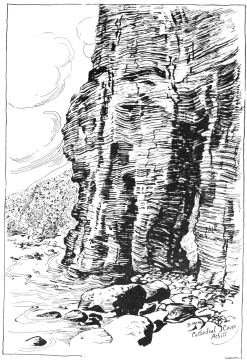
CATHEDRAL CAVES, ACHILL.
{172}
{173}
of the islanders that he organized a mission. Some seventy acres of land
having been bought, two or three cottages were erected in 1833, and in
the following year Mr. Nangle settled at what is now the bright little
village of modern Dugort. Whatever opinion may be held as to the value
or wisdom of his undertaking, Catholic and Protestant alike, now that
the dust of the battle has settled, will agree that Mr. Nangle had in
him the stuff that heroes are made of. His immediate oversight was
withdrawn about 1852, though for the rest of his life he took an active
share in promoting the continuance of his work. He died in 1883, in his
eighty-fourth year, but long before that time the “mission” had ceased
to be a cause of dispute, and now Dugort is merely a small Protestant
preserve in a Catholic district.
Just south of Achill, in Clew Bay, is Clare Island, which has been
likened to the pirate islands of the transformation scenes of the
theatre. Certainly the description is a good one, as it is a spot
typically suitable in shape and outline for hidden treasures,
shipwrecks, and blood-letting galore. Its outline is bold{174} and jagged,
and it sits ensconced in a basin of blue water, which, in the twilight,
is lit up by the western sun in a manner like nothing else so much as
that of the theatre.
It was perhaps merely an odd fancy—though a likely enough one—that is
responsible for the simile; but it is pertinent to remark that this
tiny emerald, set in a sea of sapphire, was really one of the many
haunts of Grace O’Malley, the famous chieftainess and warring amazon of
the sixteenth century. Here she actually did live, hoarded her arms and
munitions, concealed her treasures, and imprisoned her captives, hence
it is with reason that the description lives to-day. One commends the
perspicacity of Grace O’Malley, or Grania Uaile, as she is sometimes
called, in having selected such a beautiful spot for her stronghold,
sheltered on one side by the purple hills of Connemara, and on the other
guarded by the open sea.
Next to the headlands of Kerry, Connemara is the westernmost part of
Ireland. Its identity is now lost in that of County Galway, but it is
still known to travellers as “wild Connemara.” Not that it is entirely
unpeopled, or{175}

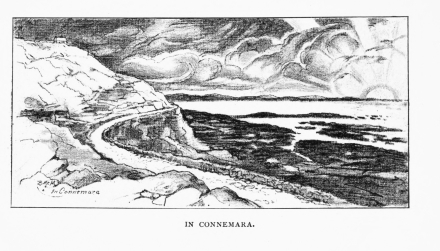
IN CONNEMARA.
{176}
{177}
that there is any special hardship involved in traversing its area; the
hotels are more numerous than ever, and it is an open question if the
accommodation offered at Recess, Clifden, Westport, and many other of
the purely tourist points is not the equal of any in Ireland. They have
not the electric light in many instances, and often not water “laid on,”
but the genuine traveller will not care for this if he can but be sure
of his bed and board. To feel sure of the former, however, it will be
necessary for him to bespeak it in advance if he travels here in the
season.
In Connemara there is no great wealth of historical or archæological
memorials. In fact, there is a scarcity of both, and one has to take his
fill of the wild, natural beauties of the rock-bound coast scenery, the
bracing atmosphere, and the wholly unspoiled charm of the place, which,
in spite of the advent of the great hotels before mentioned, has not yet
become travel-worn.
Lough Carib, which is possessed (at Oughterard) of a fine ruined castle,
just north of Galway, is the largest of the score of purple,
deep-looking lakes with which the western{178} part of the county is dotted.
The scenery of lake and sea, of bracken-clad hills and plains, and of
great sombre, gloomy mountains makes up an ensemble of surpassing
beauty. The centres of population are few, far between, and of minute
dimensions.
The railway line from Galway ends at Clifden, a town so unimportant and
quiet that, in itself, it does not warrant remark. It was founded in the
reign of George IV., and this early foundation consisted of but a single
house, though it is the gateway to the wonderful coast scenery of the
region to the northward, not actually in Connemara, but what is known as
“Joyce’s Country.”
Of all the landlocked bays of this region, none equals Killary Harbour,
which is simply the elongated estuary of the tiny river Eriff.
The hamlet of Leenane is the metropolis of these parts, and is so very
small and unimportant that it would hardly be remarked, except for the
fact that no other of even the same rank lies within a radius of twenty
miles. The situation of Leenane is charming, at the head of Great
Killary. Around about are hills of mountainous pretentions, and before
its{179}

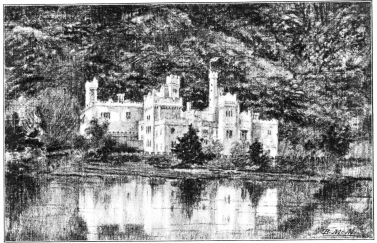
KYLEMORE CASTLE.
{180}
{181}
doors is a fiord, as ample and as calm as many, of more fame, to be
found in Norway. Seaward, the great hills come down to the water’s edge
and almost join hands across the narrow mouth of the estuary, forming a
sheltered and landlocked haven of so great a depth as to allow anchorage
for even a great battle-ship.
Between Galway and Clifden is Recess, a point of vantage from which to
visit much that is characteristic of the scenery of Connemara. Firstly,
the region is of interest to the fisherman; secondly, the geologist;
and, thirdly, to all lovers of nature, which, judging from the recent
popularity of “nature books,” is perhaps much the largest class.
The chief topographical feature, which forms the background to Recess,
is the mountain range of the “Twelve Bens,” a glorious group of
dark-mantled mountains with stony peaks and flinty-quartz hearts.
One may tramp Connemara for weeks, and not know all its beauty-spots, or
he may scamper around it by coach and rail in two days, and depart
thinking he has seen it all; but in either case, his memory, if it be a
good one, will sooner or later call him to task for{182} his presumption.
For this reason, it is manifestly presumptuous to attempt to give its
proper rank to its great wealth of natural attractions among the various
collections which Ireland possesses.
The scenery about Recess is a picturesque combination of lake and river
and mountain; but, to the southward, there are wild and rugged bits of
coast and red bracken-covered hills, which look to-day exactly as they
did in times primeval.
Lough Glendalough, which lies immediately before Recess, is but the
foreground of a lovely picture which it will take many days to dissect
and fully appreciate.
There has ever been a dispute as to whether the glory of the “Twelve
Bens” really belonged to Recess or Leenane. It certainly matters little,
since they are a wonderfully impressive background viewed from either
point.
It must be a well-booted and strong-limbed pedestrian who will essay the
task of ascending these famous mountains. Benbaun is the monarch of the
Bens, and is 2,395 feet in height. Not a very great altitude as
Continental{183}

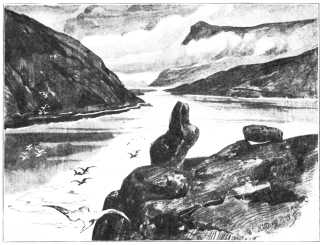
KILLARY HARBOUR.
{184}
{185}
mountains go, but withal a very respectable eminence to climb.
North of Achill is Black Sod Bay, whose memory comes down to us through
Kipling’s reminiscence in “A Fleet in Being.” More anciently, it was one
of the harbours where a part of the ill-fated Armada was supposed to
have gone ashore. There are no great centres of population here in the
bleak northwest of County Mayo, and there are no architectural remains
of note; but there is local colour, and much of it, for one who would
study the poor Irish peasant on his native heath.
Until one rounds the headland of Benwee, and passes the “Stags of
Broadhaven,”—a head of deep-water pinnacles of rock whose jagged
outlines have been likened to a stag’s antlers,—and reaches Killala
Bay, there is naught of twentieth-century civilization to remind one he
is not living in other days, or certainly in other lands and among other
associations than those which city folk have come to consider
necessaries.
Killala Bay is flanked on the west by Downpatrick Head, which rises two
thousand feet sheer above the sea-level. It is one of Ireland’s{186} true
wonders, but attracts few visitors save migratory sea-fowl.
Killala itself, one learns from the “Life of St. Patrick,” is a place of
great age. The holy man himself—
“Came to a pleasant place where the river Muadas (Moy) empties itself
into the ocean; and on the south banks of said river he built a noble
church called Kill Aladh, of which he made one of his disciples,
Muredach, the first bishop.”
The present cathedral was entirely rebuilt in the seventeenth century,
and has no architectural importance. Close by, on a knoll, about which
the village is built, is a round tower, eighty-four feet high and
fifty-one feet in circumference.
“At Kilcummin, on the west side of Killala Bay, a body of French troops,
under General Humbert, landed, August 22, 1798, with the object of
supporting the United Irishmen. They at once took Killala and Ballina,
and at Castlebar the government levies were in such haste to retire
without fighting as to give rise to the nickname, ‘Castlebar Races.’”
Ballina, at the head of Killala Bay, is the{187} “tourist resort” of the
region. It is pleasant and delightful in all of its aspects, and in its
neighbourhood are some very interesting architectural remains. There
are, as is often the case, a Roman Catholic and a Protestant cathedral
in the town, and an Augustinian monastery, a ruin of a fifteenth-century
structure, also many attractive vistas and spots most worthy of the
brush and pencil of the artist.
These attractions pall in the mind of the local spreader of publicity,
who extols only the size and varieties of fish which may be taken in the
river Moy and other near-by waters.
From Ballina one reaches Sligo in five and a half hours by means of that
still prevalent institution, the genuine Irish “low-backed car.”
Somewhere in the county of Sligo is the “Valley of the Black Pig,” which
is possessed of a legend which recounts how, for generations, the Irish
peasantry have comforted themselves in adversity by the memory of a
great battle fought here in this valley.
W. B. Yeats tells how, a few years ago, in{188} the barony of Lisadell in
Sligo, a peasant would fall to the ground in a trance as it were, and
rave out a description of the bloody battle which once took place.
This shows, at least, that tradition and legend alike die hard in the
minds of the people, and when Mr. Yeats tells us that men have told him
that they have seen the girths instantaneously rot and fall from horses;
and that few, if any, who enter the Black Valley ever come out alive, we
realize fully how close we are, even in these times, to the age of
superstition in Ireland.
Mr. Yeats furthermore eulogized the incident in verse.
“The dew drops slowly; the dreams gather; unknown spears
Suddenly hurtle before my dream-awakened eyes;
And then the clash of fallen horsemen, and the cries
Of unknown perishing armies beat about my ears.
We, who are labouring by the cromlech on the shore,
The gray cairn on the hill, when day sinks drowned in dew,
Being weary of the world’s empires, bow down to you,
Master of the still stars, and of the flaming door.”
{189}
Sligo itself, with its ten thousand souls and its important and
matter-of-fact seafaring trades, is a centre for journeying afoot or
awheel amid many charming scenes of lough and lake and sea and shore.
Southward is Carrick on Shannon, the gateway to the Shannon’s lakes and
rivers; northward is the Bay of Donegal, backed by its famous rugged
“Highlands;” and, eastward, is Lough Erne, which, with its upper and
lower lakes and the river Erne trickling minutely southward, is quite
the rival of the long-drawn-out Shannon, or would be if the tide of
popular fancy ever turned that way. Enniskillen is the metropolis of
Lough Erne. Locally it is known as the Island City by reason of its
being apparently surrounded by the all-enfolding waters of the upper and
lower lakes. Its fame lies principally in its entrancing situation, and
the memory of its various regiments of Enniskillen Dragoons who have
fought and won gloriously in many of England’s “little wars,” and big
ones, too, for that matter. The colours borne by the two Enniskillen
regiments at Waterloo are still preserved in the parish church.{190}
Until the days of James I., Enniskillen was no more than a stronghold of
the Maguires, but it then gained much prominence through the eventful
part it played in the domestic struggles and troubles of the latter half
of the seventeenth century. Of the old castle, which has braved so many
fights, only a small portion remains, and is incorporated in the modern
military barracks, which, in one way, indicate the importance of
Enniskillen.
“The Falls of Erne,” at Ballyshannon, where the river joins its estuary
with its rapid, tumbling torrent falling over a thirty-foot wall of
rock, indicate in no unmistakable manner the volume of water which flows
from source to sea. At Ballyshannon, which has more than a local renown
among disciples of Izaak Walton, is the famous “salmon leap” which, at
certain seasons, provides a display of the wonderful acrobatic ability
of this gamy fish. But a short three miles from Ballyshannon is Belleek,
with its famous china factories which produce a peculiarly lustrous
egg-shell ware much admired for its simplicity and crudeness of form,
but very transparent and light. Here, too, are another series of
rapids,
{191}
{192}

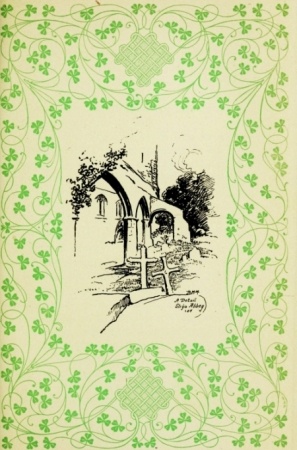
A Detail of Sligo Abbey
{193}
as great in their way as those farther down-stream. Sir Joseph Paxton
called them “the most picturesque in the world,” but one should judge
for himself. They are marvellously effective, however, for the river
falls nearly 150 feet in three miles or less.
Sligo itself, in spite of its commercial importance, is not greatly
appealing in its interest, if one excepts its old abbey, now a ruin, but
once an exceedingly ambitious Dominican establishment. Founded in 1252,
it was destroyed by a fire in 1414, though immediately rebuilt. Its
Gothic is of that superlative quality known best in the superb monkish
erections of the Continent of Europe. There are various monuments yet to
be seen therein of local and historical interest, but the chief
attraction is what remains of the beautiful cloister, fairly perfect as
to preservation, and surrounding three sides of a rectangle. There are
forty-six arches, each about four feet and a half in height, all
elaborately carved, and quite different one from another.
By an ancient and inalienable right, the abbey grounds are still used as
a Roman Catholic burial-place.{194}
CHAPTER VIII.
THE DONEGAL HIGHLANDS
THE Bay of Donegal, and indeed the whole Donegal district, is mellowed
and tempered by the everflowing Gulf Stream, which, so the scientists
say, were it diverted by any terrestrial disturbance, would give to the
entire British Isles the temperature and climate of Labrador. As this
event is hardly likely to take place, and certainly cannot be foretold,
the interest in the subject must rank with that which one takes in the
announcement of the statisticians, for instance, that an express-train
travelling at sixty miles an hour would take millions of years to reach
Saturn, were it once headed in that direction and had the elevating and
sustaining qualities of an air-ship.
Certainly, the mean temperature of the{195} whole south and west coast of
Ireland is marvellously mild, and that of Donegal is exceptionally so.
The cliffs of Slieve League, which form a jagged, many-coloured
precipice, rise at a sharp angle from the northern shore of Donegal Bay
to the summit of the storm and wave-riven mountain, a rock wall 1,972
feet high. It is a grand and noble headland, as a glance at the map will
show, and is one of the most lofty elevations seen from Bundoran and the
southern shores of the bay; moreover it is accounted unique in all the
world, by reason of its marvellous colouring.
Bundoran is a bustling, thriving place, but of the tourist order pur
sang, with golf-links, electric lights, and up-to-date hotels, and, for
that reason, if for no other, is a place for the genuine lover of the
road to avoid.
Donegal itself is an improvement. It is a small but attractively placed
town at the head of its own bay, and, in spite of its being a coast
town, it is more allied with agricultural interests than with trade by
sea.
The guide-books tell one little of Donegal, and so much the better. One
enjoys finding{196} out things for oneself, and so one has practically a
virgin field at Donegal unless he will delve deep into frowsy historical
works, such as the “Annals” of the “Four Masters” of the old Abbey of
Donegal. The retreat where they patched and pieced together this ancient
record is no more, but it stood, “proud, grand, and rich” upon the site
still marked by some ruinous heaps of stones.
Donegal has the usual accompaniment of a castle, but, in this case, it
is a sixteenth-century descendant of a former stronghold. It is a fine
Jacobean building, built up out of the remnants of its parent, and, with
its tall gabled towers and turrets, is in every way a satisfactory
example of a mediæval baronial residence, though differing in many
essentials from those common throughout Ireland.
Killybegs, between Donegal and Slieve League, on the north shore of the
bay, is one of those picturesque coast villages on a landlocked tiny
bay, of which so many examples exist in the British Islands. It is no
more attractive, nor any less so, than others, but it has this
distinction—a lengthy sojourn there will demonstrate beyond all doubt
that one{197}

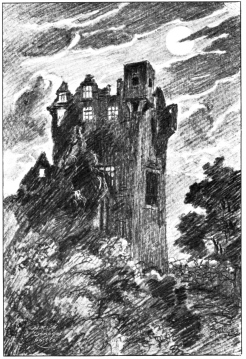
DONEGAL CASTLE.
{198}
{199}
can live far away from a great city and yet never miss its whilom
attractions.
With many other places similarly situated, a run “up to town” is
inevitable and necessary; here, one is apparently as completely isolated
from the distractions of the great world outside as if he were marooned
on a desert isle, with the advantage, however, of being able to get away
at once by means of what, to all appearances, is a toy railway running
to Donegal.
Carrick is another village a little further on and similarly
isolated,—more so, if anything, in that the diminutive engine and its
toy carriages stop, in its not rapid course, at Killybegs, and one
journeys onward by “car.”
To the southward are the heights of Slieve League, Malin Beg and Teelin
Head, and, if one will brave the waves to the extent of rounding these
headlands by boat, he will then experience something of the feeling
which inspired the following lines, which, if rather pretentious, are in
no way fulsome:
“Once seen in morning sunshine, the view of the southern face of Slieve
League, rising steeply from the sea, can never be forgotten;{200} the
impressiveness and matchless colouring of the rock defy description; its
beauty must be seen to be believed. Its glorious colours are grouped in
masses on the mountain’s face: stains of metal, green, amber, gold,
yellow, white, red, and every variety of shade are observed,
particularly when seen under a bright sun, contrasting in a wonderful
manner with the dark blue waters beneath.”
Some one has compared these variegated cliffs to the effects to be seen,
elsewhere, only in the Yellowstone Park and the canyons of Arizona or
Colorado. Those who know Bierstadt or Moran’s paintings of these wonders
of nature, or, better yet, the originals themselves, will appreciate the
comparison.
The festival of St. Adamnan, eighth in descent from the great King Nial
and from Conal, the ancestor of St. Columbkille, is kept with great
solemnity in many churches in Ireland, of which he is titular patron,
and in the whole diocese of Raphoe, in the county of Donegal, of which
he was a native. The abbatial church of Raphoe was changed into a
cathedral soon after, when St. Eunan was consecrated the first bishop.
He originally entered{201} the monastery founded by St. Columba, and became
its fifth abbot. In 701 he was appointed ambassador to King Alfred of
the Northern Saxons, to demand reparation for the injuries committed
upon Irish subjects in Neath. It was St. Adamnan who first prevailed
upon the Church authorities in Ireland to celebrate Easter at the true
and appointed time.
When he died, he left among his effects a treatise on the right time of
keeping Easter, which disposed his people sometime after to forsake
their erroneous computation. He wrote, too, the life of St. Columbkille,
and also certain canons, and a curious description of the Holy Land as
that country stood in his time. This book furnished the Venerable Bede
with his principal memorials.
In this work on the Holy Land, St. Adamnan mentions the tombs of St.
Simeon and of St. Joseph at Jerusalem, and many relics of the passion of
Christ, as well as the impression of the feet of the Saviour on Mount
Olivet, covered with a church of a round figure, with a hole open on the
top, over the impression of the footsteps. He also mentions grasshoppers
in the deserts of the Jordan, which the common{202} people eat, boiled with
oil; and a portion of the Cross in the Rotunda Church in Constantinople,
which was exposed on a golden altar on the three last days of Holy Week,
when the emperor, court, army, clergy, and others went to the church at
different hours, to kiss that sacred wood.
Two landmarks, known to all travellers to the Clyde from America, by way
of the north of Ireland, are The Bloody Foreland and Tory Island.
The guide-books tell but little concerning this wild land of promontory
and cliff, and with some reason, too, for there is little or no
population there, except the fisherfolk and a rather primitive race of
agriculturists.
Donegal is assuredly a land of intermittent beauty, and the
hill-encircled loughs and the verdant glens of Donegal Bay give way here
to a stern, relentless gray stone formation, with here and there patches
of green and purple which indicate nothing so much as the lonesomeness
which is inevitable under such conditions. But there is an
impressiveness in it all which is inexplicable, since the scenery,{203}

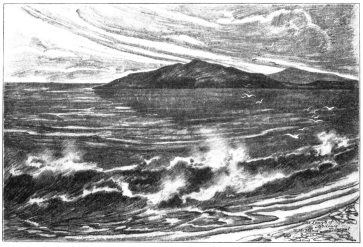
LAKE OF SHADOWS, DONEGAL.
{204}
{205}
though by no means tame, is not of the grandeur of many other parts.
It is doubtful if Tory Island—which is but a mere name, even to the few
who know it at all—will ever be inundated by any large flow of travel.
If it was, there would doubtless be little accommodation provided for
them, for the simple reason that it does not exist, though the island is
possessed of a population of some hundreds of men and women and
children, with schools and a church—in fact two, which are ever a point
of contention and argument among their respective constituencies. It was
not long since that the cleric in charge of one of these houses of God
nearly starved, because he would not desert his post, and “the powers
that be” on the mainland had evidently abandoned him to his fate, or had
forgotten him altogether.
Between the Tory Island and Malin Head, that other beacon-light for
seafarers, is the great inlet or fiord of Lough Swilly, meaning in
Celtic “Lake of Shadows,” which, though quite as beautiful as Lough
Foyle, its neighbour on the east, is, for some unexplained reason, quite
neglected. Of Lough Foyle, at{206} the head of whose ample waters sits that
city familiarly called Derry,—built by certain citizens of London in
the reign of James I.,—Sir Walter Scott has said:
“Nothing can be more favourable than this specimen of Ireland—a
beautiful variety of cultivated slopes, intermixed with banks of wood;
rocks skirted with a distant ridge of healthy hills, watered by various
brooks; the glens or banks being in general planted or covered with
copse.”
This is not a particularly vivid statement, to be sure, but it is true
and temperate, and far more likely to fit in with the views of the
casual observer than the rather florid word-paintings of other parts of
Ireland which have been offered by rhapsodists of all shades of
opinion.{207}
CHAPTER IX.
LONDONDERRY AND THE GIANT’S CAUSEWAY
LONDONDERRY was the original site of an abbey for the canons of the
Augustinian order founded by St. Columbkille in 546. There was also an
abbey for Cistercian nuns founded in 1218, and a Dominican friary
founded in 1274, “by request of St. Dominick,” as the chronicles put it,
whatever significance that statement may have.
Derry, as it is commonly called, owes its name to the confiscation of
the estates of the O’Neills in 1609, most of the lands being bestowed on
various citizens of London. Derry, the ancient name, means “the place of
oaks.” All this part of Ulster was once heavily forested, but it is now
conspicuously bare. Nearly 160,000 acres of the county are still owned
by the Irish Society, while two London livery{208} companies, the Skinners’
and the Drapers’, are also owners of large holdings.
Derry is usually described as “a prettily situated town, built upon a
high hill.” It is quite in keeping with the description, and is also a
place of much interest, as will be found upon a close acquaintance,
though it is unquestionably a curious mixture of old and new, of
foundries, distilleries, and manufactories, which, at every turn, are
contrasted with a celebrity and an interest quite of the past.
Londonderry was formerly fortified, contrary to the usual Irish
conception of military science and architecture, which favoured the
method advanced in the Spartan proverb, “The city is best environed
which has walls of men instead of brick.”
There were originally four gates (afterward six) piercing the city
walls, Bishops Gate, Ships Quay Gate, New Gate, and Ferry Gate.
The Cathedral of Derry is a plain Gothic structure far inferior in rank
and splendour to those of its class in other lands, and dates only from
the early seventeenth century. The episcopal palace occupies the site of
St. Columbkille’s abbey.{209}

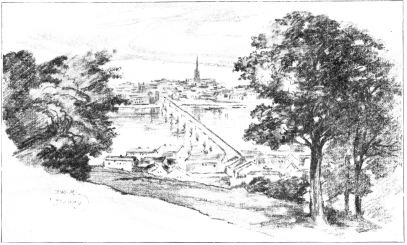
DERRY.
{210}
{211}
The chief event in Derry’s history, and one which is called to the
visitor’s attention at every turning-point and stopping-place, was the
siege so graphically described by Macaulay.
In brief, the event took place thus:
“A letter was sent to the Earl of Mount Alexander at Cumber in County
Down on December 3, 1688, giving the information that six days later
certain numbers throughout Ireland, in pursuance of an oath which they
had taken, were to rise and massacre the Protestants, men, women, and
children. This letter furthermore warned the earl to take particular
care of himself, as a captain’s commission would be the reward of the
man who would murder him.”
The information reached Derry too late to secure the safety of the city.
The terrified Protestants were filled with doubt as to what measures of
precaution should be taken. Two companies of the Irish appeared on the
opposite bank of the stream, and the officers were ferried over to make
proposals for entering the town, which was nearly betrayed into their
hands by the treachery of the deputy mayor, who was inclined to favour
King James II.{212} Impatient for the return of their officers, the soldiers
crossed the river, and came to within three hundred yards of the Ferry
Gate.
“The young men of the city observing this,” says Gordon’s “History of
Ireland,” “about eight or nine of them, whose names deserve to be
preserved in letters of gold, viz., Henry Campsie, William
Crookshanks, Robert Sherrard, Alexander Irwin, James Steward, Robert
Morrison, Alexander Coningham, Samuel Hunt, with James Spike, John
Coningham, William Cairns, Samuel Harvey, and some others who soon
joined them, ran to the main-guard, seized the keys, after a slight
opposition, came to the Ferry Gate, drew up the bridge, and locked the
gate just as Lord Antrim’s soldiers had advanced within sixty yards of
it.”
The siege lasted one hundred and five days, during which time the
townspeople were reduced to the direst extremities. “Reduced,” writes
the historian, “to the extremity of distress, and endeavouring to
support the remains of life by such miserable food as the flesh of dogs
and vermin, even tallow and hides, nor able to find more than two days’
provisions of{213} such substances, the garrison was still assured by the
harangues of Walker, in a prophetic spirit, that God would relieve them;
and men reduced almost to shadows made desperate sallies, but were
unable to pursue their advantage.” The besiegers had thrown a boom
across the river to prevent all navigation, and Kirk, the Orange
admiral, had already been deterred by it from attempting the relief of
the town. At length two provision ships and a frigate drew near to the
city. One ship “dashed with giant strength against the barrier, and
grounded, though subsequently floated out into deep water.”
Nearly twenty-five hundred citizens died of famine or at the hands of
the enemy during the siege.
Near Londonderry is the Grianan of Aillach, upon which are the remains
of what is thought to have been an ancient royal residence which, in
splendour and importance, must have ranked high among the ancient
palaces of the Irish kings.
By some, however, it has been asserted that this remarkable work, of
which, to be sure, only fragmentary ruins remain, was a former{214} temple
dedicated to the worship of the sun. At any rate, it was evidently a
splendid and imposing structure.
Its present appearance is that of a truncated cairn of extraordinary
dimensions, which, on closer inspection, proves to be a building
constructed with every attention to masonic regularity, both in design
and workmanship. A circular wall, of considerable thickness, encloses an
area of eighty-two feet in diameter. Judging from the numbers of stones
which have fallen off on every side, so as to form, in fact, a sloping
glacis of ten or twelve feet broad all around it, this wall must have
been of considerable height, probably from ten to twelve feet; but its
thickness varies, that portion of it extending from north to south, and
embracing the western half of the circle, being but ten or eleven feet,
whereas, in the corresponding, or eastern half, the thickness increases
to sixteen or seventeen, particularly at the entrance.
One of the inevitable illustrations of the old-time school geographies
of our youth was a representation of the “Giant’s Causeway,” with its
queer, hassocklike, basaltic stones,{215} built in fantastic forms, like the
structures children themselves are wont to erect from their
building-blocks.
Next in order come the books of pictorial travel and “table books” of
the “wonders of the world,” where the same picture appears again; and,
finally, the astute proprietors of ardent spirit which is distilled at
Bushmills,—an ancient town of perhaps a thousand inhabitants, between
Portrush, Coleraine, and the basalt-bound coast of Northern
Ireland,—have covered walls and fences with quite the most pleasing and
alluring of all the pictorial representations of this unique rocky
formation.
By these various means, the aspect of “The Giant’s Causeway” has become
familiar to all. So, too, most people are familiar with the chief
characteristics; for which reason it is useless to repeat them in detail
here.
It was in the last years of the seventeenth century that this wonderland
of nature first attracted the attention of the inquisitive, and from
that time on its peculiarities have drawn many thousands of visitors of
all ranks, from the mere pleasure and sensation loving tourist{216} of
convention to the profound scientist and antiquarian.
The five and six-sided basalt rocks are piled perpendicularly one upon
the other, in contrast to most rocky formations, which lie on their
sides, and the varying heights of the columns form those significantly
named groups known as the “Organ and Pipes,” “Samson’s Ribs,” and the
three “Causeways,” the chief of which gives its name to the group.
By those who have delved into the subject, armed with a profound
geological knowledge, plummet and line, and rule and level, we are
informed that “There is only one triangular pillar throughout the whole
extent of the three Causeways. It stands near the east side of the Grand
Causeway. There are but three pillars of nine sides; one of them
situated in the Honeycomb, and the others not far from the triangular
pillar just noticed. The total number having four and eight sides bears
but a small proportion to the entire mass of pillars, of which it may be
safely computed that ninety-nine out of one hundred have either five,
six, or seven sides.”
{217}For a further description, which shall be

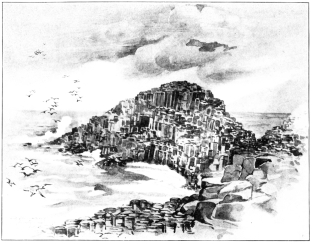
THE HONEYCOMB, GIANT’S CAUSEWAY.
{218}
{219}
brief and to the point, we have the remarks of Köhl, the antiquarian who
devoted so much of his energy to a study of Ireland’s peculiar and rare
beauties.
He says: “With all the explanations that can be offered with respect to
the origin of this phenomena, so much is left unexplained that they
answer very little purpose. On a close investigation of these wonderful
formations, so many questions arise that one scarcely ventures to utter
them. With inquiries of this nature, perhaps not the least gain is the
knowledge of how much lies beyond the limits of our inquiries, and how
many things that lie so plainly before our eyes, which we can see and
handle, may yet be wrapped in unfathomable mystery. We see in the
Giant’s Causeway the most certain and obvious effects produced by the
operation of active and powerful forces which entirely escape our
scrutiny. We walk over the heads of some forty thousand columns (for
this number has been counted by some curious and leisurely persons), all
beautifully cut and polished, formed of such neat pieces, so exactly
fitted to each other, and so cleverly supported, that we might fancy we{220}
had before us the work of ingenious human artificers; and yet what we
behold is the result of the immutable laws of nature, acting without any
apparent object, and by a process which must remain a mystery for ever
to our understanding. Even the simplest inquiries it is often impossible
to answer; such, for instance, as how far these colonnades run out
beneath the sea, and how far into the land, which throws over them a
veil as impenetrable as that of the ocean.”
There are to be found in this group a great number of caves; some of a
unique character, and many more like most other caves, presenting no
striking peculiarity. Portcoon Cave is noted for its echo, and Dunkerry
Cave for the fact that it can only be entered from the sea.
There is a “Giant’s Well,” of course, which legend tells was but one of
the many domestic arrangements which nature had provided for the former
Gargantuan inhabitants of these parts, but the chief of all the
attractions is the Causeway itself, which is divided into three tongues,
the Little, the Middle, and the Grand Causeways.{221}
“The Giant’s Organ,” with its pipes, suggested by the basaltic erections
of various heights, possesses perhaps the greatest sentimental interest.
The guide-books tell one that he should imagine some gigantic personage
seated as if before a keyboard, and ringing out wild melodies in quick
succession. It will take an exceedingly vivid imagination to call up
this inspiration, and one had much better accept the tale as set forth
in the ancient legend, and not attempt to revivify the scene in these
advanced days, when the electric-tram from Bushmills is depositing its
hundreds daily at the very foot of the Causeway.
There are traditions without end which attempt to account for this
wonderful natural production of the Causeway itself, but one shall
suffice here. If the reader wants more he can get them without number
and without end if he will but listen to the voluble guides of the
neighbourhood. The Giant Fin M’Coul was the champion of Ireland, and
felt very much aggrieved at the insolent boasting of a certain
Caledonian giant, who offered to beat all who came before him, and even
dared to tell Fin that if it weren’t for the wetting of{222} himself, he
would swim over and give him a drubbing. Fin at last applied to the
king, who, not daring, perhaps, to question the doings of such a weighty
man, gave him leave to construct a causeway right to Scotland, on which
the Scot walked over and fought the Irishman. Fin turned out victor, and
with an amount of generosity quite becoming his Hibernian descent,
kindly allowed his former rival to marry and settle in Ireland, which
the Scot was not loath to do, seeing that at that time living in
Scotland was none of the best, and everybody knows that Ireland was
always the richest country in the world. Since the death of the giants,
the Causeway, being no longer wanted, has sunk under the sea, only
leaving a portion of itself visible here, a little at the island of
Rathlin, and the portals of the grand gate on Staffa off the Scottish
coast.
This certainly seems an acceptably plausible legend, so far as legends
can meet those conditions. It is certainly a picturesque one, and the
great gateway of the island of Staffa has much if not all the attributes
of its brother across the sea.
As a whole, the Causeways and their attributes{223} are indeed
suggestive—as has been said before by some discerning person—of a
scene from Dante’s Inferno. More particularly they might be likened to a
drawing of Gustave Doré’s, illustrating that immortal poem, as we have
mostly drawn our conception of what that land was like from his work,
rather than from Dante’s descriptions.
At all events, it is a huge nightmare of scenic effect, although a
pleasant one.
Between Portrush, really the seaport of Coleraine, and the Giant’s
Causeway is Dunluce Castle, “the most picturesque ruin ever beheld,”
said an enthusiastic Irishman. As the Scot will tell you the same of
Melrose, the statement may well be left in doubt.
At any rate, Dunluce, like Dunseverick, the ancient seat of the O’Cahans
or O’Kanes, has been in part hewn out of the coast-line rocks, and
possesses a precipitous and jagged barrier which might well be expected
to forbid any attack by sea. It is, moreover, entirely separated from
the mainland, though at low water connected therewith by a miniature
causeway in much the same manner as was originally{224} the famous abbey of
Mont St. Michel in Normandy.
Among the ruins is a small vaulted chamber in which, it is believed by a
great many folk around about, a banshee resides. The reason assigned for
this belief is that the floor is always perfectly clean. It is difficult
to follow this line of reasoning; more probably the true solution of the
problem is that the wind, having free access to and egress from the
apartment, carries dust and dirt before it. Another chamber in the
northeast side has fearful attractions for the venturesome. The rock
which formerly supported this room has fallen away, and, like a dovecot,
it is suspended in the air only by its attachment to the main building.
The erection of Dunluce Castle has been assigned to De Courcy, Earl of
Ulster, and the castle was in the hands of the English in the fifteenth
century. In 1580, or thereabouts, Colonel M’Donald, the founder of the
family of MacDonnells of Antrim, came to Ireland to assist Tyrconnel
against the O’Neill, a powerful chieftain, and was hospitably
entertained by M’Quillan, the Lord of Dunluce,{225} whom he assisted in
subduing his savage neighbours. Being successful in their enterprise,
M’Donald returned to Dunluce, and was pressed to winter in the castle,
having his men quartered on the vassals of M’Quillan. M’Donald, however,
took advantage of his position as a guest, says history, and privately
married the daughter of his host. Upon this marriage the MacDonnells
afterward rested their claim to M’Quillan’s territory. A conspiracy
among the Irish to murder the Scottish chief and his followers was
discovered by his wife, and they made their escape, but returned
afterward and came to possess a considerable portion of the county of
Antrim. The affairs of the M’Quillans and their successors, the
MacDonnells, have left endless traditions, but the descendants of the
former are now no more known as “kings and lords,” having fallen to the
condition of “hewers of wood and drawers of water,” says a local
historian. The Scottish family became lords of Antrim and Dunluce.
In the autumn of 1814 a visit was paid to the ruins of Dunluce by Sir
Walter Scott, who observed a great resemblance in it to Dunottar{226} Castle
in Kincardineshire. A detailed description of the ruins is given in his
diary.
Just off the Giant’s Causeway is Rathlin Island, between which and the
Mull of Cantyre on the Scottish coast all the Clyde-bound ships feel
their way and the traveller by sea knows that he is well in toward the
Firth of Clyde. Rathlin Island may naturally enough be presumed to be of
the same strata of rocky formation of which the Causeway is built,
practically a link which once may have bound Ireland and Scotland.
Robert Bruce, in 1306, during the wars between him and Baliol, fled to
this island with three hundred men, returning to Scotland in the spring
of the following year. A ruined castle, said to be inhabited by Bruce,
and still bearing his name, is situated on a high, almost perpendicular
piece of land, and from it may be obtained a view of the Scottish coast.
Many of the inhabitants, who number above a thousand, speak only the
ancient Irish language.
All the world knows Carrick-a-Rede and its famous rope-bridge. It has
even been pictured in the school geographies along with such wonders of
the world as Niagara Falls and the{227}

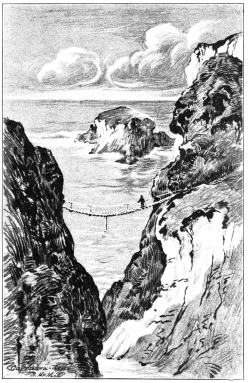
CARRICK-A-REDE.
{228}
{229}
Pyramids of Egypt. It is a precipitous island-rock, a hundred feet or
more high, which is linked to the mainland by an airy swinging bridge of
ropes and “slats,” sixty feet long. There are no sights on the tiny
island itself, and the bridge is only meant for the accommodation of
fisher and shepherd folk, who, according to the guide-books, run across
it heavily laden with baskets or carcasses, and in a manner amazing to
the ordinary beholder. In practice, or at least so far as the casual
traveller is concerned, they do this only as a sort of side-show before
an appreciative audience who may have paid the price of admission.
Nevertheless, it is a more or less frightful crossing, and one which
seems to fascinate all who view it; so much so that the desire to
emulate the venturesome native rises high in the stranger’s breast.
There is no hand-rail to the bridge, only a rope that swings clear away
from the slight foothold if it is heavily grasped; and each step makes
the whole fabric quiver like a jelly from end to end. Still, by stepping
quickly and lightly, and keeping the eyes fixed on the opposite rock,
the pass can be made; and if the venturesome traveller{230} misses his
footing, and takes a header of a hundred feet, “he will not be drowned,”
says the enterprising writer of a certain railway-guide; “the fall
generally kills him outright.” The return journey is the worst, the
bridge sloping downward toward the mainland. The local fisher-people,
however, are quite accustomed to getting out boats in order to release
some unlucky voyager from imprisonment on the rock, when discretion has
suddenly over-powered valour at the commencement of the return trip; but
again it is a question of price. It will be gathered from the above that
the writer’s advice, concerning the crossing of the rope-bridge, is
paraphrased in one word, “Don’t.”{231}
CHAPTER X.
ANTRIM AND DOWN
JOURNEYING from the Giant’s Causeway to Belfast and Dublin, through the
north-eastern counties of Antrim and Down, one comes upon a region
little known to the casual traveller, who is usually smitten at once
with the charms of Killarney and the South, and who neglects this more
conveniently and comfortably traversed region.
Truth to tell, the large centres of population of Dublin and Belfast,
and sundry visitors from the “Midlands” of England, have appropriated it
as their own playground, and, “in the season,” are found here in large
numbers.
This need be no detraction from the charms of the region, which, if not
historically and picturesquely possessed of the same qualities as the
middle and south of Ireland, at least has{232} the advantage of being an
unworn road to the majority of travellers.
Drogheda, on the estuary of the river Boyne, is the first happy
hunting-ground for the student of history and architecture, after he
leaves the immediate environs of Dublin itself.
Drogheda is at once ancient and modern. Its shops and factories, its
shipping and its tramways, are evidences of that modernity which is ever
obtrusive in an old-world shrine of history.
Drogheda, according to one authority, was formerly called Tredagh, and
originally Imbbar Colpa. “It is so very ancient that it is supposed to
have been founded by Heremon, one of the sons of Milesius, who, having
arrived from Spain with Heber and his other brothers at Imbbar Sceine
(Bantry Bay), was subsequently separated from Heber by a storm, and,
while Heber regained the Kerry coast, Heremon, after innumerable
hardships, put into Drogheda, where he effected a landing, but with the
loss of his brothers and Colpa, the swordsman, who perished in the bay,
and from which circumstance the town derived its name.” Thus writes
Anthony Marmion, in{233} his “History of the Maritime Ports of Ireland.”
“There can be no doubt,” he continues, “that an eastern colony of
Mithraic, or sun-worshippers, had been early established in the
neighbourhood of Drogheda.” Coming, however, to less remote and fabulous
happenings, Drogheda, whose Irish name was Droiceheadatha, the Bridge of
the Ford, was taken by Turgesius the Dane in 911, and made a stronghold
for raids into the surrounding country. Its importance was also
recognized by the Anglo-Normans, who built a bridge across the Boyne at
this point. The most celebrated military event in the town’s history was
its siege and capture by Cromwell in 1649.
The walls and gates, so unusual in Ireland, were formerly a line of
defence a mile and a half or more in circumference, and, from the very
substantial remains of the St. Laurence Gate and the West or Butler
Gate, it may be inferred that they were a wonderfully effective defence,
sharing with the walls of Derry the glory of being the most elaborate
works of their kind in Ireland.
The most curious architectural embellishment of Drogheda is the famous
Magdalen{234} steeple—all that remains of the Dominican Abbey founded in
1224 by the Archbishop of Armagh, whose remains lie buried in the ruins.
Here, in 1395, Richard II. of England held court, and within the
building four Irish princes did homage to the king, and were knighted by
him. Cromwell’s cannon razed the building until only the grim, gaunt
tower or steeple was left. A sepulchral cairn of stone, known as the
Mill Mount, appears to have been the ancient citadel of Drogheda. A
mythical hero of the prechristian era, “Ghoban the Smith,” is supposed
to have been buried here.
North of the Boyne estuary is Dundalk Bay, in itself a beautifully
disposed body of water which, if not possessed of the ruggedness of the
fiords of Western Ireland, is in every way an attractive setting for
Dundalk itself, which is mostly a town of one long vertebrate street
along which short spines radiate for a brief distance and lose
themselves in the background of hills or in the strand of the sea.
Edward Bruce, the brother of the Scottish Robert, stormed Dundalk after
Bannockburn, and lived here, after taking the town, for two{235} years. He
died in the engagement fought near Dundalk with the English army, in
1318.
In 1649 Monk held the town for the king against Cromwell.
At the head of Carlingford Lough is Newry, pleasantly situated in a
valley overlooked by the Carlingford Mountains. It is one of the most
ancient towns in the island, being famed even in Irish bardic
literature. It was also the seat of a monastery, where St. Patrick
himself, it is said, planted a yew-tree, referred to in no complimentary
strain in Swift’s satiric couplet:
“High Church, low steeple,
Dirty streets, and proud people.”
Newry took to itself the admonition, cleaned itself up in later years,
and has become in all respects a flourishing modern town.
A Cistercian abbey was founded here in 1175, according to the
“Monasticum Hibernica,” but no remains exist to-day to suggest its
former importance.
Rostrevor is the chief tourist centre of Carlingford Lough. It is
confidently claimed{236} by many to be the most popular resort in all
Ireland, which it evidently is.
Moreover, it is a marvellously pretty place of the stage-scenery order,
but its attractions are somewhat exaggerated. Its popularity is
accounted for by its accessibility to Dublin and Belfast, whose
work-worn habitants flee here in large numbers, in season and out.
Rostrevor, as might be expected, has its popular legend also. It runs as
follows:
“The Bell of St. Bronach, now to be seen on the altar of the Catholic
Chapel, has a strangely romantic history. There is a ruined Church of
Kilbroney on the hillside, not far from the town. For hundreds of years,
the legend of a fairy bell had been current about Kilbroney. It was said
that, whenever misfortune threatened the town, the note of a strange,
silvery, unearthly sounding bell echoed through the forests. Many heard
the bell, but no one succeeded in solving the mystery, or indeed, ever
suspected that there was any solution save a supernatural one. In the
end of the eighteenth century, however, an ancient tree was blown down,
and, in its hollow heart, was found a bronze church-bell of immense{237}
size and of great antiquarian value. It was this bell, hidden in the
heart of the tree many centuries before, that had sounded its note of
death and terror, whenever a storm of unusual force rocked the great
tree in whose depths it lay concealed. No doubt it had been hidden in
the tree for safety, during some raid of pagan tribes, and by accident,
or through the death of the pious ecclesiastic who concealed it, was
never removed.”
Carlingford itself, and the celebrated beauty of the Lough, will ever
appeal to all lovers of nature and romantic associations.
The great attraction is Carlingford Castle, one of King John’s Irish
fortresses, erected in 1210 by De Courcy at the king’s bidding. Some
ruined castles are interesting, some rather the reverse. Carlingford
Castle belongs to the former class. The courtyard, with its walls eleven
feet in thickness, and galleries fitted with recesses for archers at
each loop-hole; the curious little secret chamber, which one may reach
by climbing up a wall, and through a mass of tangled ivy; the spiral
staircase winding up to an airy battlemented height; all these are as
interesting as they are{238} picturesque. Underground, there is a range of
small, gloomy dungeons, hewn out of the solid rock, where many a gallant
life must have been worn away in bitter agony and despair, seven
centuries ago, in those times when chivalry and romance were
inextricably mixed with brutality. Just above the dungeon-cells runs the
ruined stone terrace, looking out to sea, where (tradition says) the
lords and ladies who accompanied King John to Ireland used to walk up
and down of a summer evening, in the cool of the sunset wind. This of
course is most probable, and it is perhaps a not unusual proceeding,
still it is pleasant to recall. The lute must often have sounded across
the waters of the lough in those golden evening hours, the careless
laugh rung out, the silken cloak swung, and the gauzy veil fluttered
from the high “sugar-loaf” head-dress, within sound of clanking chains,
and cries from half-maddened, famishing, and tortured wretches below.
One need go no deeper into history than any account of King John, to
understand what kind of treatment his prisoners were likely to receive.
Greenore, at the mouth of Carlingford{239} Lough, is the key to the
passenger traffic between England and Belfast, Londonderry, Enniskillen,
and other places in the north and northwest of Ireland. It is a
remarkable fact that the strategic importance of Carlingford Lough
should be thus recognized in a peaceful fashion at the end of the
nineteenth century; for one recalls that the ruined castles at
Carlingford and Greencastle were built by the Anglo-Normans, at the
close of the twelfth and beginning of the thirteenth centuries, to
protect their lines of communication when invading, in a far different
and more tragic fashion, the hills and dales of Ulster. The frowning
ruins of Carlingford Castle still seem to guard the western shore of the
lough, while the fortress of Greencastle, on the eastern shore, commands
a glorious view from its lofty battlements.
Greenore supposedly presents many attractions for the tourist, but they
are mainly of the kind set forth in the tourist programmes of the
shipping companies and the railways, and, in fact, they are but of the
conventional variety, though it is only fair to say they are here
perused under very attractive and charming{240} conditions. But the various
journeyings of the collaborators to this volume were not for the sake of
sea-bathing, golf, or tennis; hence Greenore is now dismissed—and
gladly.
The railway runs the length of Carlingford Lough, along the base of
Carlingford Mountain, which rises to nearly two thousand feet, to Newry
at the head of the Lough, where, on a rock which projects into the
river, stands Narrow Water Castle, built in 1663 on the site of a
thirteenth-century edifice erected by Hugh de Lacy.
Ardglass, between Carlingford and Belfast Loughs, is seldom heard of in
literature or the news items of the daily press; but it is a quaint
little town of half a thousand inhabitants situated on the seacoast,
with Dundrum Bay and the Mourne Mountains of County Down for a
background.
Once it was the chief port of Ulster (its name, Ard-glas, means the
green height), and was so important a town that it was guarded by seven
castles, but one of which, Jordan’s Castle, is to-day in any state of
preservation.
The county town of Down is Downpatrick. It is ancient and historic, and
has a prospect,
{241}
{242}

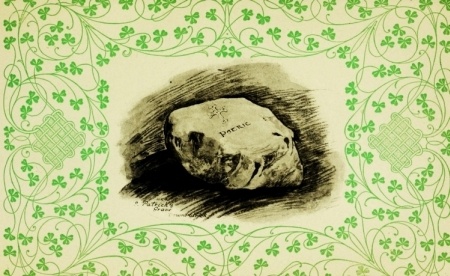
Grave of St. Patrick, Downpatrick
{243}
on the river Quoile, which shows off its imposing cathedral in a most
pleasing manner.
The native Kings of Ulster had their residence here before the coming of
Christianity. The town was known anciently to Ptolemy, who called it
Dunum.
The religious foundation of the place dates from 432 to 440, when St.
Patrick established the see and the Abbey of Saul of the Canons Regular,
who was superceded in 1183, a few years after the town was taken by John
de Courcy, by the Benedictines.
The cathedral of to-day is a rehabilitation of an ancient ecclesiastical
building, though to all appearances it is a comparatively modern work
and is often credited as such.
Locally, great importance is naturally attached to the supposed fact
that Downpatrick is the burial-place of St. Patrick, and a rough, unhewn
boulder marks the spot in the churchyard where his bones rest—or do not
rest, for there is great and constant doubt as to whether this is really
so or not. However, there are, it is to be presumed, many who would like
to believe they had visited such a{244} hallowed spot, and perhaps for this
reason the want has been supplied.
Moreover, in the old church which stood on the site of the present
cathedral, which Harris, the antiquarian, described in 1744, there was
an inscription in monkish Latin which, translated, reads:
“Three saints do rest upon this holy hill,
St. Patrick, Bridget, and Columbkille.”
This would seem to justify in a measure the claim, though the rhyme is
pretty bad.
Jeremy Taylor was for a time Bishop of Down, as was also Thomas Percy,
celebrated for his famous edition of the “Reliques of Ancient Poetry.”
There are many historical and ecclesiastical remains in the immediate
neighbourhood, including the Cistercian Abbey of Inch, founded in 1187
by John de Courcy, and the celebrated Wells of Struell, supposedly of
great virtue for the lame, the halt, and the blind. To-day their
efficacy seems somewhat dimmed, as one does not hear of any remarkable
cures which have recently taken place.
About the only convenient way to reach{245} Armagh,—Ireland’s most ancient
and famous seat of learning,—when making the coast tour of the north of
Ireland, is from Belfast.
Armagh, about which so much has been written by all manner of
pen-wielders, and about which so much is yet destined to be written, is
one of the most attractive towns in Ireland, albeit it is not on the
seacoast or on an important waterway.
Newcastle, in the minds of many, is merely the home of “The best
golf-links in Ireland.” This is perhaps a sign of the advanced age in
which we live, but Newcastle, forty miles north of Dublin, can lay claim
to more than that.
Newcastle, as a tourist point and “a beauty-spot,” really exists by
means of, and on account of, Slieve Donard, the highest mountain in
Ulster, which hangs its 2,796 feet right over the little seacoast town,
and provides non-golfing visitors with a continual field for pleasant
excursions. The beautiful estate of Donard Lodge lying on the slope of
the mountain is, too, a great attraction, as also are Castlewellan, the
seat of the Earl of Annesley, and the Earl of Roden’s domain of
Tollymore Park; and as these three estates enclose or command most{246} of
the beautiful mountain and forest scenery for which Newcastle is noted,
they really form the irresistible attractions of the place. The whole
range of the beautiful blue Mourne Mountains can be seen from
Castlewellan, which lies on the side of Slieve-na-Slat.
Not far from Newcastle is Rostrevor, a pretty ittle village with a
church-spire nestling among the trees and overhanging the picturesque
coast-line of Carlingford Lough.
Much morbid interest is usually awakened by the recollection of certain
events which took place in the neighourhood. At Bloody Bridge was a
terrible massacre in 1641; Mourne Park and Mourne Abbey are generally
famous spots; the village of Killowen, from which the late Lord Russell
of Killowen chose his title, contains the house where Pat Murphy, the
Irish giant, was born, and the ruined chapel where the celebrated
Yelverton marriage took place in 1861.
Many will recall the details of this famous cause célèbre. Pretty Miss
Longworth, a Roman Catholic girl of high family, met and was loved by
the Protestant Major Yelverton, whom she nursed in the Crimea. A secret{247}
marriage was arranged after both had returned to Ireland, and a hurried
journey was made from Waterford to Rostrevor. They rowed down the lough
to the little chapel next morning, and were married by the parish
priest. In after years came the desertion of the bride and an action for
maintenance, which was decided by an Irish jury in the lady’s favour,
but subsequently reversed by the House of Lords. Probably no
mixed-marriage case ever excited so much interest in the three kingdoms,
and even yet the chapel and the village are inextricably associated with
this sad story of love and betrayal.{248}
CHAPTER XI.
THE BOYNE VALLEY
DROGHEDA, at the mouth of the Boyne, first calls to mind the memorable
siege by Cromwell, and the “Battle of the Boyne.” In 1649 Cromwell
landed at Dublin with an army of twelve thousand men besides artillery.
Drogheda was the first place he attacked. The assailants were twice
repulsed, but the third attack, led by Cromwell in person, was
successful; and then commenced that indiscriminate slaughter which has
rendered the name of the Protector execrated throughout Ireland.
It was a plain, matter-of-fact, brutal warfare, this, but the battle of
the Boyne—associated with the doubly historic little river which rises
out of one of Ireland’s famous “holy wells,” in the county of
Kildare—possesses more largely the elements of romance{249} than many
another, though they were more bloody and the results of greater moment.
Here, within a mile of Drogheda, where the unlovely obelisk still marks
the spot, was fought, in 1690, the celebrated battle between the Prince
of Orange and his father-in-law, James II. The armies were nearly equal
in strength, thirty thousand men. Five hundred were killed on the side
of William of Orange, and one thousand on the other. The account of the
flight of James II., taken from Köhl’s “Ireland,” is interesting:
“James II. displayed but little courage in this memorable battle. He
abandoned the field even before the battle was decided, and made a ride
of unexampled rapidity through Ireland. In a few hours he reached the
castle of Dublin, and in the following day he rode to Waterford, a
distance of one hundred English miles. Nevertheless, James sought to
throw the whole blame of the defeat on the Irish. On arriving at the
castle of Dublin, he met the Lady Tyrconnel, a woman of ready wit, to
whom he exclaimed, ‘Your countrymen, the Irish, madam, can run very
fast, it must be owned.’ ‘In this, as in every other respect,{250} your
Majesty surpasses them, for you have won the race,’ was the merited
rebuke of the lady.”
An obelisk to-day marks the spot where William commenced the attack, and
where Schomberg fell. The inscription which it bears is significant,
sectarian, and sentimental, it is true; but it is explanatory of much
that makers of guide-books have often neglected or ignored.
“Sacred to the glorious memory of King William the Third, who, on
the first of July, 1690, passed the river near this place to attack
James the Second at the head of a Popish army, advantageously
posted on the south side of it, and did on that day, by a single
battle, secure to us, and to our posterity, our liberty, laws, and
religion. In consequence of this action James the Second left this
kingdom and fled to France.
“This memorial of our deliverance was erected in the 9th year of
the reign of King George the Second, the first stone being laid by
Lionel Sackville, Duke of Dorset, Lord Lieutenant of the Kingdom of
Ireland.
“1736.”
The entire Boyne valley, restricted though its area is, encompasses much
more of the historic past of Ireland than any other spot.{251} There may
elsewhere be grander scenery,—admittedly there is,—and there may even
be more numerous historic remains, and of greater magnitude; but from
Drogheda to its source in Kildare is a grand succession of spots which
have made much history for Ireland, and great fame for those who figured
in the events that took place.
The great figure of prechristian Erin is undoubtedly that of
Cormac-Ard-ri-Cormace the First, who reigned in the early years of the
third century.
“His reign,” says Haverty, the historian, “is generally looked upon as
the brightest epoch in the entire history of pagan Ireland.” He
established three colleges; one for war, one for history, and the third
for jurisprudence. He collected and remodelled the laws, and published
the code which remained in force throughout all Ireland until the
English invasion (a period extending beyond nine hundred years), and
which, outside the English pale, lingered for many centuries after! He
assembled the bards and chroniclers at Tara, and directed them to
collect the annals of Ireland, and to write out the records of the
country{252} from year to year, making them agree with the history of other
countries, by collating events with the reigns of contemporary foreign
potentates, Cormac himself having been the inventor of this kind of
chronology. If this be so, the modern historians who claim to have been
the originators of this cochronological scheme have an apology to make.
These annals formed the “Psalter of Tara,” which also contained full
details of the boundaries of provinces, districts, and small divisions
of land throughout Ireland. Unfortunately, this great record has been
lost, no vestige of it being now, it is believed, in existence.
The magnificence of Cormac’s palace at Tara was commensurate with the
greatness of his power and the brilliancy of his actions. He fitted out
a fleet which he sent to harass the shores of Alba or Scotland, until
that country also was compelled to acknowledge him as sovereign. He
wrote a book, or tract, called “Teagusc-na-Ri,” or the “Institutions of
a Prince,” which is still in existence, and which contains admirable
maxims on manners, morals, and government. He died A.D. 266, at
Cleitach, on the Boyne, a salmon-bone, it is{253} said, having fastened in
his throat while dining, and defied all efforts at extrication. He was
buried at Ross-na-Ri, the first of the pagan monarchs for many
generations who was not interred at Brugh, the famous burial-place of
the prechristian kings.
Ferguson’s poem, classically entitled “The Burial of King Cormac,”
recounts the incident of his death at length, and picturesquely.
Cormac must have been altogether a glorious personage, judging from a
description which has come down to us from an ancient Irish MS.:
“Beautiful was the appearance of Cormac (this was before he lost his
eye) in that assembly. Flowing, slightly curling hair upon him; a red
buckler with stars and animals of gold and fastening of silver upon him;
a crimson cloak in wide, descending folds upon him, fastened at his
breast by a golden brooch set with precious stones; a neck-torque of
gold around his neck; a white shirt with a full collar, and intertwined
with red-gold thread upon him; a girdle of gold inlaid with precious
stones around him; two wonderful shoes{254} of gold with runnings of gold
upon him; two spears with golden sockets in his hand.”
This, then, is the description of the royal Cormac with his curling,
golden hair and opulence of barbaric trappings, and the scenes over
which he presided were surely in keeping with his magnificence, though
only by a strong effort of imagination can they now be recalled.
The chief and most splendid structures of the interior of Ireland in
ancient times were Emania and Tara. The former, the one-time palace of
the kings of Ulster, was alleged to have been built about three hundred
and fifty years before the Christian era. It existed as late as
Columba’s time, though it had ceased to be a royal residence; and the
antiquarians, Camden and Speed, attest that fragmentary remains of this
splendid establishment existed even in their day (seventeenth century).
If this be really so, the ruin, if it could even be called by so
explicit a name, must have been one of the most ancient existing in
northern climes.
Tara was a place of greater, and yet more modern, celebrity. It was
situated in the plain of Bregia, which extended between the Boyne,
{255}
{256}

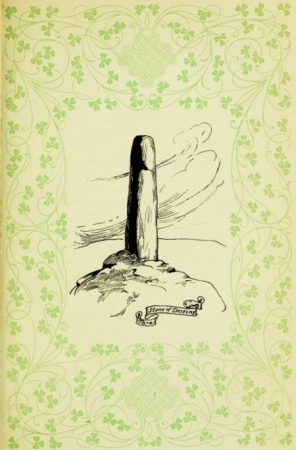
The Stone of Destiny, Tara
{257}
the Liffey, and the sea, and was preëminent above all other edifices as
having been the residence of Irish kings for upwards of a thousand
years.
A contributor to the “Transactions of the Royal Irish Academy,” writing
in 1830, has described Tara as it appeared to him on a recent visit:
“Only when one finds himself at the base of the venerable mount does it
present an attitude of much interest. At the left are the gloomy remains
of the church of Screen and the once noble mansion and demesne of Lord
Tara, back of which are the remains of several old stone edifices and of
a particularly narrow bridge which still spans a weedy rivulet. Passing
through the villages and by the church, one identifies some large rocks
as having exercised the strength or yielded to the sword of Fin
MacComhal (Fingal). Here one finds himself on the summit of Tara; and if
he goes there with none of that wild enthusiasm which requires towers
and battlements and draw-bridges and bower-windows, and donjon-keeps, to
gratify it, he will feel most awfully the unalterable royalty of the
prospect it commands.{258}
“When the natural advantages of the scene have obtained their due
homage, let the visitor look for vestiges of the past, and there he will
not be disappointed; for the place seemeth to bear the shew of an
ancient and famous monument.”
All of which observations are sufficiently noncommittal to be
undisputed; and unless one is an arrant idol-breaker,—and we haven’t
many in these days,—he will be quite willing to accept the description
as being sufficiently explicit to permit of his putting himself in the
same place, and making the same observations.
The site is assuredly authentic, and the link of history which binds its
past with the present is something more than a suggestion; though by no
means need we seek or envy the emotions which inspired Moore’s verses:
“The harp that once through Tara’s Halls
The soul of music shed,
Now hangs as mute on Tara’s walls,
As if that soul were fled,—
So sleeps the pride of former days,
So glory’s thrill is o’er,
And hearts that once beat high for praise,
Now feel that pulse no more.{259}
“No more to chiefs and ladies bright
The harp of Tara swells,
The chord alone, that breaks at night,
Its tale of ruin tells.
Thus freedom now so seldom wakes
The only throb she gives,
Is when some heart indignant breaks
To show that she still lives.”
Near Drogheda is Monasterboice, a collection of celebrated
ecclesiastical ruins. Within an enclosed churchyard, which stands quite
apart from any settlement of to-day, are two tiny chapels, a round tower
of considerable proportions (110 feet high and 50 feet in circumference
at its base), and three stone crosses, the principal of which, known as
St. Boyne’s Cross, is reputedly the most ancient religious relique now
standing in Ireland. Among its rude sculptures, there is an inscription
in Irish characters, in which is plainly legible the name of Murelach,
a king of Ireland who died in 534, about one hundred years after the
arrival of St. Patrick. The height of this cross is twenty-seven feet,
and it is composed of two stones. The shafts are divided into
compartments ornamented with figures. One group represents “a couple of{260}
harpers in paradise,” of which Köhl says: “No Irishman of the olden
times would have thought paradise complete without his beloved national
instrument.”
This recalls Lover’s verses, but whether or no so rude a symbolism
inspired them it is impossible to state.
“Oh! give me one strain
Of that wild harp again,
In melody proudly its own,
Sweet harp of the days that are gone.”
The entire region of the Boyne valley is rich in tradition and history,
far more so than any other area of its size in Ireland.
From Drogheda, at the river’s mouth, to Trim, just beyond Tara, and to
Kells on the Blackwater (not to be confounded with the Blackwater of the
south), the Boyne’s chief tributary, is scarce fifty miles; but there
are a succession of shrines of history of which even the most unfamiliar
are household words.
At Trim one is in the midst of military and ecclesiastical ruins which
will make the lover of architectural remains long for the opportunity of
knowing them better. There is the{261}

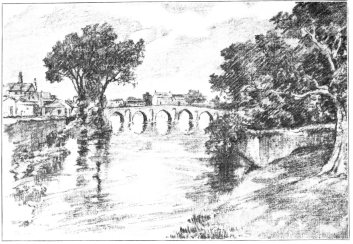
TRIM.
{262}
{263}
usual “King John’s Castle,” in reality Dangan Castle, an ancient
military erection of the De Lacys, commonly called, and apparently with
justification, “the finest example of Anglo-Norman military architecture
in Ireland.”
It was founded in 1170 by the De Lacy who was given, by Henry II., the
lordship of Meath, one of the five original kingdoms of Ireland.
The original structure was burnt to prevent its falling into the hands
of Roderic, King of Connaught. The present remains date from 1220, and,
though locally known as “King John’s Castle,” the records tell us that
the monarch himself is only known to have visited Trim for but two days;
hence his occupancy, if not his actual proprietorship, was very brief.
It must, truly, have been formerly a magnificent work of its kind, its
shape being triangular, as is that noblest of all Anglo-Norman castles,
Chateau Gaillard in Normandy.
Ten flanking towers protected its gateways, which, in their turn, were
preceded each by a barbican. The most imposing of its details, which is
more or less intact, is the keep, a massive tower sixty-four feet square
and sixty feet in height. In this detail it differed greatly{264} from its
Norman brothers and sisters: in that at Chateau Gaillard, and others in
Normandy, the keep was invariably circular.
Trim’s ecclesiastical history dates back to the foundation of a church
here by St. Patrick in the fifth century. Its site is perpetuated to-day
by the famous Yellow Tower of the church of St. Mary’s Abbey, the most
lofty Anglo-Norman erection in Ireland (125 feet). Its outlines and
stages were reduced nearly to ruin by Cromwell’s warriors, but enough
remains to-day to suggest that its former functions of watch-tower and
refuge must have been most efficient.
“Literary pilgrims” will be more interested perhaps in visiting the tiny
parish of Laracar, so indelibly associated with the lives of Swift and
his “Stella.” It lies but two short miles south of Trim, and is still
one of those delightful, unspoiled, old-time villages which one
occasionally comes across. Swift was the incumbent of this parish in
1699, and “Stella,” chaperoned by Mrs. Dingley, was quartered here in
lodgings. The ladies moved into the glebe-house, so literary gossip
says, when Swift was on his travels, and the “Journal to Stella”{265} was
addressed there. Swift’s house, now but a fragment of a ruin, remains,
as also the church in which “dearly beloved Roger” was clerk.
Down the Boyne from Trim one comes first to Bective Abbey, which,
according to a local authority, differs from every other monastic
establishment in the kingdom, in that it was a monastic castle or
fortress. It was a Cistercian foundation of the twelfth century, first
endowed by O’Melaghlin, a prince of Meath. It is a fine ruin to-day,
and, although the parts of its original outlines are somewhat lost, the
pointed fenestration is remarkable and unusually well preserved. Hugh de
Lacy, after his assassination at Durrow Castle, was brought here for
burial, but his head was interred in the tomb of Rosa de Monmouth in the
Abbey of St. Thomas at Dublin.
Here one is in the immediate vicinity of Tara and its famous hill, the
site of Ireland’s most celebrated and splendid kingly residence.
Between Tara and Kells is Navan, which, of itself, is an ordinary
“market town,” with nothing to commend it to the lover of beauty and
history but its immediate vicinity to the{266} junction of the rivers
Blackwater and Boyne. This particular spot, just below Navan, is one of
exceptional charm, though, as has been truly said, “the people of Navan
have turned their backs upon it,” and from scarce a spot in the town
itself can a glimpse of either stream be had.
Navan has a past decidedly more interesting than its present. Its
ancient patronymic was Nuachongbhail, and it was one of the earliest
fortified places in the county of Meath. Hugh de Lacy walled it around;
but remains of this work have now almost disappeared, though there are
still some very tangible evidences of the “earliest style of
fortifications known in Erin” in the Great Moat of Navan.
The Round Tower of Donaghmore, the most perfect of its kind in Ireland,
and the ruins of Donaghmore church, are near by. Professor Flinders
Petrie ascribes the date of the tower to the tenth century. It is one
hundred feet in height, and its base circumference is sixty-six and a
half feet. He further describes the remarkable doorway as having “a
figure of Our Saviour, crucified, sculptured in relief on its keystone
and the stone immediately above
{267}
{268}

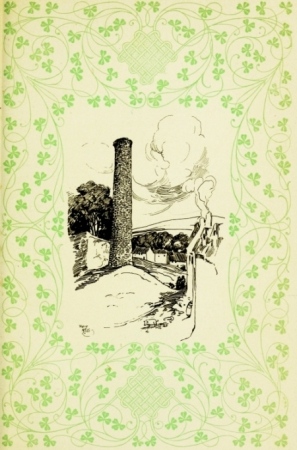
The Round Tower, Kells
{269}
it.” This fact should establish beyond all doubt that the motive of
these great round towers of Ireland, or at least of this particular one,
was Christian and not pagan.
One is bound to visit Kells if only to take cognizance of its famous
market-cross. Kells, in the county of Meath, is, or should be, coupled,
in the minds of visitors, with the name of Tara. They have nothing in
common, but they are neighbours, and properly should be seen in
connection with each other. Tara presents, at first glance, nothing more
than a small conical elevation rising above the Boyne; but its memories
as the residence of the magnificent Cormac, St. Patrick, the Druids, the
law-givers, the bards, and all the ancient prehistoric civilization
which centred around it, are very great.
Kells is a dozen or more miles from Tara, and should not be confounded
with Kells in Kilkenny. Kells was granted to St. Columba in the sixth
century, and a small house still exists which is fondly believed to have
been either the oratory or the residence of the saint.
In the market-place of Kells was built a castle, in 1178, and opposite
to it was erected{270} a stone cross, reputedly the most beautiful of its
class known. As to just what was the precise and full significance of
these famous crosses, which abound in Ireland, authorities, self-styled
ecclesiastical experts, and genuine archæologists alike, fail to agree.
Certainly nothing has puzzled people more than the scenes depicted on
the bases of some of the crosses. At Kells, for instance, there is, on
one side of the base, a hunting-scene, where a man with a shield and
spear, preceded by a dog, pursues a collection of animals, among which
we may distinguish two stags, a pig, a monstrous bird, and three other
animals. On another side there are two centaurs, one armed with a
trident, the other with bow and arrow, and having a bird on its back.
There also is a bird with a fish in its talons, and another bird on a
quadruped of some kind. On the third side there is a contest between
foot-soldiers, and on the fourth a procession of four mounted warriors.
Primarily, of course, the significance of these crosses was Christian,
but whether or not of the superstitious order, as were the gargoyles and
grotesque water-spouts seen so{271}

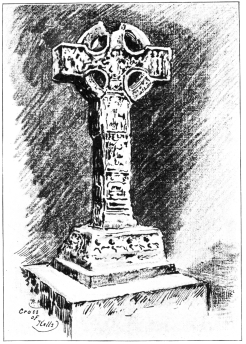
THE CROSS OF KELLS.
{272}
{273}
frequently on continental churches, is apparently a matter of doubt.
The subjects pictured on many of these crosses can hardly be assumed to
be Scriptural, and are certainly not appropriate to the ideas of
Christian art of our own time, nor indeed with those which were put to
use in churches and monasteries in the Middle Ages. It has been
suggested that they represent lingering pagan notions of the Happy
Otherworld of the Celts, since hunting and fighting were among their
principal joys; but this again is mere conjecture, and, though pagan
influences had perhaps not wholly died out when this cross of Kells was
first set up, it is hardly likely that pagan enthusiasm would express
itself on a Christian symbol.
The crosses of Monasterboice, Kells, Clonmacnois, and Durrow were all
either in, or on the very border of, the ancient kingdom of Meath, and
may perhaps be grouped together as belonging to a local school which
ranked perhaps above all others in the magnitude and beauty of its
sculpture.
Many other crosses, which once existed throughout Ireland, are now known
only by{274} a broken fragment of the shaft, or a base, which may or may not
preserve the inscription; and it seems quite probable that no
ecclesiastical centre existed which did not, at one time, boast of its
Celtic cross standing as a dominant monument of art among all other
memorials.
The great question which the antiquaries have apparently yet to settle
among themselves is as to whether the decoration of these stone crosses,
so different from other sculptured stone work to be seen in churches and
elsewhere, is really the result of Celtic inspiration, or not.
It certainly is partly Roman and partly Byzantine in its motive, though
unquestionably the development of the idea was distinctively Celtic or
Irish.
From ancient records one learns that the Irish craftsmen first worked
out their ideas, not on stone, but on parchment, and that these were
transferred from illuminated MSS. to the crosses, and again in metal
work, where so many similar designs are seen.
It is a popular supposition that these motives, spirals, frets, and
interlaced bands originated in Ireland or were peculiar to Celtic art.
But{275}

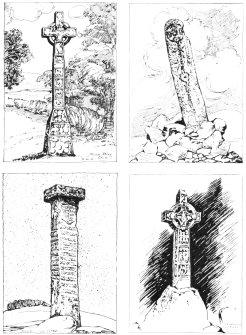
CROSSES OF CLONMACNOIS, DONEGAL, SLANE, AND MOONE
ABBEY.
{276}
{277}
really the origin of these ornaments and their travels from one country
to another show quite the contrary to be the case. Investigation has
shown that early civilization, advancing along primitive trade routes,
or, more generally, on the lines of communication between different
countries or races, was responsible for the diffusion of many arts that
have been wrongly ascribed as having been born in one locality or
another. Scandinavia, Greece, Egypt, and even farther east, all
contributed something, no doubt, to what afterward became known as
Celtic art; just how much, or by what process, is the question to
decide.
At any rate, the result achieved by the artisans who carved these
ancient Irish crosses, whatever may have been their source of
inspiration, indicates that they were the work of no “‘prentice hand.”
It is evident that no mere underling or stone-cutter chiseled out
spiral, fret, and knot, and twisted zoomorph, which one sees on these
crosses. It was a master-mind that planned and a master-hand that drew
the same patterns on many an Irish vellum. And it was in the depth of
the dark ages, too, that Ireland set this bright example to Europe.{278} In
the twelfth century one of her books, then perhaps four hundred years
old, compelled the admiration of Gerald of Wales, in most things her
detractor. “If you examine the drawings closely,” he says, “you will
find them so delicate and exquisite, so finely drawn, and the work of
interlacing so elaborate, while the colours with which they are
illuminated are so blended, and still so fresh, that you will be ready
to assert that all this is the work of angelic, and not human skill.”
This is certainly high praise; but, within its limits, the early Irish
school of decorative art, in its best products, whether on parchment,
metal, or stone, has, of its kind, been hitherto unsurpassed by man.
Though the market-cross of Kells is not perfectly preserved—its top is
broken off—it may be considered, with that at Monasterboice, to be a
remarkable expression of the art of stone-carving. There are a notable
richness and elaboration of detail most curious and quite unique.
In the churchyard are three other crosses of lesser importance, though
one of them is over eleven feet in height.{279}

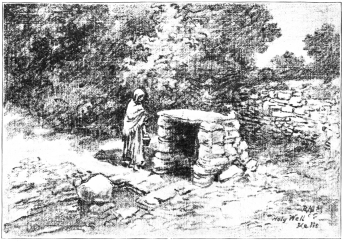
HOLY WELL, KELLS.
{280}
{281}
The famous “Book of Kells,” a manuscript copy of the Gospels in Latin,
dating from the eighth century and described as the “most elaborately
executed monument (sic) of early Christian art now extant,” is
preserved in the library of Trinity College, Dublin.
Next to the idyllic and vague figure of Erin, and the more definite, but
still apocryphal, one of St. Patrick, that of St. Columba, the real
founder of the religious community of Kells, stands out the most
prominently. To his era belonged a glorious race of scholars, all of
whom gained their learning from the many universities, convents, and
monasteries which covered the island. Among those most prominent are the
names, first of all, of St. Columba, or Columcille (Dove of the Cell);
St. Columbanus; St. Gall, who evangelized Helvetia; St. Livinus, who
suffered martyrdom in Flanders; St. Argobast, who became Bishop of
Strasburg; and St. Killian.
Columba’s history is well set forth in sundry places, and is too
extended to recount here. Suffice to say that the events of his life
were most dramatic, and his attachment to learning,{282} poetry, and
literature, in particular, most profound.
Montalembert, the historian, says:
“He was a poet and writer of a high order of genius, and to an advanced
period of his life remained an ardent devotee of the muse, ever
powerfully moved by whatever affected the weal of the minstrel
fraternity. His passion for books (all manuscript, of course, in those
days, and of great rarity and value) was destined to lead him into that
great offence of his life, which he was afterward to expiate by a
penance so grievous. He went everywhere in search of volumes which he
could borrow or copy; often experiencing refusals which he resented
bitterly.”
In the following manner occurred what Montalembert calls “the decisive
event which changed the destiny of Columba, and transformed him from a
wandering poet and ardent bookworm into a missionary and apostle.”
“While visiting one of his former tutors, Finian, he found means to copy
clandestinely the abbot’s Psalter by shutting himself up at nights in
the church where the book was deposited. Indignant at what he considered
as{283} almost a theft, Finian claimed the copy when it was finished by
Columba, on the ground that a copy made without permission ought to
belong to the master of the original, seeing that the transcription is
the son of the original book. Columba refused to give up his work, and
the question was referred to the king in his palace of Tara.”
What immediately followed, and its sequel, should be read in the words
of Montalembert. The accusation of theft, or something akin to burglary,
was followed by Columba’s withdrawal to his native province of
Tyrconnell, where he set to work to excite the natives to proceed
against King Diarmid, who had decided against him.
“Diarmid marched to meet them in battle at Cul-Dreimhne, upon the
borders of Ultonia and Connacia. He was completely beaten, and was
obliged to take refuge at Tara. The victory was due, according to the
annalist Tighernach, to the prayers and songs of Columba, who had fasted
and prayed with all his might to obtain from Heaven the punishment of
the royal insolence, and who, besides, was present{284} at the battle, and
took upon himself before all men the responsibility of the bloodshed.”
As for the manuscript which had been the object of this strange conflict
of copyright, elevated into a civil war, it was afterward venerated as a
kind of natural military and religious palladium. Under the name of
Cathach or Fightu, the Latin Psalter transcribed by Columba, enshrined
in a sort of portable altar, became the national relic of the O’Donnell
clan. For more than a thousand years it was carried with them to battle
as a pledge of victory, on the condition of being supported on the
breast of a clerk free from all mortal sin.
Still struggling with a stubborn self-will, Columba found his life
miserable, unhappy, and full of unrest; yet remorse had even now
“planted in his soul the germs at once of a startling conversion and of
his future apostolic mission.” Various legends reveal him to us at this
crisis of his life, wandering long from solitude to solitude, and from
monastery to monastery, seeking out holy monks, masters of penitence and
Christian virtue, and asking them anxiously what he should do to obtain{285}
the pardon of God for the murder of so many victims as was caused by the
battle of Cul-Dreimhne.
At length, after many wanderings in contrition and mortification, “he
found the light which he sought from a holy monk, St. Molaise, famed for
his studies of Holy Scripture, and who had already been his confessor.
“This severe hermit confirmed the decision of the synod; but, to the
obligation of converting to the Christian faith an equal number of
pagans as there were of Christians killed in the civil war, he added a
new condition, which bore cruelly upon a soul so passionately attached
to country and kindred. The confessor condemned his penitent to
perpetual exile from Ireland!”
This was more hard than to bare his breast to the piercing sword; less
welcome than to walk in constant punishment and suffering, so long as
his feet pressed the soil of his worshipped Erin!
But it was even so. Thus ran the sentence of Molaise: “Perpetual exile
from Ireland!”
Staggered, stunned, struck to the heart, Columba could not speak for a
moment. But{286} God gave him in that great crisis of his life the supreme
grace to bear the blow and embrace the cross presented to him. At last
he spoke, and in a voice choked by emotion he answered: “Be it so; what
you have commanded shall be done.” From that instant his life was one
long penitential sacrifice. For thirty years he lived and laboured in
the distant Iona, and the fame of his sanctity and devotion filled the
world.
As a farewell gift to some Irish visitors at Iona, Columba presented the
following verses, deservedly classed among the world’s beautiful poetic
compositions. The literal translation into English doubtless loses much
of the original beauty, but enough, at least, is left to indicate the
charm of the original Gaelic thought and sentiment.
“What joy to fly upon the white-crested sea; and watch
the waves break upon the Irish shore!
. . . . . . .
. . . . . .
“My foot is in my little boat; but my sad heart ever bleeds!
“
There is a gray eye which ever turns to Erin; but never
in this life shall it see Erin, nor her sons, nor her
daughters!{287}
“From the high prow I look over the sea; and great
tears are in my eyes when I turn to Erin—
“To Erin, where the songs of the birds are so sweet, and
where the clerks sing like the birds;
“Where the young are so gentle, and the old are so
wise; where the great men are so noble to look at,
and the women so fair to wed!
“Young traveller! carry my sorrows with you; carry
them to Comgall of eternal life!
“Noble youth, take my prayer with thee, and my blessing;
one part for Ireland—seven times may she be
blest—and the other for Albyn.
“Carry my blessings across the sea; carry it to the West.
My heart is broken in my breast!
“If death comes suddenly to me, it will be because of
greatest love I bear to the Gael!”
It was to the rugged and desolate Hebrides that Columba turned his face
when he accepted the terrible penance of perpetual exile.
Columba did return to Ireland, as history tells. But, though this may be
traditional, he returned blindfolded. “The Dove of the Cell” made a
comparatively long stay in Ireland, visiting with scarf-bound brow the
numerous monastic establishments subject to his rule.{288} At length he
returned to Iona, where, far into the evening of life, he waited for his
summons to the beatific vision. The miracles he wrought, attested by
evidence of sufficient weight to move the most callous skeptic, the
myriad wondrous signs of God’s favour that marked his daily acts, filled
all the nations with awe. The hour and the manner of his death had long
been revealed to him. The precise time he concealed from those about him
until close upon the last day of his life; but the manner of his death
he long foretold to his attendants. “I shall die,” he said, “without
sickness or hurt; suddenly, but happily, and without accident.” At
length one day, while in his usual health, he disclosed to Diarmid, his
“minister,” or regular attendant monk, that the hour of his summons was
nigh. A week before he had gone around the island, taking leave of the
monks and labourers; and when all wept, he strove anxiously to console
them. Then he blessed the island and the inhabitants. “And now,” said he
to Diarmid, “here is a secret; but you must keep it till I am gone. This
is Saturday, the day called Sabbath, or day of rest: and that it will be
to me, for it shall be{289} the last of my laborious life.” In the evening
he retired to his cell, and began to work for the last time, being then
occupied in transcribing the Psalter. When he had come to the
thirty-third Psalm, and the verse, “Inquirentes autem Dominum non
deficient omni bono,” he stopped short. “I cease here,” said he;
“Baithin must do the rest.”
The above is an abridgment of Montalembert’s chronicle which must be
accepted as truthful. It certainly is as profound and interesting an
account of Christian martyrdom and devotion as any extant.{290}
CHAPTER XII.
BELFAST AND ARMAGH
THE stranger to Ireland will never imagine, as the result of his visit
to Belfast, that the land is the home of the effete civilization that
some English writers would have him believe.
Belfast, more than all other centres of population in Ireland, more even
than Dublin, the capital, is the equal of any city of its size in the
known world for transportation facilities of a thoroughly up-to-date
order.
This, perhaps, does not aid in any way in the serious contemplation of
its other charms; but it is a significant “sign of the times,”
nevertheless.
Savants will tell one that here, at the head of Belfast Lough, was
fought, in the year 665, a great battle between the Ulidians and the
Cruthni. This event is sufficiently remote to{291} have lost some interest,
and appears somewhat lacking in appeal in view of what happened
afterward, though the region in the immediate vicinity of Belfast does
not abound in the wealth of interesting shrines which exist in most
other parts of Ireland.
John de Courcy built a fortified castle here in 1177, after Ulster had
been granted to him by Henry II., but no trace of it remains to-day.
The city really owes its rise, however, to the Scottish settlers who
came here in large numbers in the sixteenth and seventeenth centuries.
Before which time, says one writer, “the town consisted of but one
hundred and twenty odd huts, and a castle roofed with shingles.”
It is on record that the town made a vigorous protest against the
execution of Charles I., as might have been expected from its religious
and political tendencies. In connection with this protest the usually
gentle Milton wrote contemptuously concerning “the blockish presbyters
of Clandeboye.... The unhallowed priestlings of an unchristian
synagogue.”
The town was incorporated in 1613, but was only given civic dignity in
1888, when its population{292} had grown to 250,000 from its previous minute
proportions. The name of the city is evolved from Bel, a ford or
river-mouth, and fearsal, a sand-bank.
The chief features of interest in the city proper are unquestionably its
attributes of modernity. With such aspects this book has little to do.
This is not so, however, with its famous flax and linen industries, made
familiar to children of all nations in their very earliest years, when
they are given for playthings the spools or bobbins of Barbour’s linen
thread, with the gaudy end label picturing the “bloody hand of Ulster.”
The linen industry in Ireland can be traced as far back as 1216, and, in
the reign of Henry III., the spinning of linen thread was established as
a definite branch of the trade. In 1665 the head of the house of
Ormonde, the unfortunate duke, obtained an Act of Parliament for the
encouragement of the industry.
Up to 1805 linen yarns appear to have been universally spun by hand.
Then abortive attempts were made to introduce machinery, but it was only
after 1828, when the industry was freed from the restrictive legislation
which had{293} been in force since Queen Anne’s time, that healthy
competition among enterprising private firms finally did away with hand
spinning.
From that time onward the Irish linen industry developed with great
rapidity, especially in Belfast, which is the principal seat of the
trade in the United Kingdoms.
The chief archæological treasures of Belfast are Cave Hill, three miles
north of the city, which is a curious geological formation possessing
three caves, which may or may not have more than a geological interest;
and “the Giant’s Ring,” lying to the southward near Ballylesson. This
latter is an object of antiquarian regard, consisting of a great
circular earthwork, a third of a mile or more in circumference, which
encloses a mound of earth about perhaps eighty feet in diameter.
There is also a stone altar, or cromlech, assigned by some to druidical
inception, and again denied. At any rate, it is one of those curious
artificial erections in which the British Isles and Brittany abound, and
its actual significance may be great or little. It is impossible,{294}
apparently, for the doctors to agree among themselves.
There is also a castle at Belfast,—it’s an exceedingly impoverished
town in Ireland that hasn’t a castle,—though in this case it is merely
an imposing residence dignified, or glorified, by the more ancient name.
It has, however, a wonderful outlook over the lough, showing, under
certain conditions of the atmosphere, the Scottish coast and the Isle of
Man.
It is, however, the note of modernity alone which sounds in Belfast, as
one might naturally expect of a city which has now reached a population
of around four hundred thousand souls and has doubled its numbers in
thirty years.
One industry of general interest in these days of universal travel is
the great shipbuilding works at Queen’s Island. Twelve thousand hands
are employed, and the construction of such leviathans as the great White
Star liners, the Oceanic, the Celtic, and the Baltic, of a tonnage
exceeding twenty thousand, is an art of which their builders are
apparently the sole possessors.
As might further be expected, the shipping trade of Belfast is
considerable, and the city{295} more than holds its own in progress in this
line with any in the three kingdoms.
Within the immediate vicinity of Belfast—at least within the area of
the great city’s influence—is the sleepy old town of Carrickfergus,
once the site of one of the most powerful fortresses in Ireland. Now it
is but a memory, so far as its impregnability goes, though its remains
are suggestive enough of the position it once occupied; one of great
strategic value when the means of ancient warfare are considered.
If the “bloody hand of Ulster” should ever grasp firearms and enter into
warfare again, the result might be different to this old castle of
Carrickfergus, one of the few in Ireland which are not claimed as having
belonged to King John.
Southward toward Armagh one first comes to Lisburn, noted principally
for its great damask industry. It is truly enough a busy manufacturing
town, and has thrived amazingly since the linen manufacture was
introduced by the Huguenots who fled to this refuge after the Edict of
Nantes.
The cathedral here contains a monument to{296} Jeremy Taylor, who was bishop
of County Down. Referring to Taylor’s tenure in Ireland, it has been the
custom to recount it thus:
“Under the restoration of Charles II. he was given a bishopric in the
wilds of Ireland, in a sour, gloomy country, with sour, gloomy looks all
around him ... which broke him at the age of fifty-five.”
Part of this is true, the latter part, but it was not the gloomy, sour
wilds around Lisburn that did it, for the whole neighbourhood around
about is a charming place, and must have been then. It seems, indeed,
always to smile, and, though possessed of no great grandeur, such as
rugged peaks and roaring waters, it in every way fulfils one’s idea of a
busy town, charmingly environed.
Armagh is to-day a “cathedral town” which possesses two cathedrals. One
is the ancient and venerable cathedral which belongs to the Established
Church, and dates from the thirteenth century; and the other is the
modern Roman Catholic Cathedral, which dates only from 1873.
Armagh is now, as it always has been, a{297} most important centre of
religious and churchly activity.
St. Patrick came here to preach the gospel in 432, and a quarter of a
century later founded the Church of Armagh. The first edifice endured
for nearly four hundred years when it was sacked by the Danes. Reërected
again in 1268, it was burned by Shane O’Neill in the sixteenth century,
and rebuilt and again burned inside the next half-century. The final
rebuilding, or rather the building up from the old fire-swept remains of
the ancient structure, took place at the instigation and expense of the
Primate Margetson. Armagh is one of the metropolitan sees of Ireland,
Dublin being the other; but the Archbishop of Armagh is Primate of
Ireland.
The chief centre of interest in Armagh lies with the church and its
foundation, though, of itself, Armagh is what many other towns of as
great promise are not,—a charmingly unspoiled old-world spot which, in
spite of the advent of the steam railway, the telegraph, and the
telephone, apparently conducts its daily life much as it did
three-quarters of a century ago.
It is a well-kept little city or town, with no{298} great evidences of
modern improvements, though nowhere are there any indications of squalor
or decay.
In the year 685 Aldfred, son of Ossory, became King of Northumberland.
He was educated at Armagh, then a world-famed school of learning, and
had written some verses in the Irish tongue descriptive of his
impressions of Ireland.
Translated into English his descriptions might apply to-day.
“I travelled its fruitful provinces round,
And in every one of the five I found,
Alike in church and in palace hall,
Abundant apparel, and food for all.”
This sounds to-day somewhat like triviality. Perhaps, however, it has
lost some of its virtues by translation. Another stanza reads somewhat
more melodiously:
“I found in Meath’s fair principality
Virtue, vigour, and hospitality;
Candour, joyfulness, bravery, purity,
Ireland’s bulwark and security.”
THE END.
{299}
Index
A,
B,
C,
D,
E,
F,
G,
H,
I,
J,
K,
L,
M,
N,
O,
P,
Q,
R,
S,
T,
U,
V,
W,
Y.
Achill Island, 161-173, 185.
Achill Sound, 167.
Achill-beg, 168.
Adamnan, St., 200, 201.
Ængus, 159.
Aillach, Grianan of, 213-214.
Albeus, Saint, 153-154.
Alfred the Great, 17, 201.
“Alice and Una,” 58-61.
All Saints’ Island, 126.
Anne, Queen, 293.
Annesley, Earl of, 245.
Antrim, 224, 225, 231.
Antrim, Lord, 212.
Aran Islands, 153-160.
Ardglass, 240.
Ardkyne Castle, 158.
Argobast, St., 281.
Armagh, 159, 245, 295-298.
Archbishop of, 234.
Arra Mountains, 116.
Athlone, 119-120, 123, 152.
Athy Family, 138.
Auburn, 120-125.
The “Three Pigeons,” 123-125.
Baliol, 226.
Ballina, 186-187.
Ballylesson, 293.
Ballynasheera Castle, 116.
Ballyshannon, 190.
Bantry, 45-46.
Bantry Bay, 5, 40, 43-46, 53, 54, 57, 67, 68, 84, 232.
Barrus, Saint, 16.
Battle of the Boyne, 120, 248-250.
Bear Island, 43.
Bective Abbey, 265.
Belfast, 231, 236, 239, 290-295.
Cave Hill, 293.
Giant’s Ring, 293.
Queen’s Island, 294.
Belfast Lough, 240, 290.
Bell of St. Bronach, 236-237.
Belleek, 190.
“Bells of Shandon, The,” 8-13.
Ben Hill, 116.
Benbaun, 182.
Benen, St., 158-159.
Benwee, 185.
Bere, 45, 46.
Bere Island (see Bear Island).
Berehaven, 43, 59.{300}
Biscayan Bay, 87.
Black Bull Head, 84.
Black Sod Bay, 165, 185.
Black Valley, 62, 68, 76-79, 188.
Blackwater, The, 260, 266.
Blake Family, 138.
Blarney, 21, 25.
Castle (Blarney Stone), 21, 25-30.
Lakes, 25.
Blasquetts, The, 95.
Bloody Bridge, 246.
Bloody Foreland, 202.
Boate, 115.
Bodkin Family, 138.
Bolus Head, 87.
Boru, Brian (see Brian Boru).
Boucicault, 75.
Boyle, 128.
Boyle, The, 127.
Boyne, The, 232, 234, 248-251, 252, 254, 260, 265, 266, 269.
Boyne, Battle of the (see Battle of the Boyne).
Bray Head, 87.
Bregia, 254.
Brian Boru, 106-113.
Brian, Brother, 17.
“Bridal of the Year,” 58.
Bridge of the Ford (see Drogheda).
Brow Head, 40.
Browne Family, 138.
Bruce, Edward, 234-235.
Bruce, Robert, 226, 234.
Brugh, 253.
Bundoran, 195.
“Burial of King Cormac, The,” 253.
Bushmills, 215.
Butler, 16.
Cahirciveen, 95.
Cairns, William, 212.
Callanan, 37.
Camden, 254.
Campsie, Henry, 212.
Cape Clear, 40.
Carew, Sir George, 46, 48, 49.
Carews, The, 33.
Carlingford, 237-238.
Castle, 237-238, 239.
Carlingford Lough, 235-240, 246.
Carlingford Mountains, 235, 240.
Carnot, 44.
Carolan, 128.
Carrick, 199.
Carrick-a-Rede, 226-230.
Carrickfergus, 295.
Carrick-on-Shannon, 106, 127, 189.
Carrigaline River, 7.
Cashel, 153.
Castle of Ardkyne, 158.
Castle of Ballynasheera, 116.
Castlebar, 186.
Castletown, 43, 44, 46.
Castlewellan, 245, 246.
Cavan, St., 160.
Charlemagne, 18.
Charles I., 15, 291.
Charles II., 296.
Claddagh, 134, 146, 147, 148.
Claire, County, 114.
Clare Island, 173-174.
Clarke, 44.
Cleitach, 252.
Clew Bay, 165, 173.
Clifden, 177, 178, 181.
Cloghereen, 62.
Clonmacnois, Cross of, 273.
Cloyne, 16, 17.
Coleraine, 215, 223.{301}
Colleen Bawn Caves, 72.
“Colleen Bawn, The,” 15, 72.
Colman, St., 16.
Colpa, 232.
Columba, St., 201, 254, 269, 281-289.
Columbanus, St., 281.
Columbkille, St., 200, 201, 206, 208.
Coman, St., 126.
Conal, St., 200.
Coningham, Alexander, 212.
Coningham, John, 212.
Connacia, 283.
Connaught, 16, 116, 120, 148, 149, 153, 159, 263.
Connemara, 132, 147, 169, 174-181.
Connolly, John, 33.
Corcaig (see Cork).
Cork, 1, 5-25, 26, 30, 33, 34, 37, 40, 67, 146, 153.
Abbey of St. Finbarr, 17.
Christian Brothers, Monastery of the, 15.
Cork University, 17.
Patrick, St., 21.
Shandon Bells, 8-15.
Shandon Hill, 11.
St. Anne Shandon, Church of, 8-15.
St. Joseph’s Cemetery, 21.
Cormac, 26, 29, 251-254, 269.
Cove (see Queenstown).
Croagh, Patrick, 165.
Croghan, 167.
Cromwell, Henry, 129.
Cromwell, Oliver, 99, 116, 158, 233, 234, 235, 248, 264.
Crookshanks, William, 212.
Croom, Plain of, 30.
Crosshaven, 7.
Crosshaven Ring, 6.
Cul-Dreimhne, 283, 285.
Cumber, 211.
D’Arcy Family, 138.
Dangan Castle, 263.
Dante’s “Inferno,” 229.
De Courcy, 224, 237, 243, 244, 291.
De Lacy Family, 263.
De Lacy, Hugh, 240, 265, 266.
Deane Family, 138.
Demesne, 68.
Derry (see Londonderry).
“Deserted Village, The,” 123-125.
Desmond, 34-37.
Prince of, 71.
Desmond, King of Munster, 15.
Dhade Mountain, 57.
Diarmid, King, 283.
Diarmid, St., 288.
Dingle, 95.
Dingle Bay, 5, 40, 67, 87, 95, 96.
Dingle Mountains, 95.
Dingley, Mrs., 264.
Donaghmore Church, 266.
Donaghmore, Round Tower of, 266-269.
Donegal, 194-202.
Castle, 196.
Donegal Bay, 189, 194, 202.
Donegal Highlands, 189.
Donnybrook Fair, 95.
Donard Lodge, 245.
Dooagh, 168.
Doré, Gustave, 223.
Down, County, 211, 231, 240, 296.
Downpatrick, 240-244.
Downpatrick Head, 185.{302}
Drake, Sir Francis, 7.
Drake’s Pool, 7.
Drogheda, 232-234, 248, 249, 251, 259, 260.
Gates, 233.
Magdalen Steeple, 233.
Mill Mount, 234.
Droiceheadatha (see Drogheda).
Dublin, 22, 157, 231, 232, 236, 245, 248, 249, 265, 290, 297.
University, 103.
Dugort, 168-173.
Dun Ængus, 159.
Dun Oghil, 160.
Dunboy Castle, 46-49.
Dundalk, 234-235.
Dundrum Bay, 240.
Dungarvan, 17.
Dunloe, 76.
Castle, 62.
Dunloe, Gap of (see Gap of Dunloe).
Dunluce Castle, 223-225.
Dunottar Castle, 226.
Dunseverick, 223.
Durrow Castle, 265.
Durrow, Cross of, 273.
Dursly Head, 84.
Dursly Island, 84.
Dutton, 139.
Eagle’s Nest, 34, 62, 72.
Edna, St., 159.
Elizabeth, Queen, 120.
Emania, 106, 254.
Emely, 153.
Enchanted Isles, 165.
Engus, King, 153.
Enna, St., 154.
Enniskillen, 189-190, 239.
Eriff, The, 178.
Erne, The, 189.
Eunan, St., 200.
Falls of Erne, 190.
Fastnet, 54, 84.
Ferguson, 253.
Fingal, 257.
Fin M’Coul, 221-222.
Fin MacComhal, 257.
Finbarr, St., 16, 34, 153.
Finian, St., 282-283.
FitzStephen, James Lynch, 132, 139-143.
FitzStephen, Walter, 132, 139-143.
FitzThomas, Edmond Lynch, 139.
“Fleet in Being, A,” 185.
French Family, 138.
French, John, 143.
Gall, St., 281.
Galway, 2, 129-152, 157, 178, 181.
Bridge, 137.
Lombard St., 140.
St. Nicholas’s Church, 140.
West Bridge, 139.
Galway Bay, 40, 151.
Galway County, 114, 139, 143, 146, 174.
Gap of Dunloe, 62, 68, 76.
Garvan, Brother, 17.
George II., 250.
George IV., 178.
Gerald of Wales, 278.
Ghoban the Smith, 234.
Giant’s Causeway, 214-223, 226, 231.
Glengarriff, 43, 49-57, 60, 61, 67.
Glenmana, 110.
Goldsmith, Rev. Charles, 123.{303}
Goldsmith, Oliver, 120-125.
Gordon, 212.
Gougane Barra, 34-38.
Grand Canal, 119.
Grania Uaile (see O’Malley, Grace).
Greencastle, 239.
Greenore, 238-240.
Grianan of Aillach, 213-214.
Griffin, Gerald, 15.
Hallam, 17.
Harris, 16, 244.
Harvey, Samuel, 212.
Haulbowline, 6.
Haverty, 251.
Heber, 232.
Henry II., 15, 263, 291.
Henry III., 292.
Heramon, 232.
Hoche, General, 44.
Humbert, General, 186.
Hungry Hill, 57.
Hunt, Samuel, 212.
Imbbar Colpa (see Drogheda).
Imbbar Sceine (see Bantry Bay).
Imishmaan Island, 154.
Inch, 244.
Inchbonin Island, 126.
Inchcleraun Island, 125.
Inisheer Island, 154, 160.
Inishglora Island, 165.
Inishkea Island, 165.
Inishkeenah Island, 165.
Inishmore Island, 154.
Innisfail, 87, 88.
Innisfallen, 62, 64-67, 154.
Innocent III., 11.
Ireton, 116.
Irwin, Alexander, 212.
Island of the White Cow, 126.
“Jack Hinton,” 119.
James I., 190, 206.
James II., 44, 115, 211, 249-250.
John, King, 33, 99, 120, 237, 238, 263, 295.
Johnson, 17, 18.
Johnston, Sir Harry, 161.
Jordan’s Castle, 240.
Joyce Family, 138.
Keel, 168.
Keim-an-eigh, 58, 60, 61.
Kells (Kilkenny), 266.
Kells (Meath), 260, 265, 269-270, 281.
Book of, 281.
Cross of, 269-273, 278.
Kenmare, 67-68.
Kenmare River, 40, 68.
Kerry, County, 67, 174, 232.
Kevin, St., 160.
Kilbronan, 127.
Kilbroney, 236-237.
Kilcummin, 186.
Kildare, County, 248, 251.
Kildavnet Castle, 167.
Kilkenny, 126, 269.
Kill Aladh, 186.
Killala, 186.
Killala Bay, 185-187.
Killaloe, 104, 106, 113-114, 115.
Cell of St. Lua, 113.
Killarney, 30, 62-83, 231.
Killarney Lakes, 43, 62, 68, 72-75.
Killary Harbour, 178-181.
Killian, St., 281.
Killowen, 246.{304}
Killybegs, 196, 199.
Kilmurvy, 160.
Kincardineshire, 226.
Kincora, 106-113.
Kipling, Rudyard, 54, 84, 185.
Kirk, Admiral, 213.
Kirwan Family, 138.
Knightstown, 91-92.
Knockcroghery Bay, 126.
Köhl, 130, 219-220, 249.
Lake of Shadows (see Lough Swilly).
Lanesborough, 127.
Laracar, 264-265.
Lee, The, 6, 8, 37, 76.
Leenane, 178, 182.
Leinster, 109.
Lever, Charles, 119.
Liffey, The, 257.
Limerick, 96-103, 106.
Castle, 99, 120.
Lisadell, 188.
Lisburn, 295.
Lishoy (see Auburn).
Livinus, St., 281.
Locahan (see Finbarr, St.).
Londonderry, 206, 207-213, 239.
Cathedral, 208.
Gates of, 208, 212, 233.
Long Range, The, 72.
Longford, County, 124.
Longworth, Miss, 246-247.
Lough Carib, 177-178.
Lough Derg, 106, 114-116.
Lough Eirc, 16.
Lough Erne, 189.
Lough Foyle, 205-206.
Lough Glendalough, 182.
Lough Leane, 64, 72.
Lough Ree, 119, 120, 125.
Lough Swilly, 57, 205.
Louis XIV., 16.
Lover, 260.
Ludlow, General, 75.
Lynch Family, 138, 139.
Lynch, Gorman, 139.
M’Carthy, 58-61.
McCarthy Mor, 71.
McCarthys, The, 71.
M’Coul, Fin, 221-222.
M’Donald, Colonel, 224, 225.
M’Quillan, 224, 225.
Macaulay, Lord, 17, 53, 211.
MacCarthy, Cormac (see Cormac).
MacCarthys, The, 33.
MacDonnells of Antrim, 224, 225.
MacFoin, Ossine, 166.
MacGeoghegan, 46-49.
MacGillicuddy’s Reeks, 68, 75-76.
Macroom, 30-34.
Mælmurra, Prince of Leinster, 109-110.
“Maga,” 170.
Maguires, The, 190.
Mahony, Rev. Francis (see Prout, Father).
Malin Beg, 199.
Malin Head, 205.
Mallow, 34.
Manners, Lord John, 91-92.
Margetson, 297.
Marlborough, Duke of, II.
Marmion, Anthony, 232-233.
Martin Family, 138.
Mathew, Father, 18, 21.
Mayo, 147, 161, 169, 185.
Meath, 263, 265, 266, 269, 273.
Meave, Queen, 126, 148-149.{305}
Melleek, 116.
Milesius, 232.
Milton, 291.
Misgoun Meave, 148-149.
Mizen Head, 40.
Molaise, St., 285.
Monasterboice, 259-260, 273, 278.
Monk, General, 235.
Monk’s Robe Island (see Innisfallen).
Monmouth, Rosa de, 265.
Montalembert, 282-284, 289.
Moore, Thomas, 67, 87-88, 258-259.
Morris Family, 138.
Morrison, Robert, 212.
Morrogh, 110.
Mount Alexander, Earl of, 211.
Mourne Abbey, 246.
Mourne Mountains, 240, 246.
Mourne Park, 246.
Moy, The, 186, 187.
Muadas, The, 186.
Muckross, 62, 71.
Muckross Abbey, 68, 71-72, 75.
Muckross Lake, 72.
Munster, 15, 75, 116, 153.
Muredach, 186.
Murphy, Pat, 246.
Murphys, The, 44.
Muskau, Prince Puckler, 50.
Muskerry, 33.
Nad-na-nillar (see Eagle’s Nest).
Nangle, Rev. Edward, 170-173.
Narrow Water Castle, 240.
Navan, 265-266.
Great Moat, 266.
Neath, 201.
Nessan, St., 16.
Newcastle, 245-246.
Newman, 17.
Newry, 235, 240.
Nial, King, 200.
O’Brien, Fitz-James, 103.
O’Brien of Thomond, 113.
O’Cahans, The, 223.
O’Connell, Daniel, 95.
O’Connor, T. P., 150-152.
O’Donnell, The, 284.
O’Donoghues, The, 71, 75.
O’Halloran, 166.
O’Kanes, The, 223.
O’Mahony, Denis, 34.
O’Malley, Grace, 167, 174.
O’Melaghlin, 265.
O’Neill, Shane, 297.
O’Neills, The, 207, 224.
O’Sullivan Mor, 71.
O’Sullivans, The, 44, 45.
Ormonde Family, 292.
Ossian, 166.
Oughterard, 177.
Pallas, 124.
Patrick, St., 114, 126, 153, 187, 235, 243-244, 259, 264, 269, 281, 297.
Paxton, Sir Joseph, 193.
Penn, William, 18, 33.
Penn, Admiral Sir William, 33.
Percy, Thomas, 244.
Petrie, Hindes, Dr., 159.
Portrush, 215, 223.
Portumna, 115-116.
Power, Captain, 49.
Prout, Father, 8-13, 26, 27, 28.
Purple Mountain, 62.{306}
Quaker Island, 125.
Queenstown, 1-8, 84, 91.
The Beach, 2.
Quoile, The, 243.
Raphoe, 200.
Rathlin Island, 226.
Recess, 177, 181-182.
Richard II., 234.
Rindown Castle, 125.
Rioch, St., 126.
Rocky Island, 6.
Roden, Earl of, 245.
Roderic, King of Connaught, 263.
Roscommon, 119, 126.
Ross Castle, 75.
Ross-na-Ri, 253.
Rostellan Castle, 6.
Rostrevor, 235-236, 246, 247.
Catholic Chapel, 236.
Sackville, Lionel, 250.
Sarsfield, General, 99.
Schomberg, 250.
Schull, 40.
Scott, Sir Walter, 71, 125, 206, 225.
Screen, Church of, 257.
Shannon, The, 40, 100, 103-128, 166, 189.
Bridge, 119.
Harbour, 119.
Sheep’s Head, 40.
Sherrard, Robert, 212.
Skelligs Rocks, 87, 96.
Skerret Family, 138.
Slea Head, 95.
Sleivemore, 167.
Sliabhna-goil, 57.
Slieve Aughty Mountains, 116.
Slieve Donard, 245.
Slieve League, 195, 196, 199-200.
Slieve-na-Slat, 246.
Sligo, 148, 187-193.
Abbey, 193.
County, 187.
Speed, 254.
Spenser, 6.
Spike Island, 6.
Spike, James, 212.
St. Patrick’s Purgatory, 114-115.
Stags of Broadhaven, 185.
Station Island, 114.
“Stella,” 264-265.
Stevenson, R. L., 64.
Steward, James, 212.
Sugar Loaf Mountain, 57.
Swift, Dean, 235, 264-265.
Tara, 106, 251-259, 260, 265, 269, 283.
Psalter of, 252.
Taylor, Jeremy, 244, 296.
Taylor, Thomas, 48.
Teelin Head, 199.
Temple Brecan, 160.
Temple MacDuagh, 160.
Thackeray, 49-50.
Thomond, 113.
Tighernach, 283.
Tipperary, County, 114.
Toberclare, 123.
Tollymore Park, 245.
Tone, Theobald Wolfe, 44-45.
Torc Lake, 72.
Torc Mountain, 62, 75.
Torc Waterfall (or Cascade), 62, 75.
Tory Island, 202, 205.
Tredagh (see Drogheda).
Trim, 260-265.{307}
Tuatha de Danaan, Princes of, 87.
Turgesius, 125, 233.
Twelve Bens, The, 181, 182.
Tyrconnel, 224.
Tyrconnel, Lady, 249-250.
Tyrell, Captain, 48.
Tyrrey, Dominick, 11.
Ulster, 154, 207, 224, 239, 240, 243, 245, 254, 291, 292, 295.
Ultonia, 283.
Valentia Island, 87-95.
Valley of the Black Pig, 187-188.
Venerable Bede, 201.
“Vicar of Wakefield, The,” 123.
Victoria Lock, 116.
Victoria, Queen, 5.
Walker, 213.
Walton, Izaak, 190.
Warbeck, Perkin 15.
Waterford, 17, 247, 249.
Wellington, Duke of, 88.
Wells of Struell, 244.
Westmeath, 119.
Westport, 177.
Whiddy Island, 45.
Wicklow, 22, 160.
Wilkie, Sir David, 53.
William of Orange, 99, 120, 249-250.
Windy Gap, 68.
Woodford, 116.
Yeats, W. B., 64, 187-188.
Yelverton, Major, 246-247.

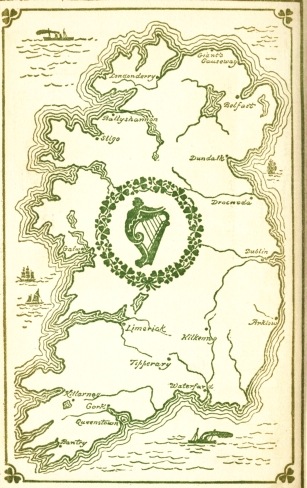
{308}
*** END OF THE PROJECT GUTENBERG EBOOK 46439 ***
![]() above the image, will bring up a larger version of the image.
above the image, will bring up a larger version of the image.


